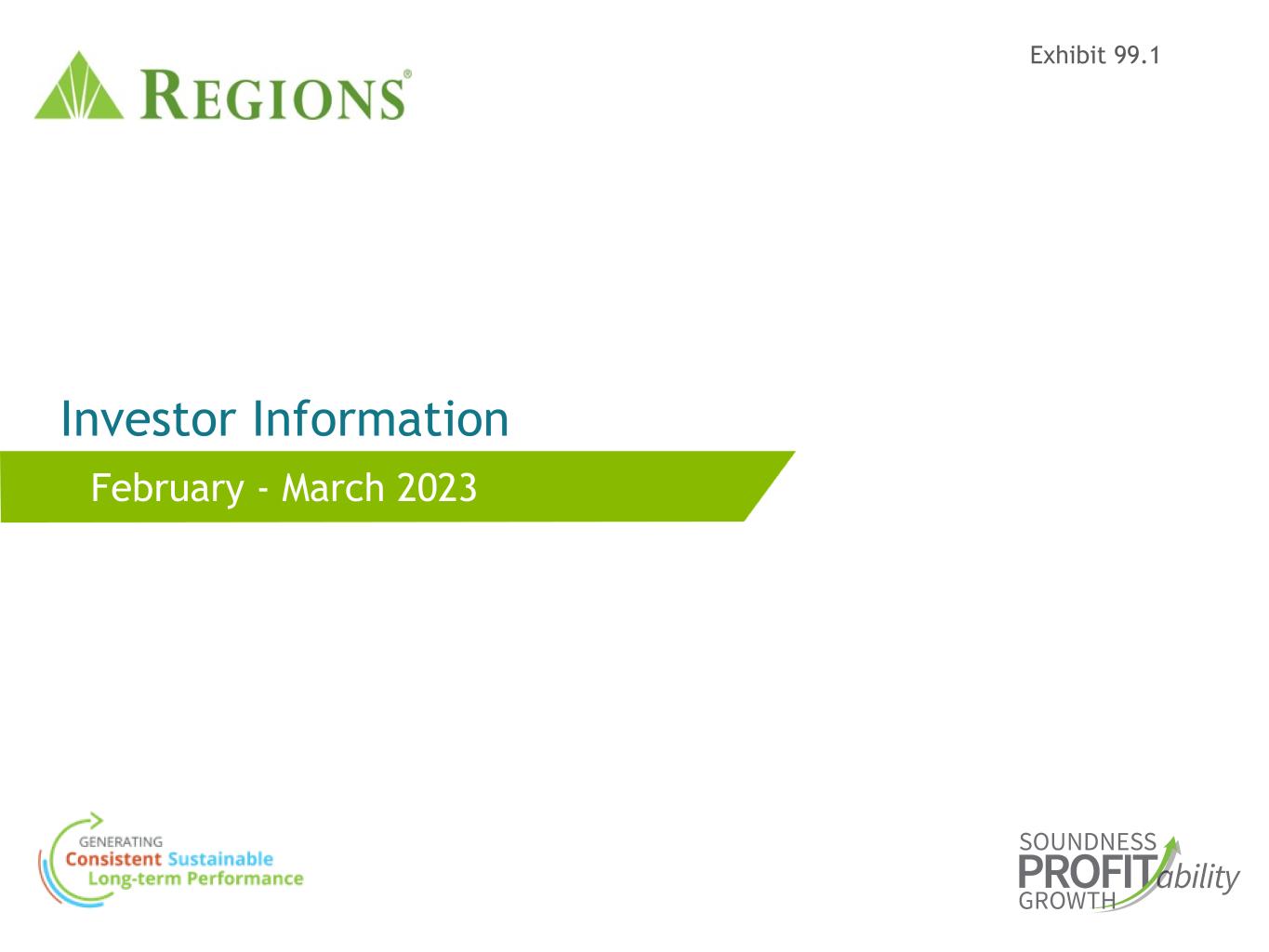
Investor Information February - March 2023 Exhibit 99.1
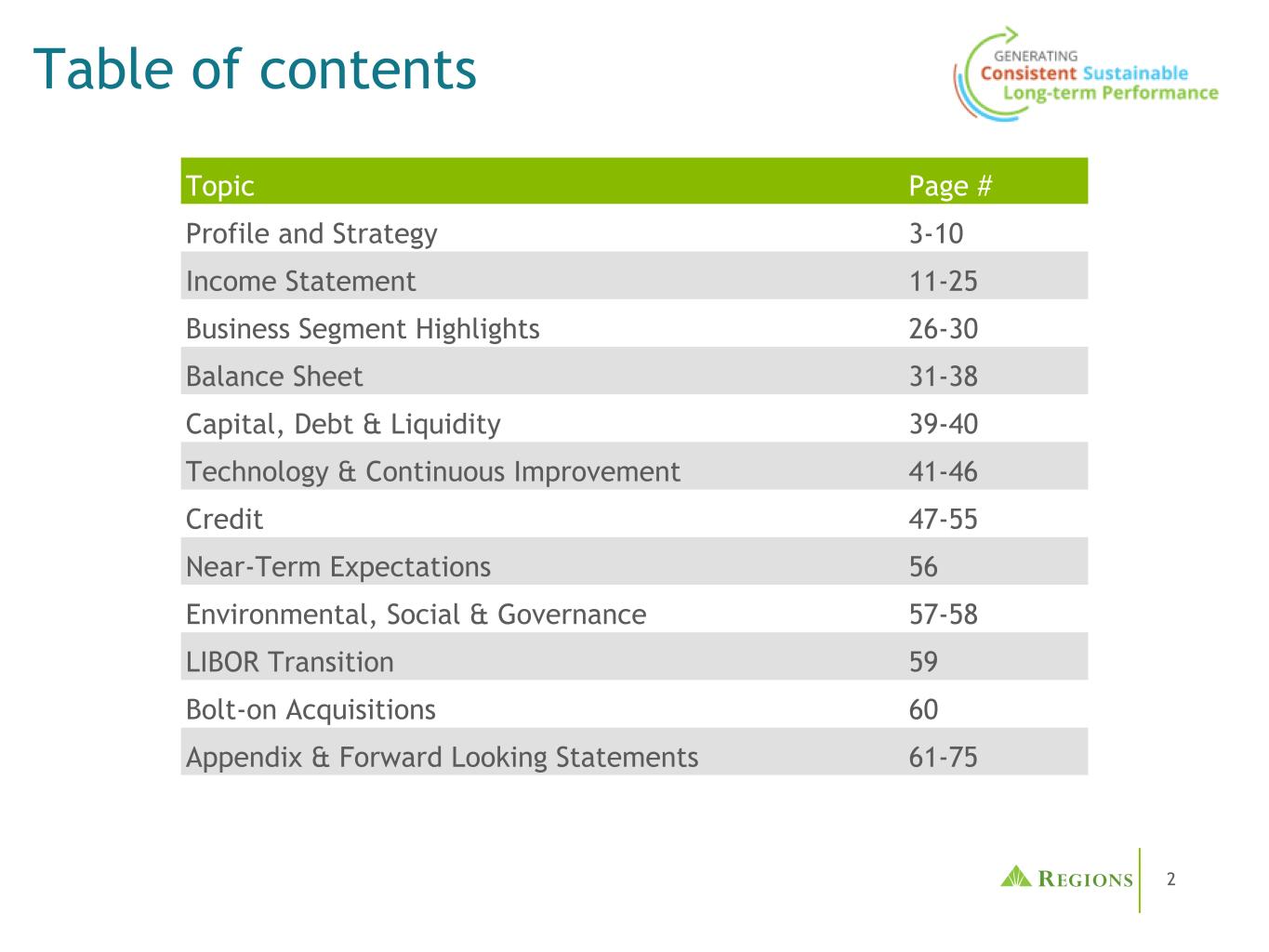
2 Table of contents Topic Page # Profile and Strategy 3-10 Income Statement 11-25 Business Segment Highlights 26-30 Balance Sheet 31-38 Capital, Debt & Liquidity 39-40 Technology & Continuous Improvement 41-46 Credit 47-55 Near-Term Expectations 56 Environmental, Social & Governance 57-58 LIBOR Transition 59 Bolt-on Acquisitions 60 Appendix & Forward Looking Statements 61-75
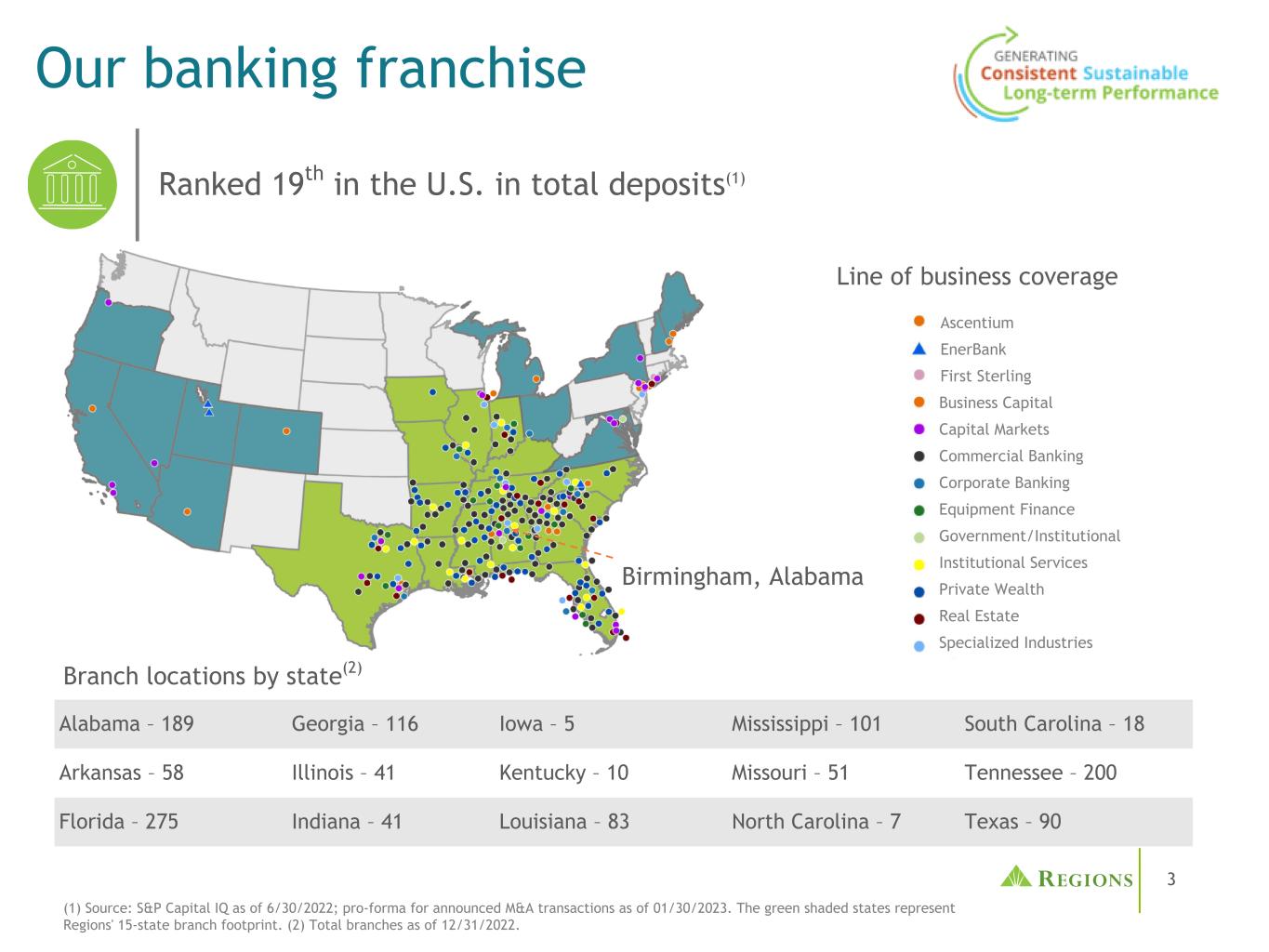
3 Line of business coverage Alabama – 189 Georgia – 116 Iowa – 5 Mississippi – 101 South Carolina – 18 Arkansas – 58 Illinois – 41 Kentucky – 10 Missouri – 51 Tennessee – 200 Florida – 275 Indiana – 41 Louisiana – 83 North Carolina – 7 Texas – 90 Ranked 19th in the U.S. in total deposits(1) Branch locations by state(2) Our banking franchise Birmingham, Alabama (1) Source: S&P Capital IQ as of 6/30/2022; pro-forma for announced M&A transactions as of 01/30/2023. The green shaded states represent Regions' 15-state branch footprint. (2) Total branches as of 12/31/2022. First Sterling Ascentium Business Capital Capital Markets Commercial Banking Corporate Banking Equipment Finance Government/Institutional Institutional Services Private Wealth Real Estate Specialized Industries EnerBank
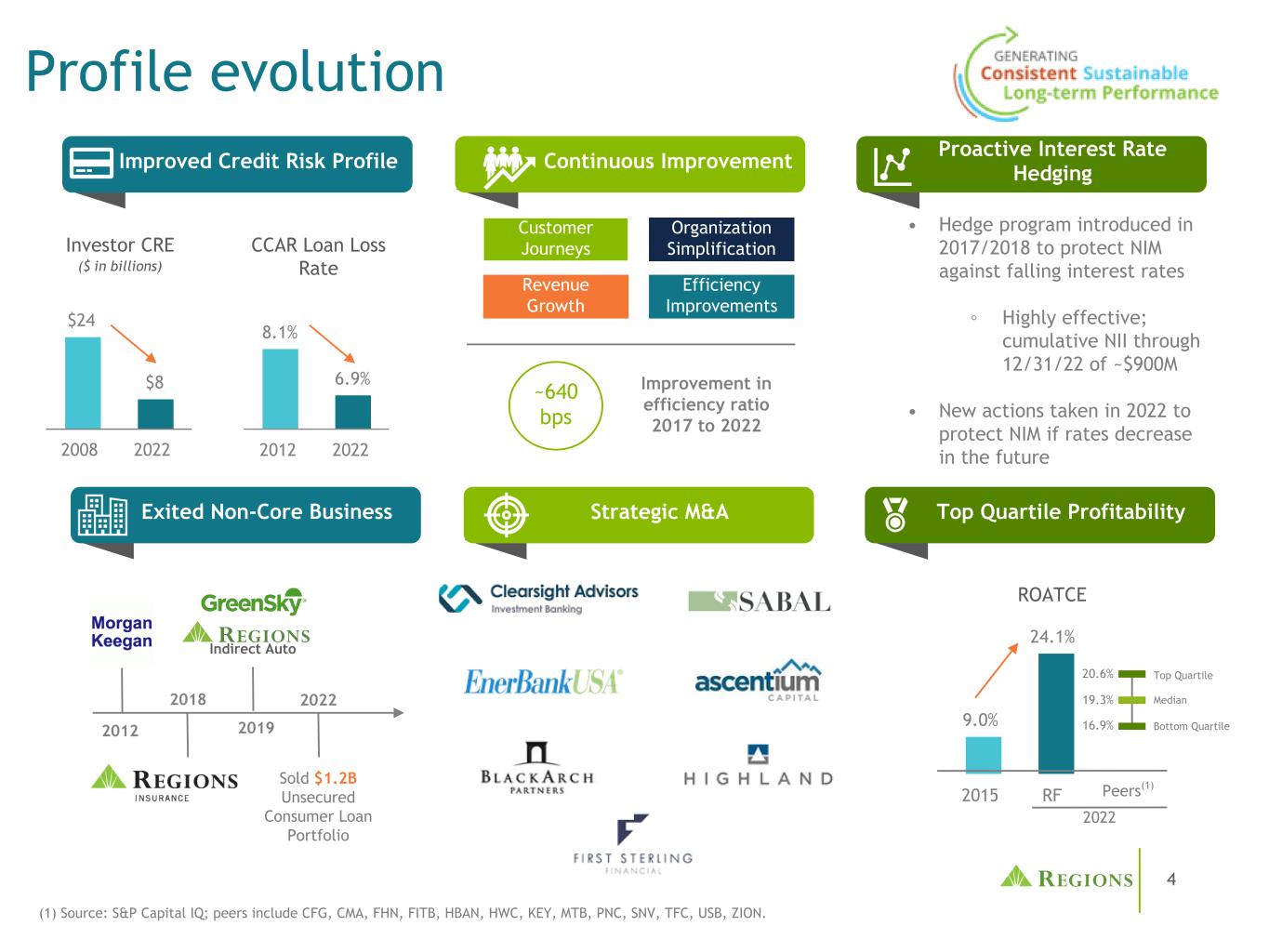
4 CCAR Loan Loss Rate Profile evolution Improved Credit Risk Profile Continuous Improvement Proactive Interest Rate Hedging Exited Non-Core Business Strategic M&A Top Quartile Profitability $24 $8 2008 2022 Investor CRE ($ in billions) 8.1% 6.9% 2012 2022 Customer Journeys Organization Simplification Revenue Growth Efficiency Improvements ~640 bps Improvement in efficiency ratio 2017 to 2022 • Hedge program introduced in 2017/2018 to protect NIM against falling interest rates ◦ Highly effective; cumulative NII through 12/31/22 of ~$900M • New actions taken in 2022 to protect NIM if rates decrease in the future 9.0% 24.1% 2015 RF ROATCE Indirect Auto 2012 2018 2019 2022 2022 Peers(1) (1) Source: S&P Capital IQ; peers include CFG, CMA, FHN, FITB, HBAN, HWC, KEY, MTB, PNC, SNV, TFC, USB, ZION. Bottom Quartile Median Top Quartile 16.9% 19.3% 20.6% Sold $1.2B Unsecured Consumer Loan Portfolio

5 Top market share plays a valuable role in the competitive landscape (1) Based on MSA and non-MSA counties using FDIC deposit data as of 6/30/2022; pro-forma for announced M&A transactions as of 01/30/2023. (2) Significant money center bank presence (JPM, BAC, C, WFC) defined as combined market share using 6/30/2022 FDIC deposit data of 20% or more. Markets with top 5 market share(1) MSAs Non-MSA counties • Ranked 19th in the U.S. in total deposits(1) • 86% of deposits in 7 states: Alabama, Tennessee, Florida, Louisiana, Mississippi, Georgia, Arkansas • Top 5 or better market share in ~70% of MSAs across 15-state footprint(1) • Greater than 2/3 of deposits in markets without a significant money center bank presence(2) • High growth markets benefiting from population and business growth: • Florida • Georgia • Texas • Tennessee

6 Strong in-market migration has converted legacy core markets into growth markets Serving Fast-Growing MSAs Deposits Market Rank(1) Nashville, Tennessee $10.7 3 Tampa, Florida $7.7 4 Atlanta, Georgia $6.1 7 Orlando, Florida $3.2 5 Knoxville, Tennessee $3.1 3 Huntsville, Alabama $2.6 1 Dallas/Ft Worth, Texas $2.6 19 Houston, Texas $2.1 17 Little Rock, AR $2.1 6 Indianapolis, Indiana $2.1 12 Chattanooga, Tennessee $1.8 3 Pensacola, Florida $1.7 1 Destin, Florida $1.5 1 Daphne, AL $1.4 1 Jacksonville, FL $1.2 9 National average: 2.1% '23-'28 Population Growth(1) 15 of Regions' top 25(1) MSAs are projected to grow faster than the U.S. national average (1) Source: S&P Capital IQ. Top 25 markets as defined by deposit dollars - FDIC 6/30/2022. Pro-forma for announced M&A transactions as of 1/30/2023. S&P's demographic data is provided by Claritas based primarily on U.S. Census data. (2) Source: U.S. Postal Service (for moves from January 2021 - December 2022). (3) Source: U.S. Bureau of Labor Statistics. 18 of top 25 U.S. markets with net migration inflows are within Regions' footprint(2) Regions' deposit weighted population growth by MSA for 2023-2028 is 2.9% vs. national average of 2.1%(1) Unemployment rates in 6 of our top 8 deposit states remain at or near all time lows(3)

7 Regions receives top honors Regions Bank recognized as a 2023 Top 10 Military Friendly Brand Regions Bank earned the Great Place to Work-Certified™ Company designation based on what current associates say about their experience working here Eight Years Strong: Regions Bank Again Named Gallup Exceptional Workplace Award Winner in 2022 Regions Bank Ranked Highest in Customer Satisfaction in J.D. Power 2022 U.S. Online Banking Satisfaction Study Among Regional Banks for the third year in a row Regions Bank named a Best Place to Work for LGBTQ+ Equality by Human Rights Campaign Foundation Regions Bank named a Best Place to Work for Disability Inclusion by the American Association for People with Disabilities and Disability:IN For the second year, Regions earned Gallup's Don Clifton Strengths-Based Culture Award, which recognized organizations in 2022 with workplace cultures that put the strengths of all associates at the core of how they collaborate, make decisions and work every day. Regions Financial named one of America’s most JUST Companies for third consecutive year

8 2022 overview Continue to generate consistent, sustainable long-term performance (1) Non-GAAP, see appendix for reconciliation. (2) Peer banks include: CFG, CMA, FHN, FITB, HBAN, HWC, KEY, MTB, SNV, PNC, TFC, USB, and ZION. Key Performance Metrics 4Q22 FY22 Reported Adjusted(1) Reported Adjusted(1) Net Income Available to Common Shareholders $660M $2.1B Diluted Earnings Per Share $0.70 $2.28 Total Revenue $2.0B $2.0B $7.2B $7.2B Non-Interest Expense $1.0B $1.0B $4.1B $3.9B Pre-Tax Pre-Provision Income(1) $984M $939M $3.1B $3.3B Efficiency Ratio 50.5% 51.6% 56.0% 53.9% Net-Charge Offs 0.29% 0.29% 0.29% 0.22% Highlights • Both reported and adjusted FY PPI(1) represent highest level on record • 4Q NII grew to a record $1.4B • Reported 4Q NIM increased 46 bps to 3.99%, highest level in last 15 years • Implemented additional OD policy enhancements benefiting customers • Asset sensitive profile supported strong QoQ margin expansion • Produced robust YTD average Commercial and Consumer loan growth • Continued focus on disciplined capital allocation and risk-adjusted returns • Top quartile returns on ROATCE(1) and 1 & 3 year TSR(2)

9 Regions' consistent outperformance Adjusted PPI(1) Less Adjusted Net Charge-offs(1) to RWA(2) Regions' earnings, including credit costs, have been top quartile for 10 straight quarters 1.70 2.16 2.33 2.29 2.33 2.44 2.23 2.19 2.54 2.68 2.76 1.74 1.73 1.74 1.86 1.97 1.91 1.78 1.63 1.89 2.28 2.23 RF Peer Median 2Q20 3Q20 4Q20 1Q21 2Q21 3Q21 4Q21 1Q22 2Q22 3Q22 4Q22 (1) Non-GAAP; see Appendix for reconciliation. The only period that includes adjusted charge-offs is 3Q22. (2) Source: S&P Capital IQ. Risk-weighted Assets (RWA) used in the analysis represents the simple average of 4Q22 and 3Q22 disclosed amounts (same process for prior quarters); estimates of 4Q22 RWA used for MTB, KEY and SNV. Peers include CFG, CMA, FHN, FITB, HBAN, HWC, KEY, MTB, PNC, SNV, TFC, USB, ZION.

10 ROATCE: Industry leading performance 9.0% 9.7% 11.0% 17.6% 14.9% 9.2% 21.4% 24.1% 12.0% 11.0% 12.0% 17.0% 14.7% 8.5% 16.5% 19.3% RF Peer Median 2015 2016 2017 2018 2019 2020 2021 2022 ROATCE Performance Trend vs. Peers(1) (1) Non-GAAP; see Appendix for reconciliation. Peers include CFG, CMA, FHN, FITB, HBAN, HWC, KEY, MTB, PNC, SNV, TFC, USB, ZION. The 2018 ROATCE for Regions was 15.6% excluding a $191M after-tax benefit from discontinued operations primarily related to a gain from the sale of Regions Insurance Group. Other historical periods were also impacted by discontinued operations but to an immaterial extent. RF's 2022 and 2021 ROATCE excluding AOCI (non-GAAP) was 19.61% and 22.85%, respectively. Rank: 1 Rank: 1
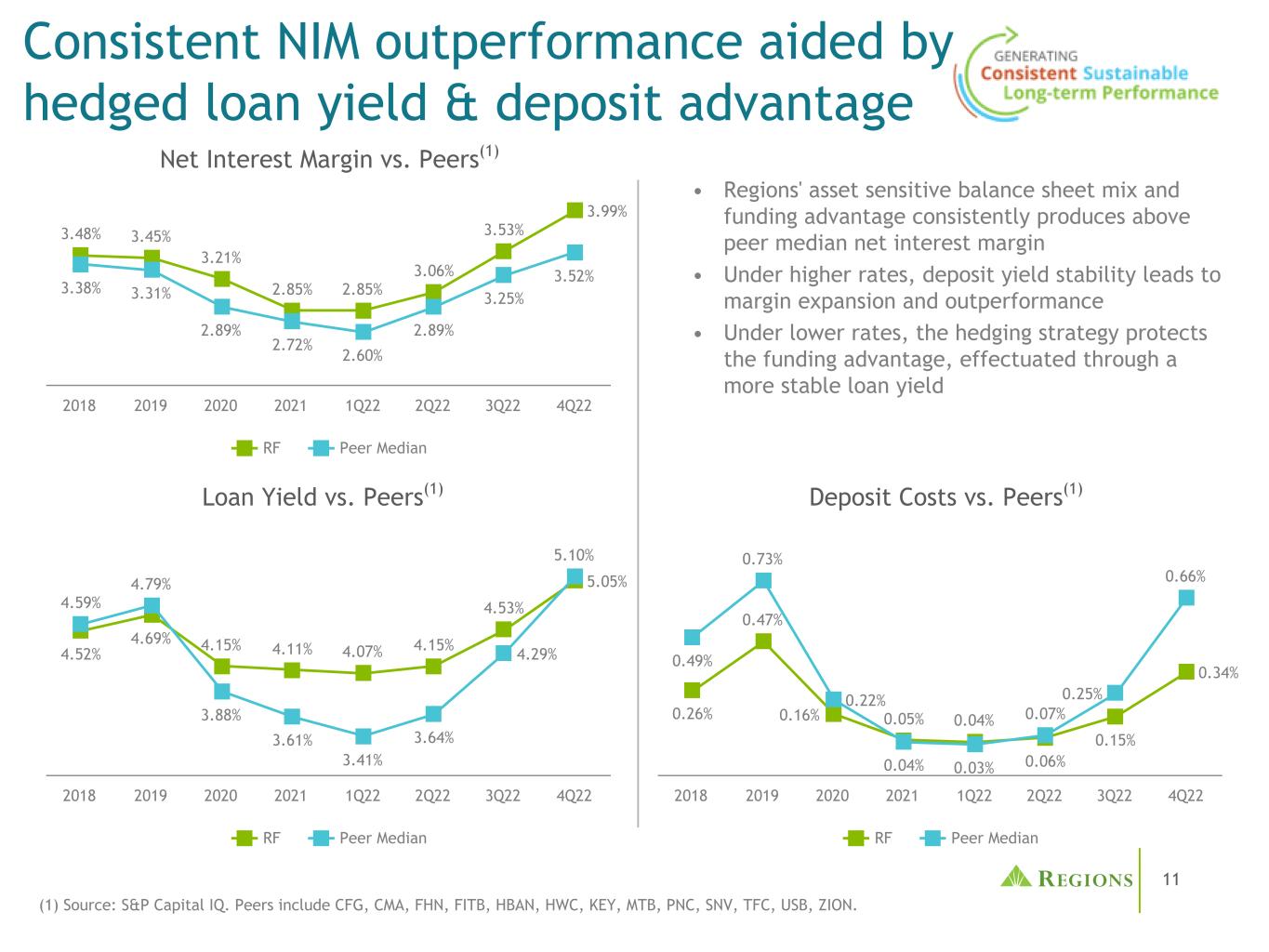
11 4.52% 4.69% 4.15% 4.11% 4.07% 4.15% 4.53% 5.05% 4.59% 4.79% 3.88% 3.61% 3.41% 3.64% 4.29% 5.10% RF Peer Median 2018 2019 2020 2021 1Q22 2Q22 3Q22 4Q22 Consistent NIM outperformance aided by hedged loan yield & deposit advantage (1) Source: S&P Capital IQ. Peers include CFG, CMA, FHN, FITB, HBAN, HWC, KEY, MTB, PNC, SNV, TFC, USB, ZION. Net Interest Margin vs. Peers(1) 3.48% 3.45% 3.21% 2.85% 2.85% 3.06% 3.53% 3.99% 3.38% 3.31% 2.89% 2.72% 2.60% 2.89% 3.25% 3.52% RF Peer Median 2018 2019 2020 2021 1Q22 2Q22 3Q22 4Q22 Loan Yield vs. Peers(1) • Regions' asset sensitive balance sheet mix and funding advantage consistently produces above peer median net interest margin • Under higher rates, deposit yield stability leads to margin expansion and outperformance • Under lower rates, the hedging strategy protects the funding advantage, effectuated through a more stable loan yield 0.26% 0.47% 0.16% 0.05% 0.04% 0.06% 0.15% 0.34% 0.49% 0.73% 0.22% 0.04% 0.03% 0.07% 0.25% 0.66% RF Peer Median 2018 2019 2020 2021 1Q22 2Q22 3Q22 4Q22 Deposit Costs vs. Peers(1)
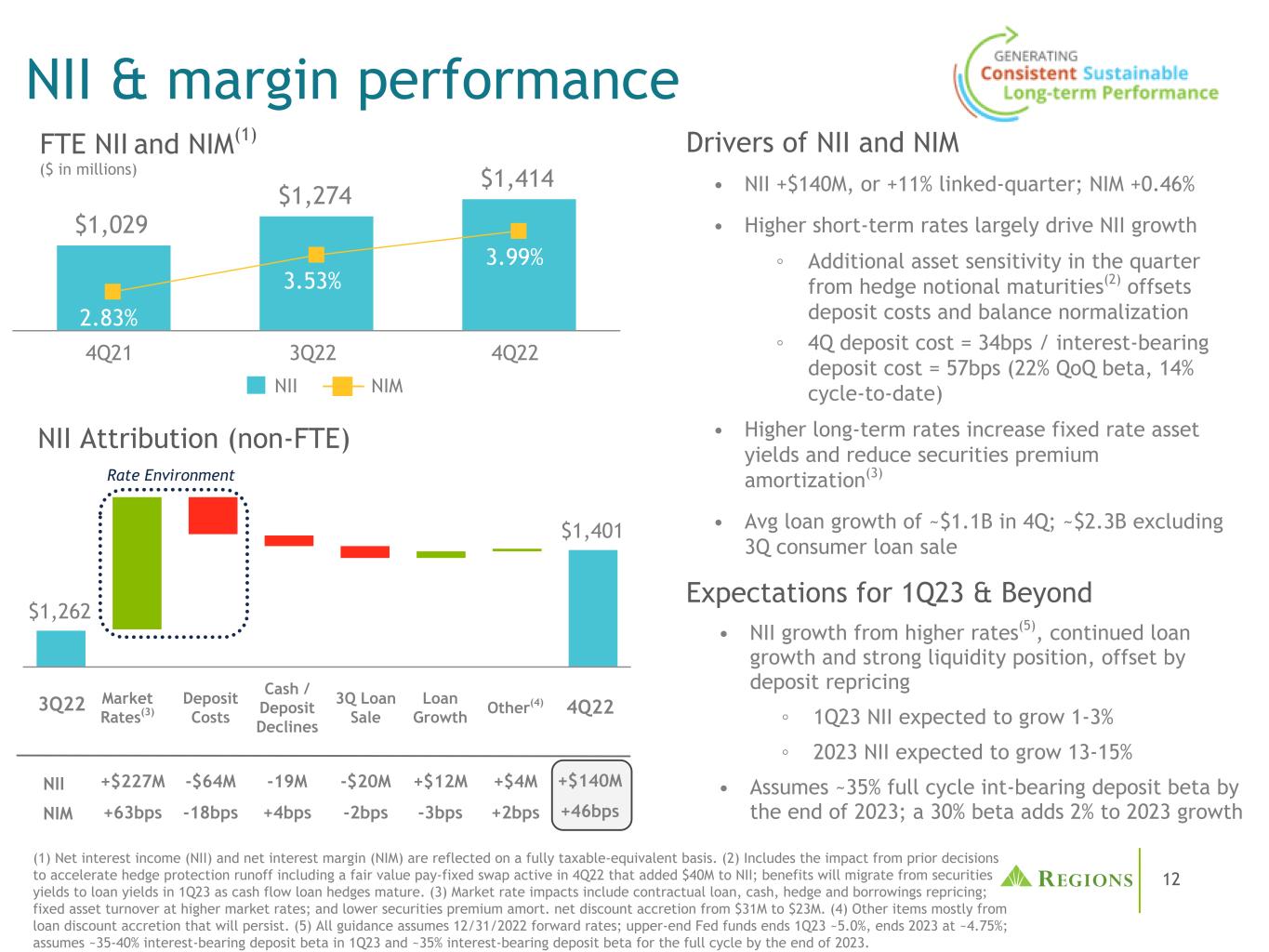
12 • NII +$140M, or +11% linked-quarter; NIM +0.46% • Higher short-term rates largely drive NII growth ◦ Additional asset sensitivity in the quarter from hedge notional maturities(2) offsets deposit costs and balance normalization ◦ 4Q deposit cost = 34bps / interest-bearing deposit cost = 57bps (22% QoQ beta, 14% cycle-to-date) • Higher long-term rates increase fixed rate asset yields and reduce securities premium amortization(3) • Avg loan growth of ~$1.1B in 4Q; ~$2.3B excluding 3Q consumer loan sale Market Rates(3) (1) Net interest income (NII) and net interest margin (NIM) are reflected on a fully taxable-equivalent basis. (2) Includes the impact from prior decisions to accelerate hedge protection runoff including a fair value pay-fixed swap active in 4Q22 that added $40M to NII; benefits will migrate from securities yields to loan yields in 1Q23 as cash flow loan hedges mature. (3) Market rate impacts include contractual loan, cash, hedge and borrowings repricing; fixed asset turnover at higher market rates; and lower securities premium amort. net discount accretion from $31M to $23M. (4) Other items mostly from loan discount accretion that will persist. (5) All guidance assumes 12/31/2022 forward rates; upper-end Fed funds ends 1Q23 ~5.0%, ends 2023 at ~4.75%; assumes ~35-40% interest-bearing deposit beta in 1Q23 and ~35% interest-bearing deposit beta for the full cycle by the end of 2023. $1,262 $1,401 NII Attribution (non-FTE) Drivers of NII and NIM 4Q22 3Q22 -18bps -3bps +2bps+63bps -$64M +$12M +$4M+$227MNII NIM NII & margin performance Other(4) -19M +4bps Rate Environment $1,029 $1,274 $1,414 2.83% 3.53% 3.99% 4Q21 3Q22 4Q22 Expectations for 1Q23 & Beyond • NII growth from higher rates(5), continued loan growth and strong liquidity position, offset by deposit repricing ◦ 1Q23 NII expected to grow 1-3% ◦ 2023 NII expected to grow 13-15% • Assumes ~35% full cycle int-bearing deposit beta by the end of 2023; a 30% beta adds 2% to 2023 growth NII FTE NII and NIM(1) ($ in millions) NIM Deposit Costs Cash / Deposit Declines 3Q Loan Sale Loan Growth -$20M -2bps +$140M +46bps

13 Floating 61% Fixed 39% Deposits 85% Borrowings 1% Other 3% Equity 10% • Balance sheet position naturally benefits from higher interest rates (i.e. asset sensitive), supported by ◦ Large floating rate loan and cash mix ◦ Large, stable deposit base and low reliance on wholesale borrowings • Have retained elevated cash balances to maximize flexibility and rate benefit ◦ Supports profitable loan growth ◦ Allows for potential surge deposit runoff ◦ No wholesale bank funding needs expected in the near term IB 57% NIB 39% Time 4% Loans 62%Securities 19% Cash 6% Other 13% Floating 47% Fixed (ex Hedges) 46% Fixed Hedges 7% $132B Loans(2)(3)(4) $97B Balance sheet profile (as of December 31, 2022) Portfolio Compositions $155B Assets(1) Liabilities & Equity $155B Wholesale Borrowings(2) $2B Deposits (1) Securities includes AFS, the unrealized AFS loss, and HTM securities; cash represents interest-bearing deposits held with the Federal Reserve. (2) Including spot starting balance sheet hedges as of 12/31/22; forward starting derivatives excluded. (3) ARM mortgage loans are included as floating rate loans. (4) Composition of floating rate loans: 26% LIBOR, 13% Prime, 53% SOFR, 8% BSBY.
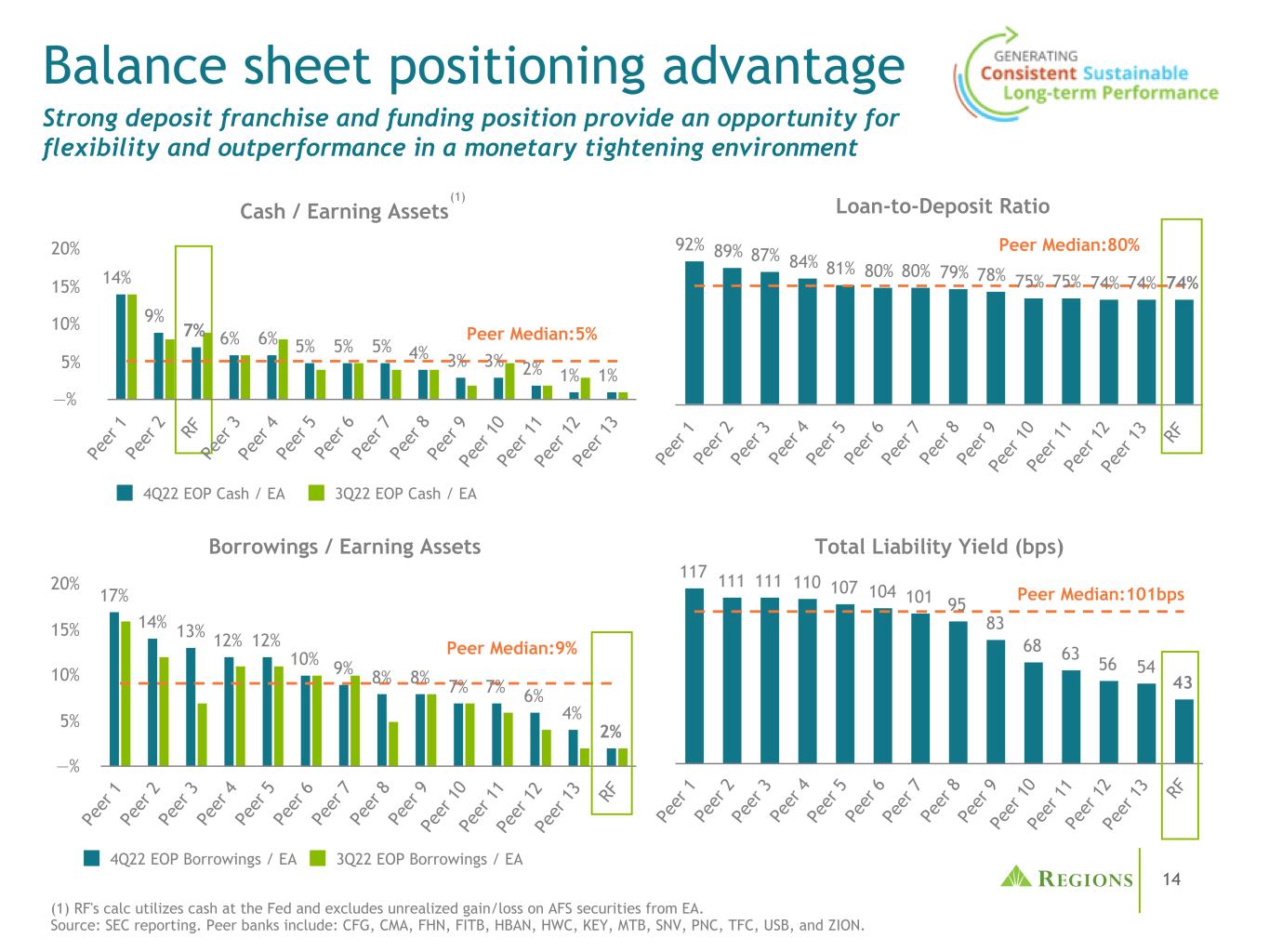
14 Balance sheet positioning advantage Strong deposit franchise and funding position provide an opportunity for flexibility and outperformance in a monetary tightening environment (1) RF's calc utilizes cash at the Fed and excludes unrealized gain/loss on AFS securities from EA. Source: SEC reporting. Peer banks include: CFG, CMA, FHN, FITB, HBAN, HWC, KEY, MTB, SNV, PNC, TFC, USB, and ZION. Loan-to-Deposit Ratio 92% 89% 87% 84% 81% 80% 80% 79% 78% 75% 75% 74% 74% 74% Pe er 1 Pe er 2 Pe er 3 Pe er 4 Pe er 5 Pe er 6 Pe er 7 Pe er 8 Pe er 9 Pe er 1 0 Pe er 1 1 Pe er 1 2 Pe er 1 3 RF Borrowings / Earning Assets 17% 14% 13% 12% 12% 10% 9% 8% 8% 7% 7% 6% 4% 2% 4Q22 EOP Borrowings / EA 3Q22 EOP Borrowings / EA Median Pe er 1 Pe er 2 Pe er 3 Pe er 4 Pe er 5 Pe er 6 Pe er 7 Pe er 8 Pe er 9 Pe er 1 0 Pe er 1 1 Pe er 1 2 Pe er 1 3 RF —% 5% 10% 15% 20% Peer Median:5% Peer Median:80% Peer Median:9% Total Liability Yield (bps) 117 111 111 110 107 104 101 95 83 68 63 56 54 43 Pe er 1 Pe er 2 Pe er 3 Pe er 4 Pe er 5 Pe er 6 Pe er 7 Pe er 8 Pe er 9 Pe er 1 0 Pe er 1 1 Pe er 1 2 Pe er 1 3 RF Peer Median:101bps Cash / Earning Assets 14% 9% 7% 6% 6% 5% 5% 5% 4% 3% 3% 2% 1% 1% 4Q22 EOP Cash / EA 3Q22 EOP Cash / EA Median Pe er 1 Pe er 2 RF Pe er 3 Pe er 4 Pe er 5 Pe er 6 Pe er 7 Pe er 8 Pe er 9 Pe er 1 0 Pe er 1 1 Pe er 1 2 Pe er 1 3 —% 5% 10% 15% 20% (1)
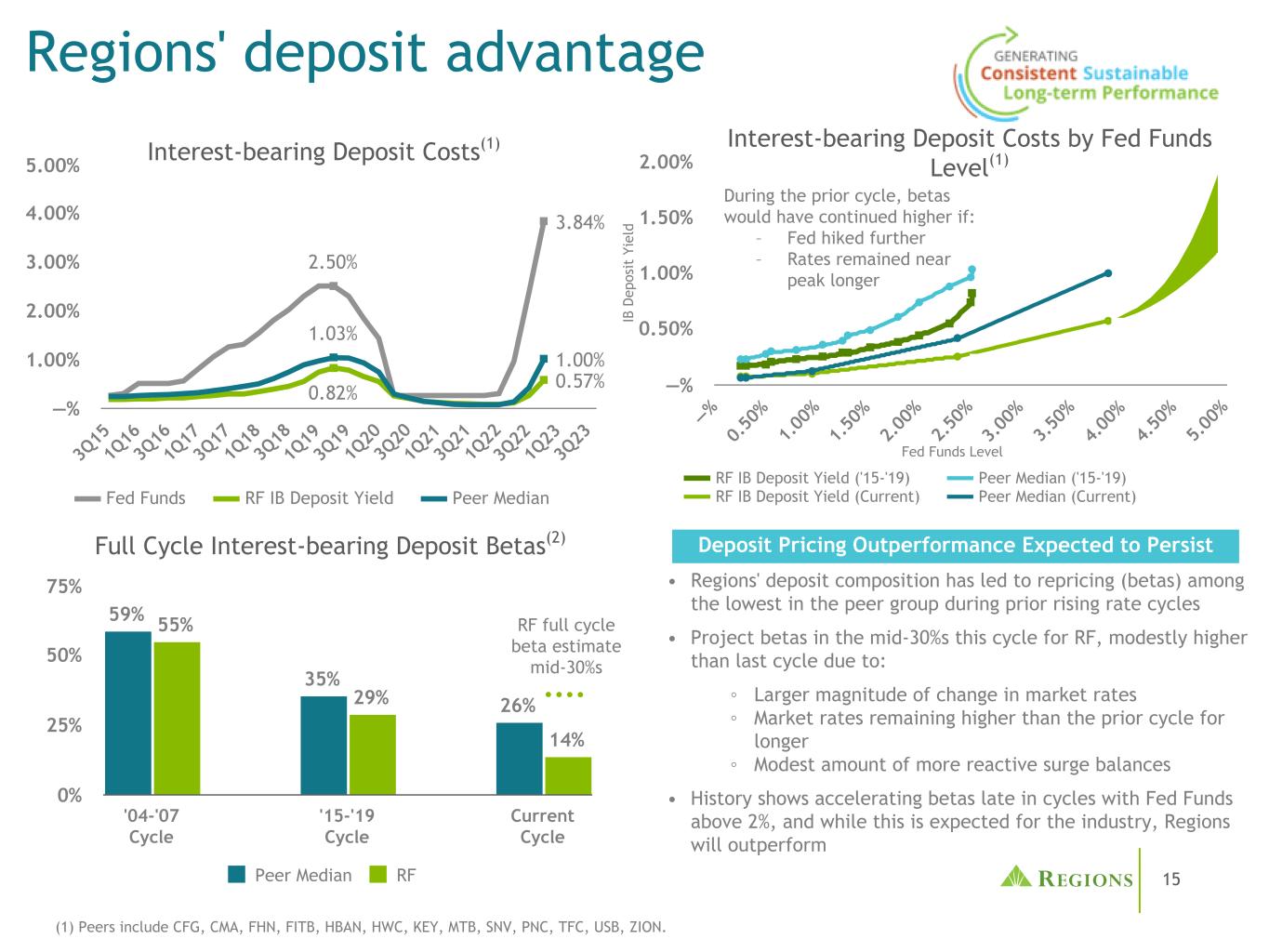
15 RF IB Deposit Yield ('15-'19) Peer Median ('15-'19) RF IB Deposit Yield (Current) Peer Median (Current) —% 0. 50 % 1. 00 % 1. 50 % 2. 00 % 2. 50 % 3. 00 % 3. 50 % 4. 00 % 4. 50 % 5. 00 % —% 0.50% 1.00% 1.50% 2.00% 2.50% 3.84% 0.82% 0.57% 1.03% 1.00% Fed Funds RF IB Deposit Yield Peer Median 3Q 15 1Q 16 3Q 16 1Q 17 3Q 17 1Q 18 3Q 18 1Q 19 3Q 19 1Q 20 3Q 20 1Q 21 3Q 21 1Q 22 3Q 22 1Q 23 3Q 23 —% 1.00% 2.00% 3.00% 4.00% 5.00% 59% 35% 26% 55% 29% 14% Peer Median RF '04-'07 Cycle '15-'19 Cycle Current Cycle 0% 25% 50% 75% (1) Peers include CFG, CMA, FHN, FITB, HBAN, HWC, KEY, MTB, SNV, PNC, TFC, USB, ZION. Regions' deposit advantage Deposit Pricing Outperformance Expected to Persist • Regions' deposit composition has led to repricing (betas) among the lowest in the peer group during prior rising rate cycles • Project betas in the mid-30%s this cycle for RF, modestly higher than last cycle due to: ◦ Larger magnitude of change in market rates ◦ Market rates remaining higher than the prior cycle for longer ◦ Modest amount of more reactive surge balances • History shows accelerating betas late in cycles with Fed Funds above 2%, and while this is expected for the industry, Regions will outperform Interest-bearing Deposit Costs(1) Full Cycle Interest-bearing Deposit Betas(2) RF full cycle beta estimate mid-30%s Interest-bearing Deposit Costs by Fed Funds Level(1) During the prior cycle, betas would have continued higher if: – Fed hiked further – Rates remained near peak longer IB D ep os it Y ie ld Fed Funds Level

16 Sensitivity to Long-Term Rates • ~$16B annual fixed rate loan production and securities reinvestment; mostly exposed to middle tenor rates • Reduced premium amortization from lower prepay speeds and lower purchase prices on monthly reinvestment Asset sensitive balance sheet Sensitivity to Short-Term Rates • ~54% floating rate loans excl. hedges; forward-starting hedge protection increases over the course of 2023 • Large, stable deposit funding base and historically low betas • Favorable cash and wholesale borrowings mix Net Interest Income Sensitivity Drivers Sensitivities projected to decrease over the next year from forward starting hedges and expected changes in deposit behavior (1) Parallel instantaneous shocks represent differences in NII over the next 12 months using the forward yield curve & base corporate forecast balance sheet guidance (2) Rising rate shock results include the impact of a deposit balance mix shift from non-interest bearing balances into interest-bearing (time deposits) over the 12 month measurement horizon Attractive long-term NIM range (3.60-4.00%); well-protected against lower rates Deposit Behavior Assumption Sensitivities +100bps scenario(1) Standard Assumption Assumption Shock Impact Forwards (Base) beta: mid-30s; Incremental up rate beta: ~40% above base +/- 5% beta -/+$40M -$3-5B in deposit runoff over 1H23 (all scenarios) +/-S1B additional deposit runoff -/+$26M Deposit mix shift(2): +$4B +/-S1B additional mix shift -/+$20M Balance Sheet Positioning • Forward starting hedging program used to reduce naturally asset sensitive profile (see following page) • Retaining modest asset sensitivity given uncertainty in macro environment & deposit performance • Constructed balance sheet profile with long-term NIM target range of between 3.60% and 4.00%; will be above the range until deposit betas normalize 12 month NII change from Forwards (Base) Parallel, Instantaneous Rate Shocks +$121M +$25 to $50M -$50 to -$75M -$222M Fwds (Base) 12/31/22(1) 12/31/2312 months beginning +100bps -100bps
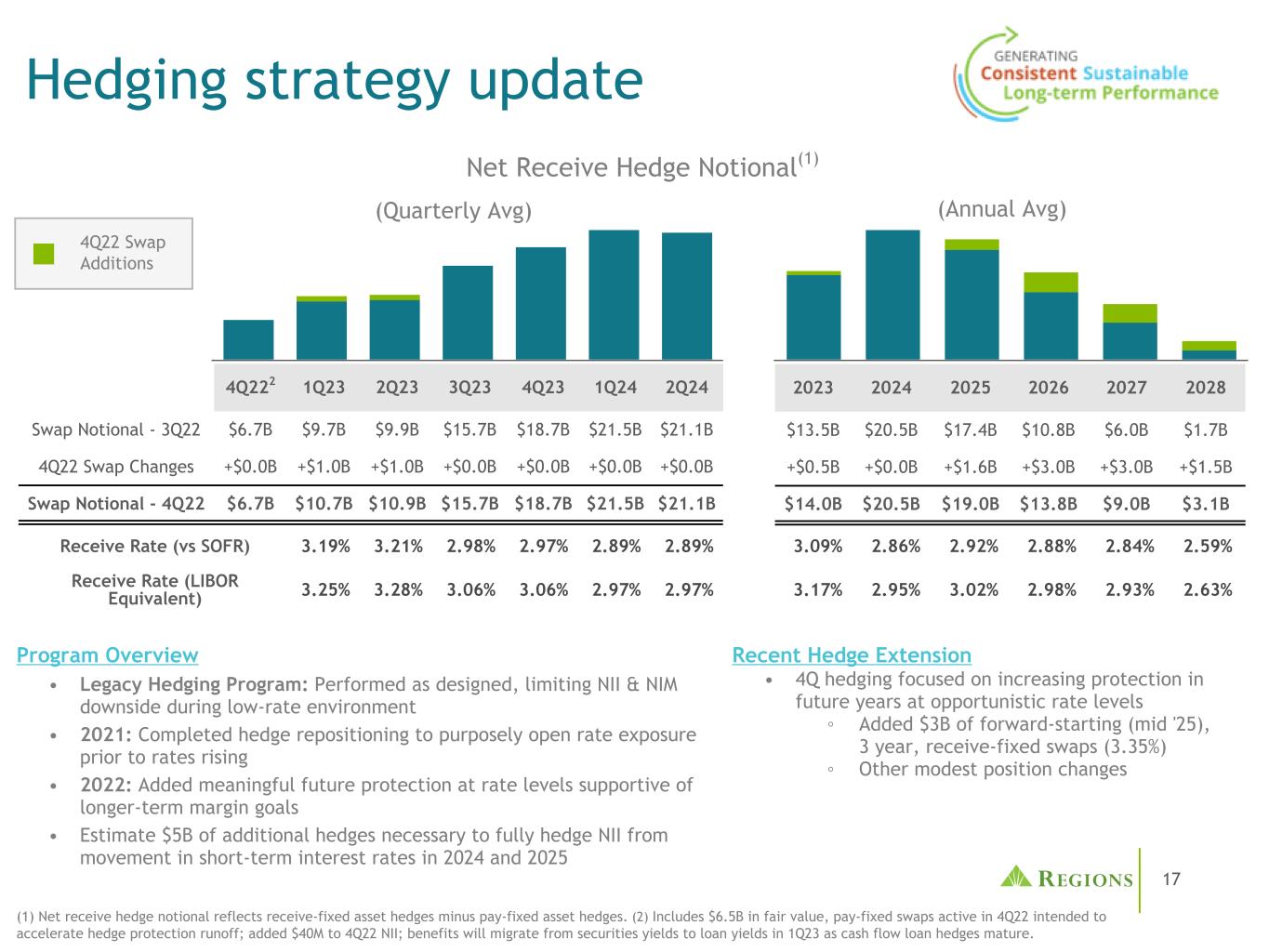
17 1 2 3 4 5 6 7 Program Overview • Legacy Hedging Program: Performed as designed, limiting NII & NIM downside during low-rate environment • 2021: Completed hedge repositioning to purposely open rate exposure prior to rates rising • 2022: Added meaningful future protection at rate levels supportive of longer-term margin goals • Estimate $5B of additional hedges necessary to fully hedge NII from movement in short-term interest rates in 2024 and 2025 Net Receive Hedge Notional(1) (1) Net receive hedge notional reflects receive-fixed asset hedges minus pay-fixed asset hedges. (2) Includes $6.5B in fair value, pay-fixed swaps active in 4Q22 intended to accelerate hedge protection runoff; added $40M to 4Q22 NII; benefits will migrate from securities yields to loan yields in 1Q23 as cash flow loan hedges mature. Hedging strategy update (Quarterly Avg) 1 2 3 4 5 62023 2024 2025 2026 2027 2028 $13.5B $20.5B $17.4B $10.8B $6.0B $1.7B +$0.5B +$0.0B +$1.6B +$3.0B +$3.0B +$1.5B $14.0B $20.5B $19.0B $13.8B $9.0B $3.1B 3.09% 2.86% 2.92% 2.88% 2.84% 2.59% 3.17% 2.95% 3.02% 2.98% 2.93% 2.63% (Annual Avg) Recent Hedge Extension • 4Q hedging focused on increasing protection in future years at opportunistic rate levels ◦ Added $3B of forward-starting (mid '25), 3 year, receive-fixed swaps (3.35%) ◦ Other modest position changes 4Q222 1Q23 2Q23 3Q23 4Q23 1Q24 2Q24 Swap Notional - 3Q22 $6.7B $9.7B $9.9B $15.7B $18.7B $21.5B $21.1B 4Q22 Swap Changes +$0.0B +$1.0B +$1.0B +$0.0B +$0.0B +$0.0B +$0.0B Swap Notional - 4Q22 $6.7B $10.7B $10.9B $15.7B $18.7B $21.5B $21.1B 4Q22 Swap Additions Receive Rate (vs SOFR) 3.19% 3.21% 2.98% 2.97% 2.89% 2.89% Receive Rate (LIBOR Equivalent) 3.25% 3.28% 3.06% 3.06% 2.97% 2.97%

18 • Portfolio constructed to protect against changes in market rates ◦ Duration of approximately 5 years as of 12/31/2022 (fully extended) provides offset to long-duration deposit book ◦ Reinvestment has favored bullet-like cash flows in 4Q, providing downside protection from lower rates ◦ ~36% of the securities in the portfolio are bullet-like (CMBS, corporate bonds, agency bullets, and USTs) ◦ MBS mix concentrated in less sensitive prepayment collateral types: lower loan balances, seasoning, and state-specific geographic concentrations • Reinvestment yield is ~2.00-2.15% above runoff yield • MBS-related book premium $486M as of 12/31/2022; higher market interest rates and prepayment protection should reduce amortization volatility Agency/UST 7% Agency MBS 60% Agency CMBS 28% Non-Agency CMBS 1% Corporate Bonds 4% Securities portfolio provides downside rate protection / liquidity Securities portfolio composition(1) $28.7B (1) Includes AFS, the unrealized AFS loss, and HTM securities as of 12/31/2022.

19 Adj. Non-Interest Income $615 $606 $550 4Q21 3Q22 4Q22 Change vs ($ in millions) 4Q22 3Q22 4Q21 Service charges $152 (2.6)% (8.4)% Card and ATM fees 130 3.2% 2.4% Capital markets (Ex CVA/DVA) 72 —% (13.3)% Capital markets - CVA/DVA (11) (152.4)% NM Wealth management income 108 —% 8.0% Mortgage income 24 (35.1)% (51.0)% Non-interest income NM - Not Meaningful (1) Non-GAAP; see appendix for reconciliation. (2) FY23 expectation includes an estimated impact for a grace period feature rolling out around mid-year 2023. • Expect full-year 2023 adjusted total revenue to be up 8-10% compared to 2022 QoQ highlights & outlook Total revenue outlook • 4Q reported NIR includes $50M of insurance proceeds related to 3Q regulatory settlement • Expect to offer a grace period feature in 2023 resulting in FY23 service charges of ~$550M(2) • Within capital markets, M&A fees increased offset by declines in all other categories ◦ Expect 1Q23 capital markets revenue in $60-$80M range ex. CVA/DVA with CVA/ DVA trending negative • Seasonally higher interchange and 3Q reward liability adj. that did not repeat drove card & ATM fees higher • Higher mortgage servicing income was offset by elevated interest rates & seasonally lower production drove total mortgage income lower • Wealth management continues to perform well despite market volatility and incremental YoY growth is expected Non-Interest Income $615 $605 $600 4Q21 3Q22 4Q22 ($ in millions) ($ in millions) (1)

20 Consumer 48% Wealth Management 20% Corporate 32% 4Q22 fee revenue by segment(1) Diversified non-interest income ($ in millions) • Consumer fee income categories include service charges on deposit accounts, card and ATM fees, and mortgage income generated through origination and servicing of residential mortgages Consumer Wealth Management • Wealth Management offers individuals, businesses, governmental institutions and non-profit entities a wide range of solutions to help protect, grow and transfer wealth • Fee offerings include trust and investment management, asset management, retirement and savings solutions and estate planning Corporate • Corporate fee income categories include capital markets and treasury management activities • Capital markets activities include capital raising, advisory and M&A services and mitigating risk with rate, commodity and foreign exchange products • Treasury management activities focus on delivering traditional cash management services, commercial card, and global trade products to client $600M (1) Pie %'s exclude the non-interest income from the Other Segment totaling $49 million.
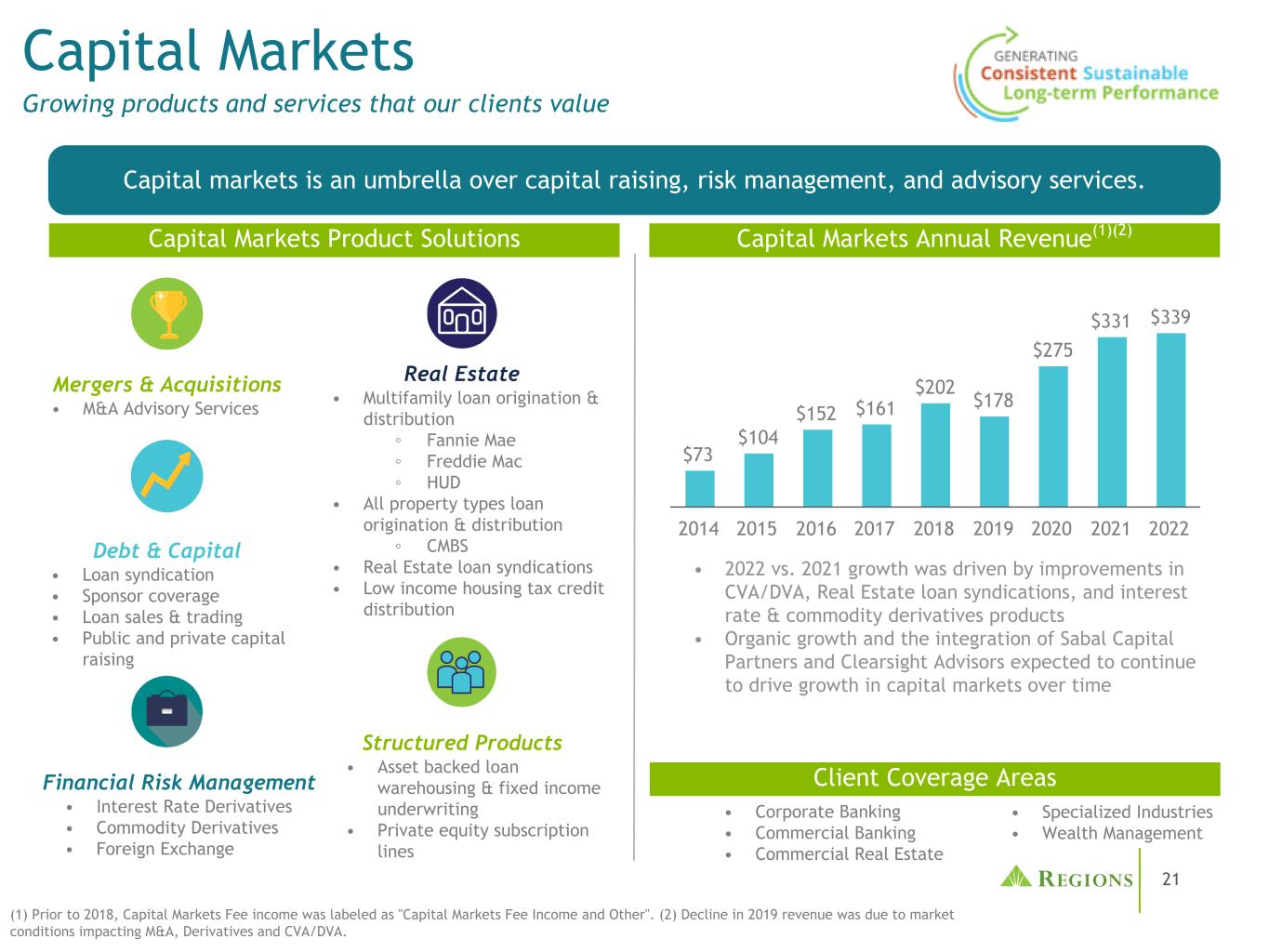
21 Capital Markets Growing products and services that our clients value Our associates delivered results • 2022 vs. 2021 growth was driven by improvements in CVA/DVA, Real Estate loan syndications, and interest rate & commodity derivatives products • Organic growth and the integration of Sabal Capital Partners and Clearsight Advisors expected to continue to drive growth in capital markets over time Capital markets is an umbrella over capital raising, risk management, and advisory services. Capital Markets Product Solutions Real Estate • Multifamily loan origination & distribution ◦ Fannie Mae ◦ Freddie Mac ◦ HUD • All property types loan origination & distribution ◦ CMBS • Real Estate loan syndications • Low income housing tax credit distribution Financial Risk Management • Interest Rate Derivatives • Commodity Derivatives • Foreign Exchange Debt & Capital • Loan syndication • Sponsor coverage • Loan sales & trading • Public and private capital raising Structured Products • Asset backed loan warehousing & fixed income underwriting • Private equity subscription lines Client Coverage Areas • Corporate Banking • Commercial Banking • Commercial Real Estate • Specialized Industries • Wealth Management Capital Markets Annual Revenue(1)(2) Mergers & Acquisitions • M&A Advisory Services (1) Prior to 2018, Capital Markets Fee income was labeled as "Capital Markets Fee Income and Other". (2) Decline in 2019 revenue was due to market conditions impacting M&A, Derivatives and CVA/DVA. $73 $104 $152 $161 $202 $178 $275 $331 $339 2014 2015 2016 2017 2018 2019 2020 2021 2022
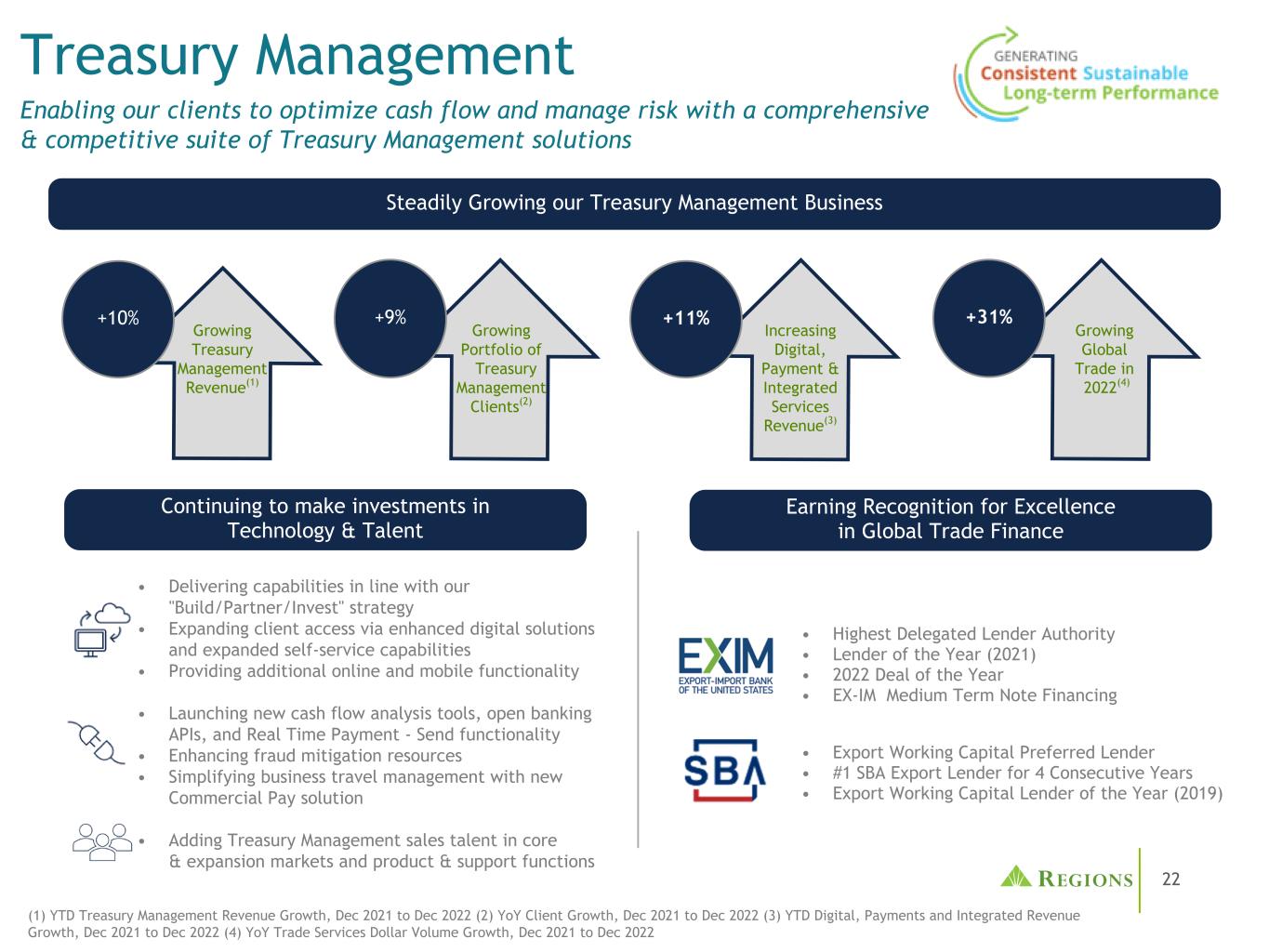
22 Treasury Management Enabling our clients to optimize cash flow and manage risk with a comprehensive & competitive suite of Treasury Management solutions • Export Working Capital Preferred Lender • #1 SBA Export Lender for 4 Consecutive Years • Export Working Capital Lender of the Year (2019) • Highest Delegated Lender Authority • Lender of the Year (2021) • 2022 Deal of the Year • EX-IM Medium Term Note Financing (1) YTD Treasury Management Revenue Growth, Dec 2021 to Dec 2022 (2) YoY Client Growth, Dec 2021 to Dec 2022 (3) YTD Digital, Payments and Integrated Revenue Growth, Dec 2021 to Dec 2022 (4) YoY Trade Services Dollar Volume Growth, Dec 2021 to Dec 2022 • Delivering capabilities in line with our "Build/Partner/Invest" strategy • Expanding client access via enhanced digital solutions and expanded self-service capabilities • Providing additional online and mobile functionality • Launching new cash flow analysis tools, open banking APIs, and Real Time Payment - Send functionality • Enhancing fraud mitigation resources • Simplifying business travel management with new Commercial Pay solution • Adding Treasury Management sales talent in core & expansion markets and product & support functions +9% +11% +31% Growing Portfolio of Treasury Management Clients(2) Increasing Digital, Payment & Integrated Services Revenue(3) Growing Global Trade in 2022(4) +10% Growing Treasury Management Revenue(1) Steadily Growing our Treasury Management Business Continuing to make investments in Technology & Talent Earning Recognition for Excellence in Global Trade Finance

23 Regions has made significant changes and upgrades while continuing to provide clients with resources needed to succeed in managing their finances. Details of Regions' Announcement(3): 1Q22-Eliminate overdraft protection transfer fees 2Q22-Reduce daily cap for overdraft occurrences to 3 2Q22-Eliminate all NSF fees 3Q22-Early access to direct deposit 3Q22-Small dollar LOC available for qualifying customers Deposit account policy changes Providing customers capabilities to be more financially sound Updated NSF/OD Policies $2,109 $2,379 2011 2012 2013 2014 2015 2016 2017 2018 2019 2020 2021 2022 Adjusted Non-Interest Income(1)(2) • NSF/OD fees have declined over $175M since 2011 while total adjusted NIR increased ~$270M over that same time period by growing & diversifying revenue through expanded fee-based services including: ◦ Mortgage ◦ Capital markets ◦ Wealth management ◦ Card & ATM • The enactment of Regulation E and debit interchange legislation had a combined $300M negative impact on Regions' fee income • Track record of consistent non-interest income growth Regions is committed to making banking easier for our customers. • Bank On certified Now Checking account • Simplified transaction posting order • Reduced fees • Customer education tools • Expansion of alert capabilities • Enhanced available balance views in digital channels • Intraday visibility of checks cleared Enhancements Product Features (1) Non-GAAP; see appendix for reconciliation. (2) 2011-2013 adj. NIR was not restated to exclude Regions Insurance revenue, which was moved to discontinued operations after 2018 divestiture. (3) For specific account details and eligibility requirements see "Regions Bank Announces New Steps to Reduce Overdraft Charges, Eliminate Non-Sufficient Funds Fees" press release dated January 19, 2022. ($ in millions) Future Enhancements - Expect to roll out a grace period feature around mid-year 2023

24 Industry purchase volume in 2022 declined modestly, while refinance activity fell dramatically in response to rising rates(1) Closed mortgage volume is estimated to be $1.9T in 2023 across the US(1) Continuing to focus on growing servicing through acquiring new MSRs Enhancing MLO execution to drive customer experience and improve cycle time 756 Avg. FICO 51% current LTV Exceeds market in percentage of purchase production volume at 88% in 4Q vs 83% for the industry(1) Mortgage remains a key component of fee revenue Investing For Growth Prime Portfolio Delivery Efficiency Mortgage Servicing Market Strength 23% lower origination and fulfillment cost than industry average(2) Omnichannel capabilities & partnership with retail bank create competitive advantage Servicing expense lower than peer average(2) $74B servicing portfolio(3) with capacity to grow to $100B+ (1) Mortgage Bankers Association – Jan 2023 Forecast. (2) MBA Stratmor (Spring 2022). (3) Includes residential owned portfolio and serviced for others.

25 $983 $1,170 $1,017 59.8% 62.3% 50.5% Non-interest expense Efficiency ratio 4Q21 3Q22 4Q22 • Non-interest expense decreased ~13% on a reported basis but increased ~2% on an adjusted basis(1) • Reported professional & legal exp. 4Q decline driven by charges related to 3Q regulatory settlement • Salaries & benefits increased ~2% due to 4Q increase in associate headcount and higher benefits expense ◦ Changed timing of annual merit process to 1Q from 2Q in '23; merit plus payroll tax reset will drive a ~$20M increase in 1Q23 vs 4Q22 • FY23 pension-related expense will increase Other NIE ~$40M attributable to increased interest cost due to higher rates & lower return on plan assets driven by changes in asset allocation • 4Q equipment & software exp. provides reasonable quarterly '23 run rate reflecting continued technology investments • '23 quarterly FDIC assessment expected to be ~$25M/ qtr reflecting increased base rate • Expect full-year 2023 adjusted non-interest expenses to increase 4.5-5.5% compared to 2022; expect 1H23 to be higher than 2H23 • Expect to generate ~4% adjusted operating leverage in 2023 $967 $988 $1,012 58.8% 52.6% 51.6% Adjusted non-interest expense Adjusted efficiency ratio 4Q21 3Q22 4Q22 $3,387 $3,419 $3,434 $3,443 $3,541 $3,698 $3,886 2016 2017 2018 2019 2020 2021 2022 Non-interest expense QoQ highlights & outlookAdj. Non-Interest Expense(1) ($ in millions) 2.3% CAGR (1) (1) Non-GAAP; see appendix for reconciliation. (2) Adjusted NIE in 2020-2022 were impacted by 2Q20 acquisition of Ascentium Capital and 4Q21 acquisitions of EnerBank, Sabal Capital Partners, and ClearSight Advisors. (1) Non-Interest Expense ($ in millions) Adj. Non-Interest Expense(1)(2) ($ in millions)

26 43% 50% 7% 64% 34% 2% 29% 63% 7% 1% $984M $96B $133B 4Q22 Pre-tax pre- provision income(1) 4Q22 Average deposits 4Q22 Average loans (1) Pie %'s exclude the pre-tax pre-provision income from the Other Segment totaling $39 million. Business segments Consumer Corporate Wealth Management Other

27 (1) December 2022 vs 2021. (2) Quality Relationships defined as having a cumulative $500K in loans, deposits and IM&T accounts, revenue per Quality Relationship measured over TTM, Nov '22 vs Dec '21. (3) Retention of IM&T revenue vs baseline. Investments in our businesses Investments in talent, technology and strategic acquisitions continue to pay off CORPORATE CONSUMER WEALTH Mobile users increased 5.7% YoY Growth in revenue per quality relationship(2) of 14.5% Sabal closed +$730M loans in 2022, FNMA small balance origination volume doubled Better use of data contributing to strong PWM retention rate(3) of 93% Industry leading Customer Satisfaction and primacy levels 40% of all PWM Clients have a Wealth Plan, allowing us to help them focus on their unique goals Ascentium Capital experienced record 2022 loan production, up 25% YoY Completed $13B UPB MSRs bulk purchases & continue to purchase MSRs on a flow basis Upgraded mortgage contact relationship management platform EnerBank generating high quality loans; synergy work ongoing Investment Services average monthly revenue up 17%, over PY Strong Client Satisfaction and Associate Engagement scores Record 2022 non-interest income reflecting growth of 9.2% vs PY Treasury Management client base grew 9% YoY(1); 2022 Revenue grew 10% achieving new record Significantly improved closing time on home equity productsMigrated iTreasury to modern platform & launched Real-Time Payment send capabilities Top talent acquisition in key areas: SBA, Franchise, New Markets Tax Credits & Equip. Finance Enhanced origination productivity: BUILT, Blooma, & nCino; Continued expansion of Regions Client IQ (RCLIQ)
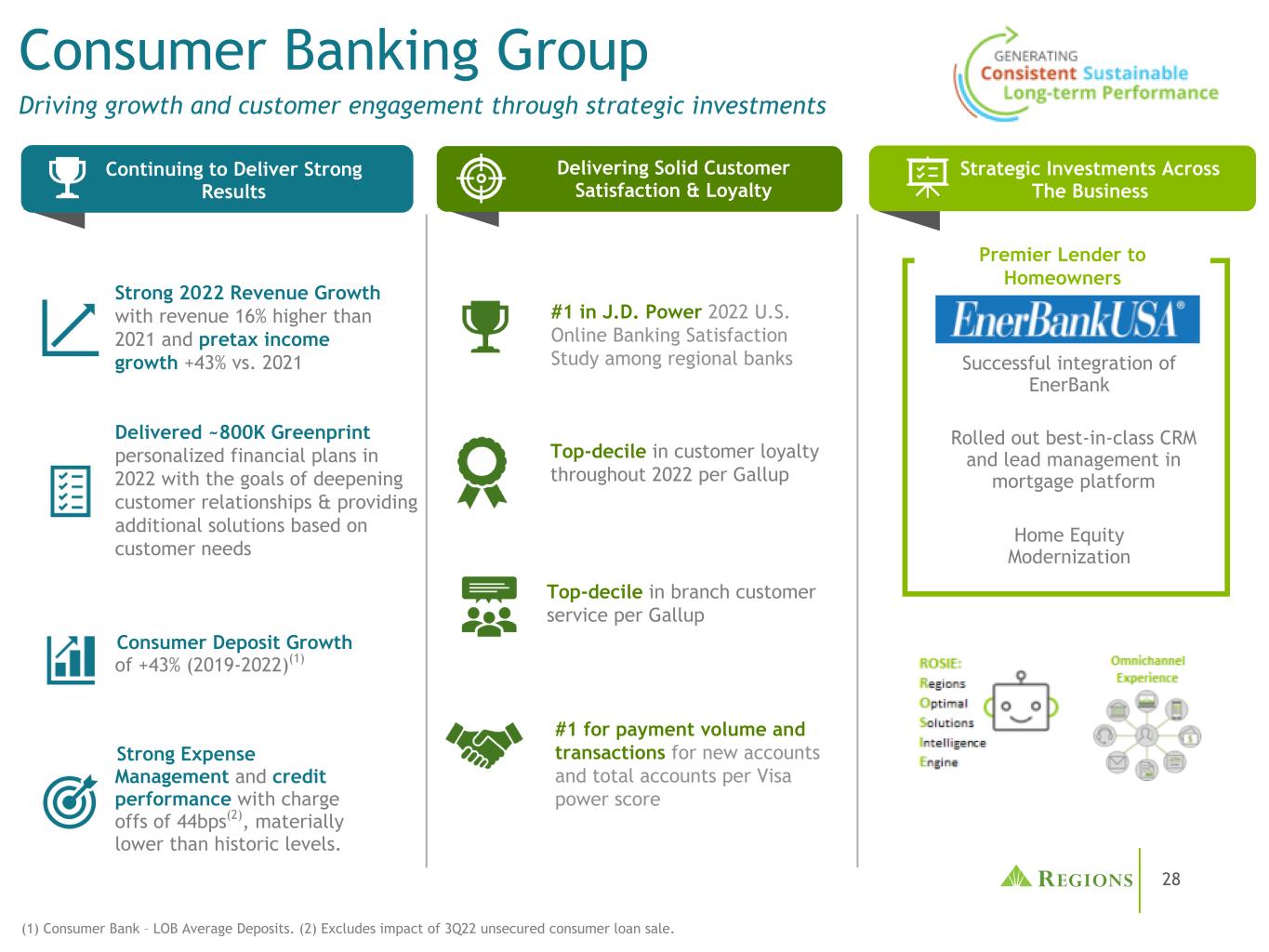
28 (1) Consumer Bank – LOB Average Deposits. (2) Excludes impact of 3Q22 unsecured consumer loan sale. Consumer Banking Group Driving growth and customer engagement through strategic investments Continuing to Deliver Strong Results Delivered ~800K Greenprint personalized financial plans in 2022 with the goals of deepening customer relationships & providing additional solutions based on customer needs Consumer Deposit Growth of +43% (2019-2022)(1) Premier Lender to Homeowners Home Equity Modernization Strong Expense Management and credit performance with charge offs of 44bps(2), materially lower than historic levels. Successful integration of EnerBank Delivering Solid Customer Satisfaction & Loyalty Strategic Investments Across The Business Rolled out best-in-class CRM and lead management in mortgage platform Strong 2022 Revenue Growth with revenue 16% higher than 2021 and pretax income growth +43% vs. 2021 Top-decile in customer loyalty throughout 2022 per Gallup #1 for payment volume and transactions for new accounts and total accounts per Visa power score #1 in J.D. Power 2022 U.S. Online Banking Satisfaction Study among regional banks Top-decile in branch customer service per Gallup
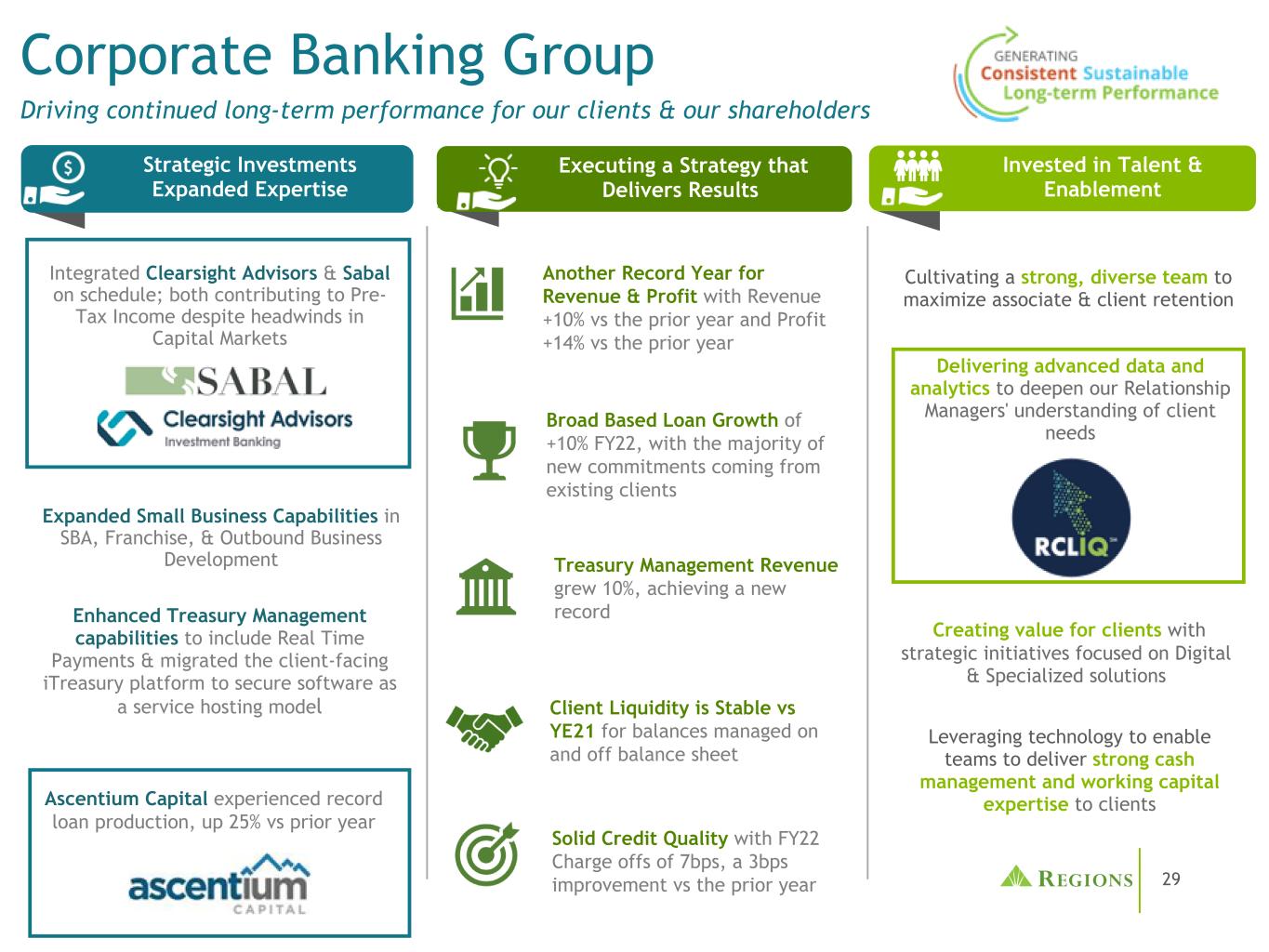
29 Corporate Banking Group Driving continued long-term performance for our clients & our shareholders Strategic Investments Expanded Expertise Solid Credit Quality with FY22 Charge offs of 7bps, a 3bps improvement vs the prior year Ascentium Capital experienced record loan production, up 25% vs prior year Integrated Clearsight Advisors & Sabal on schedule; both contributing to Pre- Tax Income despite headwinds in Capital Markets Executing a Strategy that Delivers Results Invested in Talent & Enablement Enhanced Treasury Management capabilities to include Real Time Payments & migrated the client-facing iTreasury platform to secure software as a service hosting model Another Record Year for Revenue & Profit with Revenue +10% vs the prior year and Profit +14% vs the prior year Client Liquidity is Stable vs YE21 for balances managed on and off balance sheet Expanded Small Business Capabilities in SBA, Franchise, & Outbound Business Development Cultivating a strong, diverse team to maximize associate & client retention Delivering advanced data and analytics to deepen our Relationship Managers' understanding of client needs Broad Based Loan Growth of +10% FY22, with the majority of new commitments coming from existing clients Creating value for clients with strategic initiatives focused on Digital & Specialized solutions Treasury Management Revenue grew 10%, achieving a new record Leveraging technology to enable teams to deliver strong cash management and working capital expertise to clients
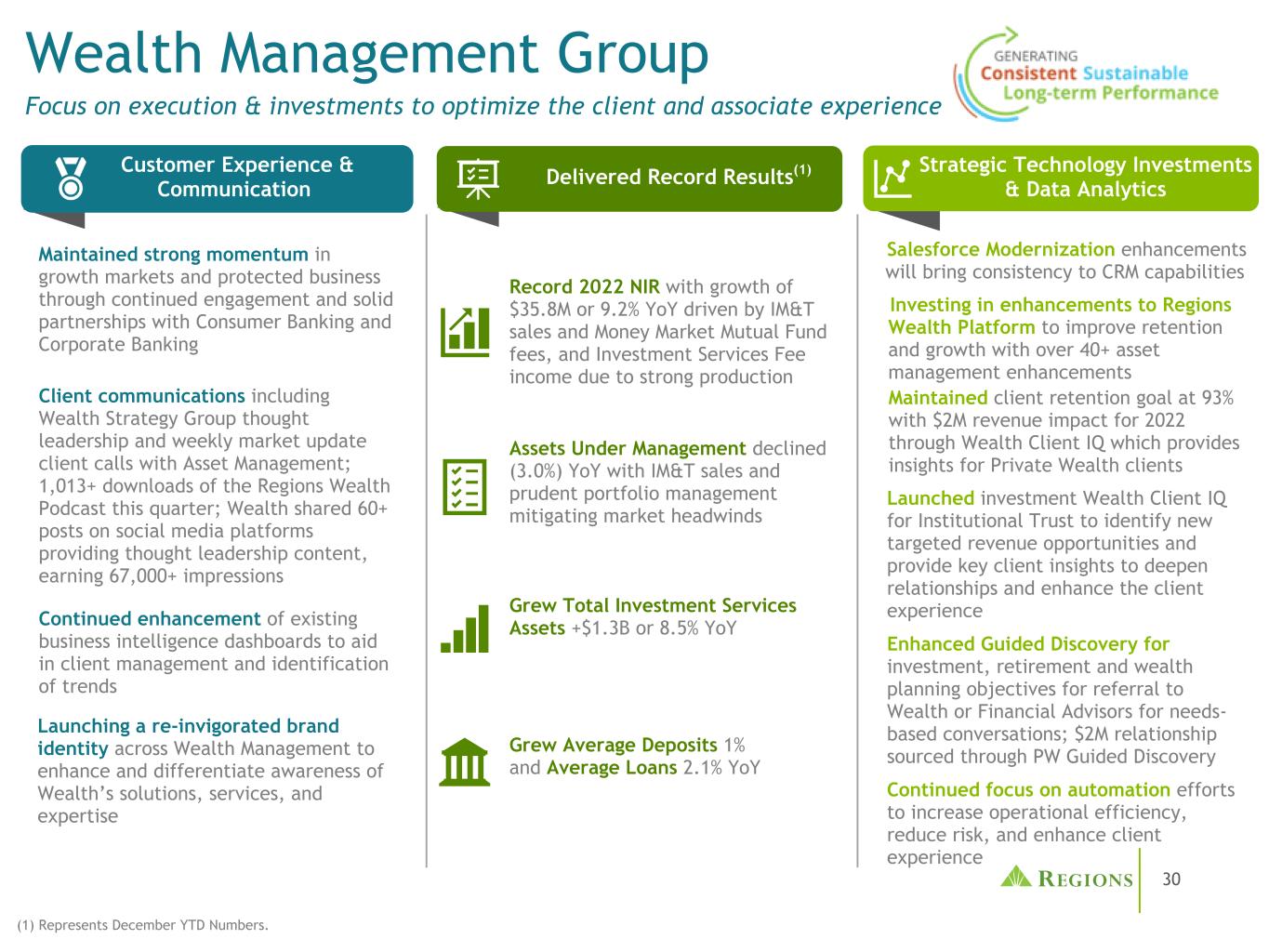
30 (1) Represents December YTD Numbers. Wealth Management Group Focus on execution & investments to optimize the client and associate experience Continued enhancement of existing business intelligence dashboards to aid in client management and identification of trends Customer Experience & Communication Maintained strong momentum in growth markets and protected business through continued engagement and solid partnerships with Consumer Banking and Corporate Banking Record 2022 NIR with growth of $35.8M or 9.2% YoY driven by IM&T sales and Money Market Mutual Fund fees, and Investment Services Fee income due to strong production Delivered Record Results(1) Strategic Technology Investments & Data Analytics Maintained client retention goal at 93% with $2M revenue impact for 2022 through Wealth Client IQ which provides insights for Private Wealth clients Assets Under Management declined (3.0%) YoY with IM&T sales and prudent portfolio management mitigating market headwinds Grew Total Investment Services Assets +$1.3B or 8.5% YoY Salesforce Modernization enhancements will bring consistency to CRM capabilities Investing in enhancements to Regions Wealth Platform to improve retention and growth with over 40+ asset management enhancements Grew Average Deposits 1% and Average Loans 2.1% YoY Client communications including Wealth Strategy Group thought leadership and weekly market update client calls with Asset Management; 1,013+ downloads of the Regions Wealth Podcast this quarter; Wealth shared 60+ posts on social media platforms providing thought leadership content, earning 67,000+ impressions Launched investment Wealth Client IQ for Institutional Trust to identify new targeted revenue opportunities and provide key client insights to deepen relationships and enhance the client experience Launching a re-invigorated brand identity across Wealth Management to enhance and differentiate awareness of Wealth’s solutions, services, and expertise Continued focus on automation efforts to increase operational efficiency, reduce risk, and enhance client experience Enhanced Guided Discovery for investment, retirement and wealth planning objectives for referral to Wealth or Financial Advisors for needs- based conversations; $2M relationship sourced through PW Guided Discovery
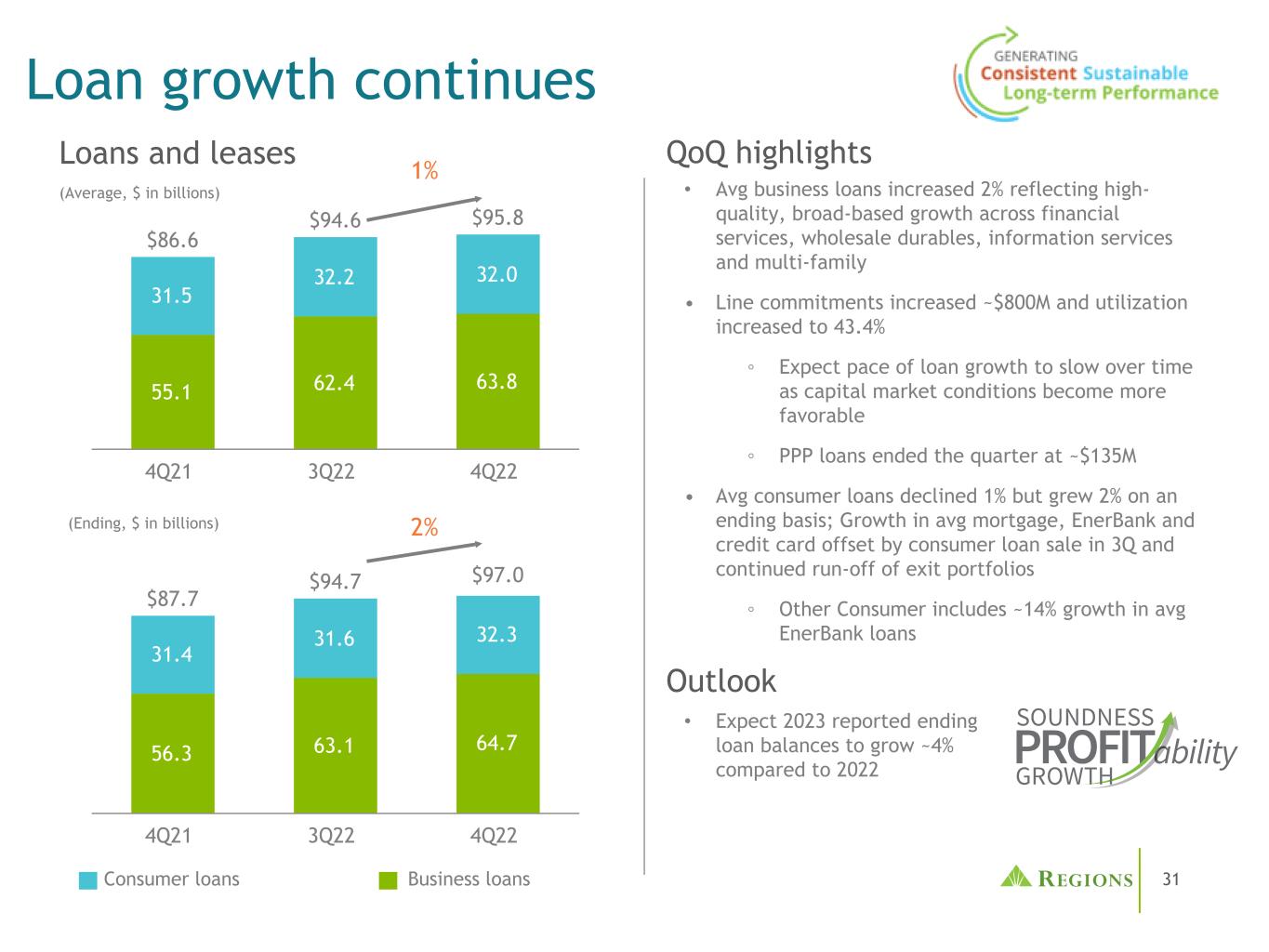
31 • Avg business loans increased 2% reflecting high- quality, broad-based growth across financial services, wholesale durables, information services and multi-family • Line commitments increased ~$800M and utilization increased to 43.4% ◦ Expect pace of loan growth to slow over time as capital market conditions become more favorable ◦ PPP loans ended the quarter at ~$135M • Avg consumer loans declined 1% but grew 2% on an ending basis; Growth in avg mortgage, EnerBank and credit card offset by consumer loan sale in 3Q and continued run-off of exit portfolios ◦ Other Consumer includes ~14% growth in avg EnerBank loans Loan growth continues $87.7 $94.7 $97.0 56.3 63.1 64.7 31.4 31.6 32.3 4Q21 3Q22 4Q22 (Ending, $ in billions) $86.6 $94.6 $95.8 55.1 62.4 63.8 31.5 32.2 32.0 4Q21 3Q22 4Q22 Loans and leases (Average, $ in billions) Business loansConsumer loans 1% 2% QoQ highlights • Expect 2023 reported ending loan balances to grow ~4% compared to 2022 Outlook

32 $50.1 $5.1 $0.3 $6.4 $1.9 Commercial and Industrial CRE Mortgage - OO CRE Construction - OO IRE - Mortgage IRE - Construction 4Q22 Average loan composition $18.6 $6.0 $5.6 $0.6 $1.2 Mortgage Home Equity Other Consumer Other Consumer - Exit Portfolios Consumer Credit Card Average consumer loans $32.0B Average business loans $63.8B ($ in billions)($ in billions)
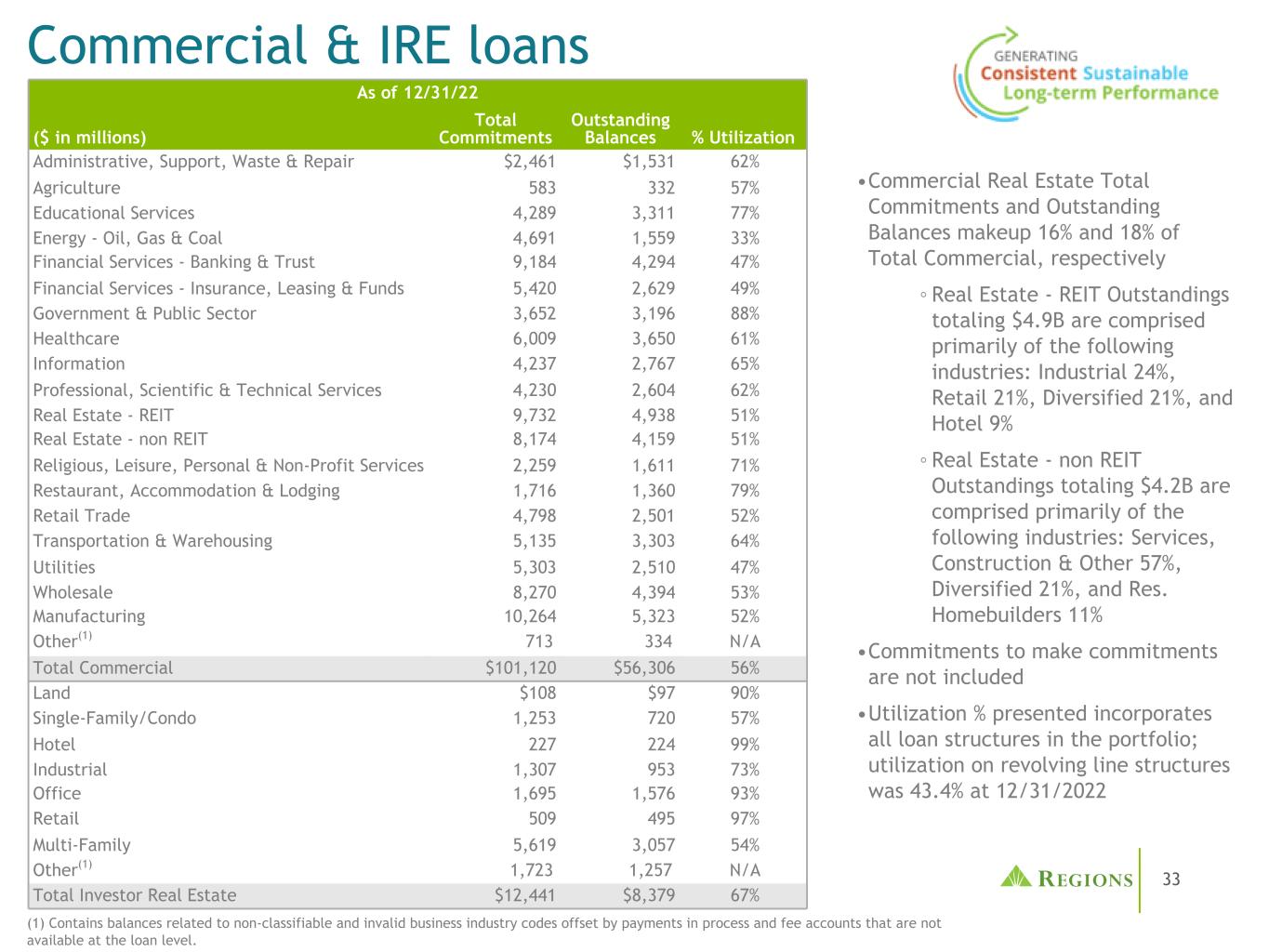
33 Commercial & IRE loans As of 12/31/22 ($ in millions) Total Commitments Outstanding Balances % Utilization Administrative, Support, Waste & Repair $2,461 $1,531 62% Agriculture 583 332 57% Educational Services 4,289 3,311 77% Energy - Oil, Gas & Coal 4,691 1,559 33% Financial Services - Banking & Trust 9,184 4,294 47% Financial Services - Insurance, Leasing & Funds 5,420 2,629 49% Government & Public Sector 3,652 3,196 88% Healthcare 6,009 3,650 61% Information 4,237 2,767 65% Professional, Scientific & Technical Services 4,230 2,604 62% Real Estate - REIT 9,732 4,938 51% Real Estate - non REIT 8,174 4,159 51% Religious, Leisure, Personal & Non-Profit Services 2,259 1,611 71% Restaurant, Accommodation & Lodging 1,716 1,360 79% Retail Trade 4,798 2,501 52% Transportation & Warehousing 5,135 3,303 64% Utilities 5,303 2,510 47% Wholesale 8,270 4,394 53% Manufacturing 10,264 5,323 52% Other(1) 713 334 N/A Total Commercial $101,120 $56,306 56% Land $108 $97 90% Single-Family/Condo 1,253 720 57% Hotel 227 224 99% Industrial 1,307 953 73% Office 1,695 1,576 93% Retail 509 495 97% Multi-Family 5,619 3,057 54% Other(1) 1,723 1,257 N/A Total Investor Real Estate $12,441 $8,379 67% •Commercial Real Estate Total Commitments and Outstanding Balances makeup 16% and 18% of Total Commercial, respectively ◦ Real Estate - REIT Outstandings totaling $4.9B are comprised primarily of the following industries: Industrial 24%, Retail 21%, Diversified 21%, and Hotel 9% ◦ Real Estate - non REIT Outstandings totaling $4.2B are comprised primarily of the following industries: Services, Construction & Other 57%, Diversified 21%, and Res. Homebuilders 11% •Commitments to make commitments are not included •Utilization % presented incorporates all loan structures in the portfolio; utilization on revolving line structures was 43.4% at 12/31/2022 (1) Contains balances related to non-classifiable and invalid business industry codes offset by payments in process and fee accounts that are not available at the loan level.
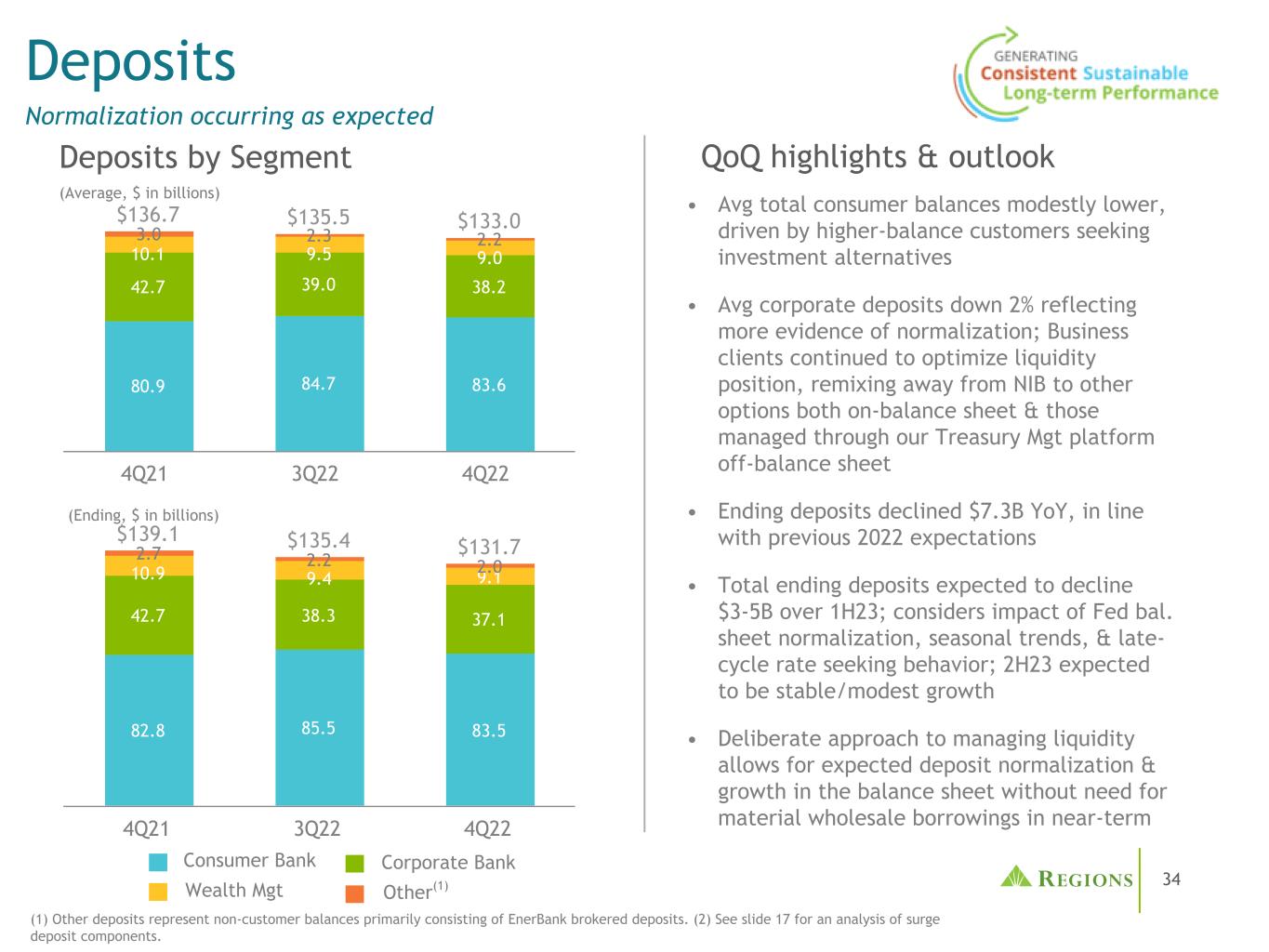
34 $139.1 $135.4 $131.7 82.8 85.5 83.5 42.7 38.3 37.1 10.9 9.4 9.1 2.7 2.2 2.0 4Q21 3Q22 4Q22 $136.7 $135.5 $133.0 80.9 84.7 83.6 42.7 39.0 38.2 10.1 9.5 9.0 3.0 2.3 2.2 4Q21 3Q22 4Q22 Deposits Normalization occurring as expected (1) Other deposits represent non-customer balances primarily consisting of EnerBank brokered deposits. (2) See slide 17 for an analysis of surge deposit components. Wealth Mgt Other(1) Consumer Bank Corporate Bank QoQ highlights & outlook • Avg total consumer balances modestly lower, driven by higher-balance customers seeking investment alternatives • Avg corporate deposits down 2% reflecting more evidence of normalization; Business clients continued to optimize liquidity position, remixing away from NIB to other options both on-balance sheet & those managed through our Treasury Mgt platform off-balance sheet • Ending deposits declined $7.3B YoY, in line with previous 2022 expectations • Total ending deposits expected to decline $3-5B over 1H23; considers impact of Fed bal. sheet normalization, seasonal trends, & late- cycle rate seeking behavior; 2H23 expected to be stable/modest growth • Deliberate approach to managing liquidity allows for expected deposit normalization & growth in the balance sheet without need for material wholesale borrowings in near-term (Ending, $ in billions) Deposits by Segment (Average, $ in billions)

35 Deposit mix and outlook Trends & Outlook Consumer & Wealth • New Customers & Customers with Low Betas in 2019: Customers who had low deposit betas in the 2019 rate cycle (effective annual rate <20bps)(3) and new customers since 2019 have exhibited very stable behavior thus far • Other 2019 Customers: Customers who were relatively more rate sensitive in the prior rate cycle declined modestly in 2022 in response to rapidly rising rates • The large low-sensitive deposit base will likely continue to support advantageous balance and overall rate sensitivity in this cycle • New Relationships & Relationships with Low Betas in 2019: Relationships with annual rate <20bps & new relationships since 2019. This cohort represents the majority of portfolio balances • Other 2019 Relationships: As expected, more rate sensitive customers are normalizing excess and seeking higher rate at a modest pace • Some additional normalization and rate seeking has been expected, but Regions' large proportion of non-interest will foster relative stability through the cycle 12/31/2022 Deposits(1)(2) (Ending, $ in billions) (1) Excludes Wealth Non-Retail deposits (Institutional Trust) of $0.9B and Other segment deposits of $2.0B. (2) Percentage estimates based on mixture at Nov 30 applied to Dec 31 balances. (3) Effective annual rates computed at the end of the 2019 up-rate cycle. 38%62% 80% 20% $37.1B $91.7B Other 2019 Relationships New Relationships & Relationships with Low Betas in 2019 Commercial/Corporate Other 2019 Customers New Customers & Customers with Low Betas in 2019
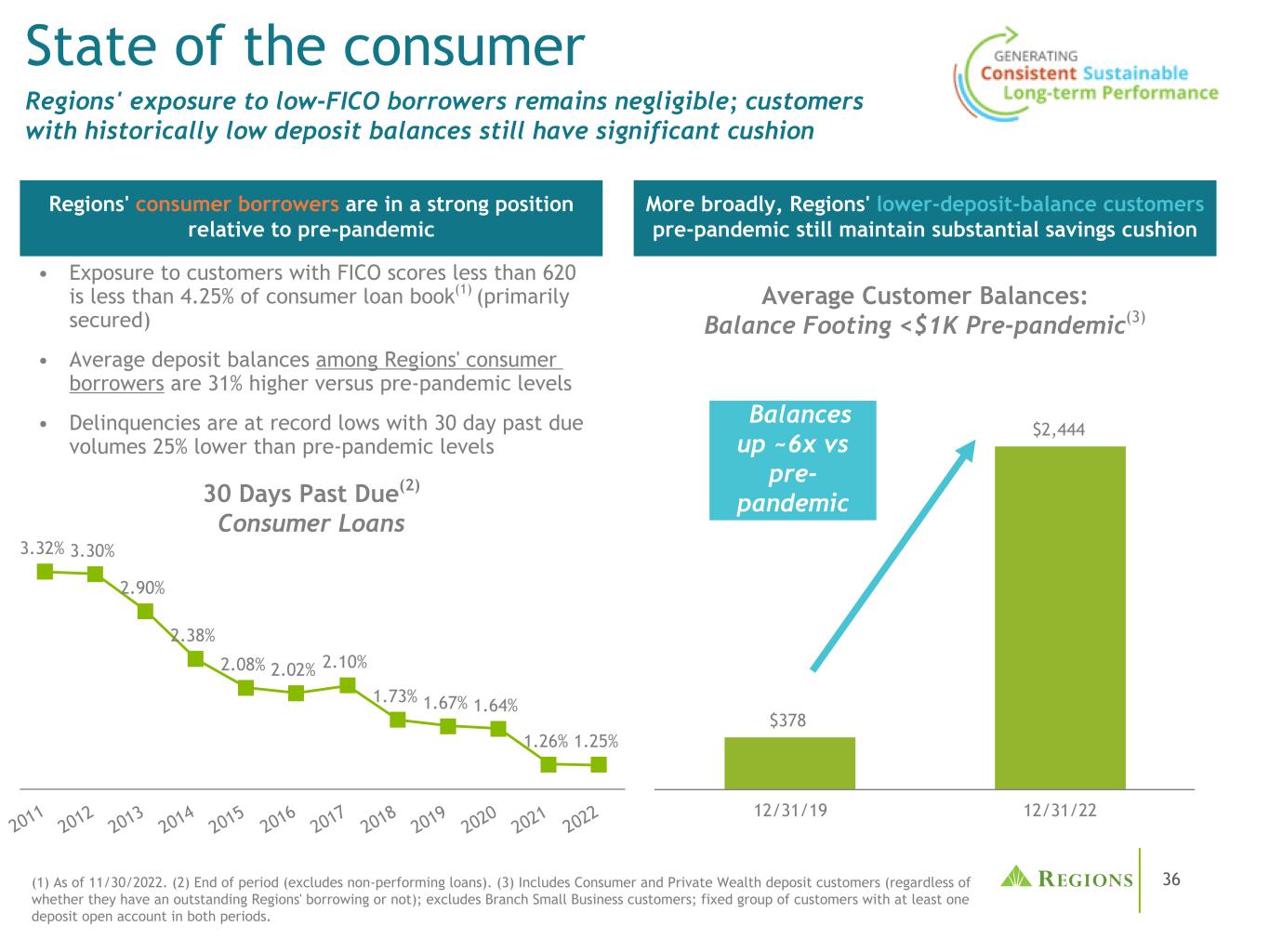
36 State of the consumer Regions' exposure to low-FICO borrowers remains negligible; customers with historically low deposit balances still have significant cushion Retail Deposits Business/ Other Deposits Retail Deposits Regions' consumer borrowers are in a strong position relative to pre-pandemic $378 $2,444 12/31/19 12/31/22 Balances up ~6x vs pre- pandemic • Exposure to customers with FICO scores less than 620 is less than 4.25% of consumer loan book(1) (primarily secured) • Average deposit balances among Regions' consumer borrowers are 31% higher versus pre-pandemic levels • Delinquencies are at record lows with 30 day past due volumes 25% lower than pre-pandemic levels Average Customer Balances: Balance Footing <$1K Pre-pandemic(3) More broadly, Regions' lower-deposit-balance customers pre-pandemic still maintain substantial savings cushion 3.32% 3.30% 2.90% 2.38% 2.08% 2.02% 2.10% 1.73% 1.67% 1.64% 1.26% 1.25% 2011 2012 2013 2014 2015 2016 2017 2018 2019 2020 2021 2022 (1) As of 11/30/2022. (2) End of period (excludes non-performing loans). (3) Includes Consumer and Private Wealth deposit customers (regardless of whether they have an outstanding Regions' borrowing or not); excludes Branch Small Business customers; fixed group of customers with at least one deposit open account in both periods. 30 Days Past Due(2) Consumer Loans
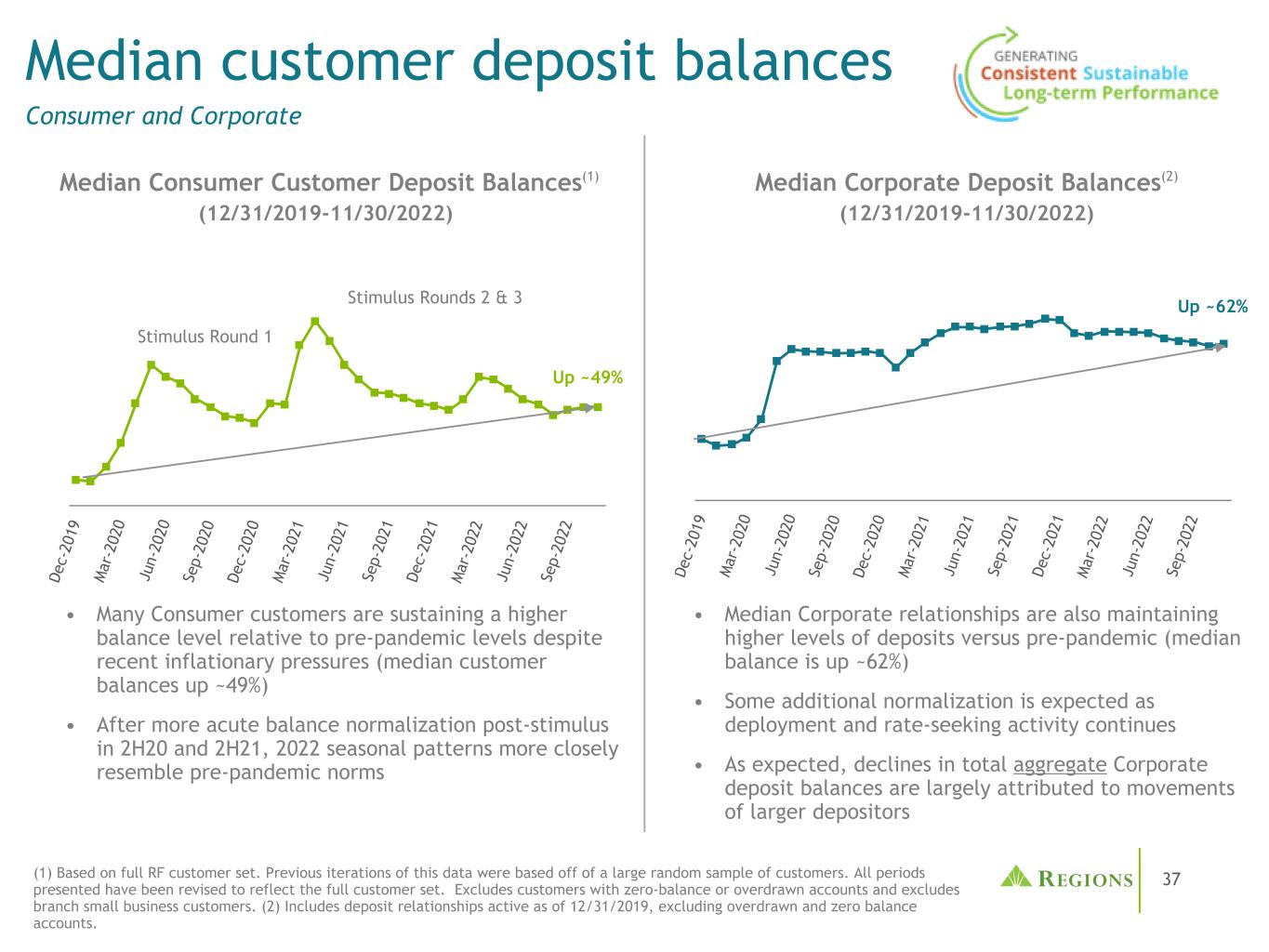
37 Median customer deposit balances Consumer and Corporate Retail Deposits De c- 20 19 M ar -2 02 0 Ju n- 20 20 Se p- 20 20 De c- 20 20 M ar -2 02 1 Ju n- 20 21 Se p- 20 21 De c- 20 21 M ar -2 02 2 Ju n- 20 22 Se p- 20 22 (1) Based on full RF customer set. Previous iterations of this data were based off of a large random sample of customers. All periods presented have been revised to reflect the full customer set. Excludes customers with zero-balance or overdrawn accounts and excludes branch small business customers. (2) Includes deposit relationships active as of 12/31/2019, excluding overdrawn and zero balance accounts. Median Consumer Customer Deposit Balances(1) (12/31/2019-11/30/2022) • Many Consumer customers are sustaining a higher balance level relative to pre-pandemic levels despite recent inflationary pressures (median customer balances up ~49%) • After more acute balance normalization post-stimulus in 2H20 and 2H21, 2022 seasonal patterns more closely resemble pre-pandemic norms Median Corporate Deposit Balances(2) (12/31/2019-11/30/2022) • Median Corporate relationships are also maintaining higher levels of deposits versus pre-pandemic (median balance is up ~62%) • Some additional normalization is expected as deployment and rate-seeking activity continues • As expected, declines in total aggregate Corporate deposit balances are largely attributed to movements of larger depositors Up ~49% De c- 20 19 M ar -2 02 0 Ju n- 20 20 Se p- 20 20 De c- 20 20 M ar -2 02 1 Ju n- 20 21 Se p- 20 21 De c- 20 21 M ar -2 02 2 Ju n- 20 22 Se p- 20 22 Up ~62%Stimulus Rounds 2 & 3 Stimulus Round 1

38 4Q17 4Q22 Deposit advantage (1) "Other" category includes EnerBank deposits and are average deposit balances. (2) Source - Bank Call Report data as of 9/30/2022. Peers include CFG, CMA, FHN, FITB, HBAN, HWC, KEY, MTB, PNC, SNV, TFC, USB, ZION. Funding Mix(1) - Current vs. Prior Rising Rate Cycle • Regions holds a larger proportion of smaller deposit balance accounts when compared to the industry • The increase in consumer deposits has been largely with existing long-tenure customers, whose low rate sensitivity is likely to persist into the next rate cycle % of Total Deposits Balance in Accounts Less than $250k(2) Business Deposit Mix(1) 4Q22 Average Consumer $84 Corporate $38 Wealth Mgt $9 Other $2 Product Mix Deposit Granularity The funding mix has become more granular and less reliant on wholesale borrowings, positioning the balance sheet well in a rising, or higher interest rate environment • Balance sheet primarily deposit funded; 97% of funding; 7% higher than at the outset of the last rising rate cycle • ~40% of deposit balances in non-interest bearing accounts ◦ 4Q22 Average NIB/IB split by Business: Consumer 37%/63%, Corporate 54%/46%, Wealth 14%/86% • Retail deposits consist of consumer and wealth accounts and represent ~70% of total deposits 28% 69% 63% 27% 10% 3%$105 $135 Retail Commercial ($ in billions) ($ in billions) Borrowings/ Other(1) 52% 47% 46% 45% 43% 42% 42% 42% 40% 40% 40% 39% 33% 28% RF Peer 1 Peer 2 Peer 3 Peer 4 Peer 5 Peer 6 Peer 7 Peer 8 Peer 9 Peer 10 Peer 11 Peer 12 Peer 13
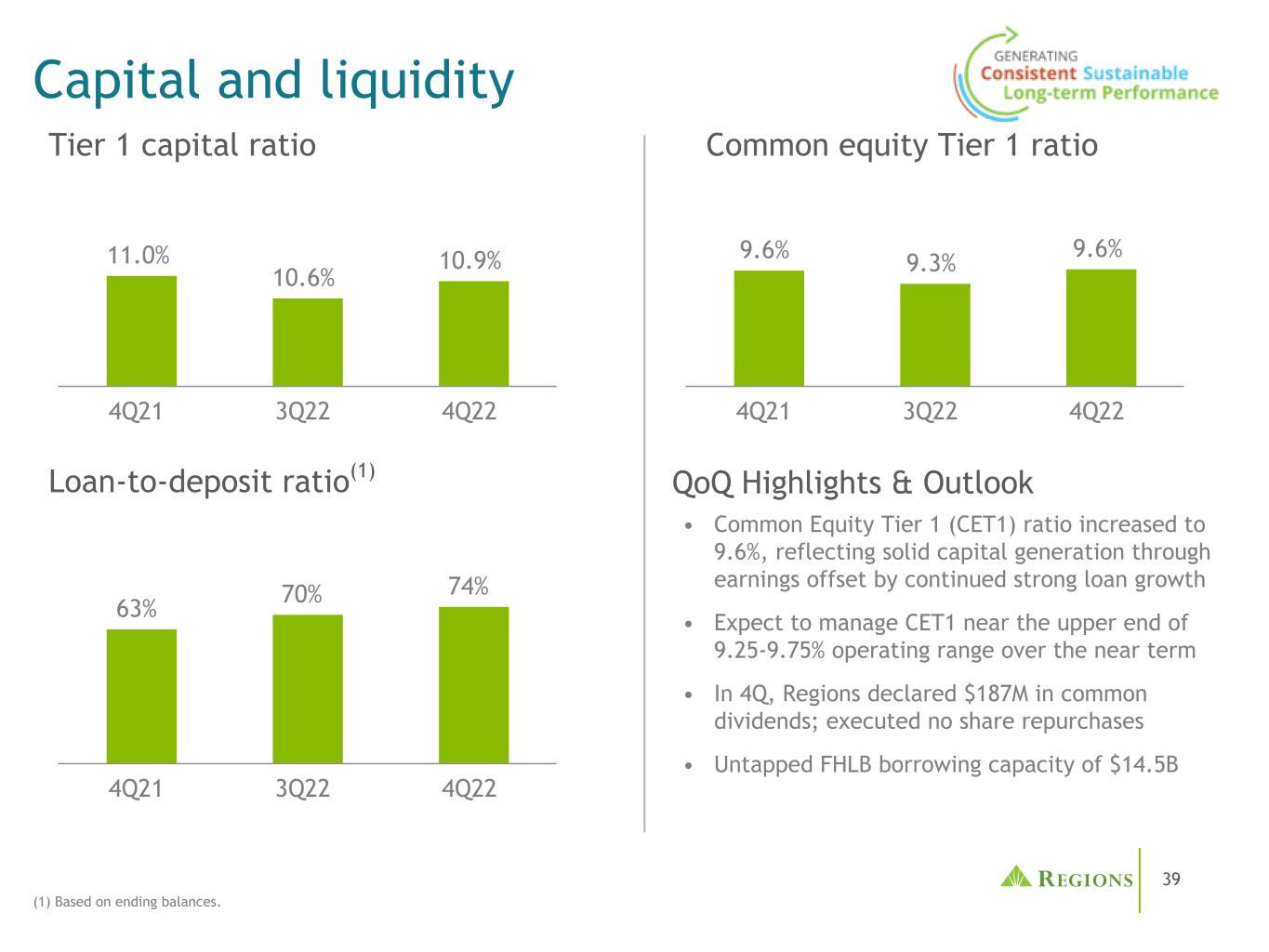
39 9.6% 9.3% 9.6% 4Q21 3Q22 4Q22 • Common Equity Tier 1 (CET1) ratio increased to 9.6%, reflecting solid capital generation through earnings offset by continued strong loan growth • Expect to manage CET1 near the upper end of 9.25-9.75% operating range over the near term • In 4Q, Regions declared $187M in common dividends; executed no share repurchases • Untapped FHLB borrowing capacity of $14.5B QoQ Highlights & Outlook Capital and liquidity (1) Based on ending balances. 11.0% 10.6% 10.9% 4Q21 3Q22 4Q22 Tier 1 capital ratio Loan-to-deposit ratio(1) 63% 70% 74% 4Q21 3Q22 4Q22 Common equity Tier 1 ratio

40 6.83% 5.93% 5.76% 5.01% 5.63% 6.66% 6.63% 6.97% 7.17% 7.64% TCE Ratio Adjusted TCE Ratio, ex-AOCI 4Q21 1Q22 2Q22 3Q22 4Q22 4.00% 5.00% 6.00% 7.00% 8.00% Tangible Common Equity (1) Non-GAAP; see Appendix for reconciliation. • Higher levels of interest rates are beneficial to Regions through expansion in net interest margin and deposit value ◦ However, higher rates also result in unrealized losses within our securities and cash flow hedging portfolios which act as a drag on our ratio of TCE to Tangible assets • Regions' TCE ratio, excluding the impact of Accumulated Other Comprehensive Income has grown consistently in 2022 Tangible Common Equity(1)

41 Investing for growth while maintaining focus on capital optimization Acquisition of HUD (MAP) License 2014 2015 2016 2019 2020 2018 2021 Acquisition of Fannie Mae DUS License Third-party originated auto portfolio ~$2.0B moved to runoff Entered into MSR flow-deal arrangement Sold Regions Insurance Group; redeployed capital generated to shareholders Greensky unsecured consumer loans ~$2.0B moved to runoff Dealer Financial Services auto portfolio ~$2.4B moved to runoff Entered into second MSR flow-deal arrangement Return optimization of commercial, OORE and IRE loans began through Capital Commitments Working Group Acquisition of Freddie Mac License 2022 Purchased $13B of bulk MSR Sold $1.2B Unsecured Consumer Loan Portfolio

42 Enhanced Fraud Analytics Machine learning models to detect and prevent fraud and enable analytics for proactive customer protection Modernizing Technology Practices Applying Security-First software development principles and expanding Agile adoption Cloud Engineering New talent and structure will accelerate the cloud journey Modern Authentication Experience Delivering a best-in-class Customer Identity and Access Management (CIAM) platform that is secure, frictionless, and innovative to enable digital transformation Continuous Improvement on Data Governance Unification of data architecture, data assets, and data catalog Open Banking Developing secure open banking APIs to drive innovation and novel customer experiences Empowered by innovation & data Expanding Influence of Data & Personalization Data-driven omnichannel view of customers for a “You Know Me & Value Me” experience Regions Client IQ(1) (RCLIQ) and Wealth IQ Delivering ‘needs based’ customer engagement, resulting in significant impact to corporate and wealth management ROSIE Personalized offering of products and services to anticipate customer needs Accelerating digital transformation through integration of customer feedback and institutional knowledge Delivering opportunities and insights to Mortgage Loan Officers Platform Modernization Platform Enhancements Next Generation of Customer Experience and Core Banking and Data Platforms Continued enhancements to Fulfillment and Servicing Platforms Path to omnichannel experience Centralization of Data/Modernization Leveraging modern Big Data Platforms to accelerate our data-driven decision-making processes Enhanced Data for Incentive Offers Offer Tracker combines data from multiple sources to enhance and automate the fulfillment processes Digital Efforts to Improve Commercial Customer Onboarding Experience Enhancing sales and lead management with centralized due diligence capabilities Modernizing Customer Relationship Management & Origination Platform Highly efficient and improved associate experience for sales and origination Efforts Enabling through Technology (1) RCLIQ is a machine learning based data product used by Corporate Banking Relationship managers to find new opportunities, predict share of wallet deepening activities as well as early warning of credit deterioration and attrition risk
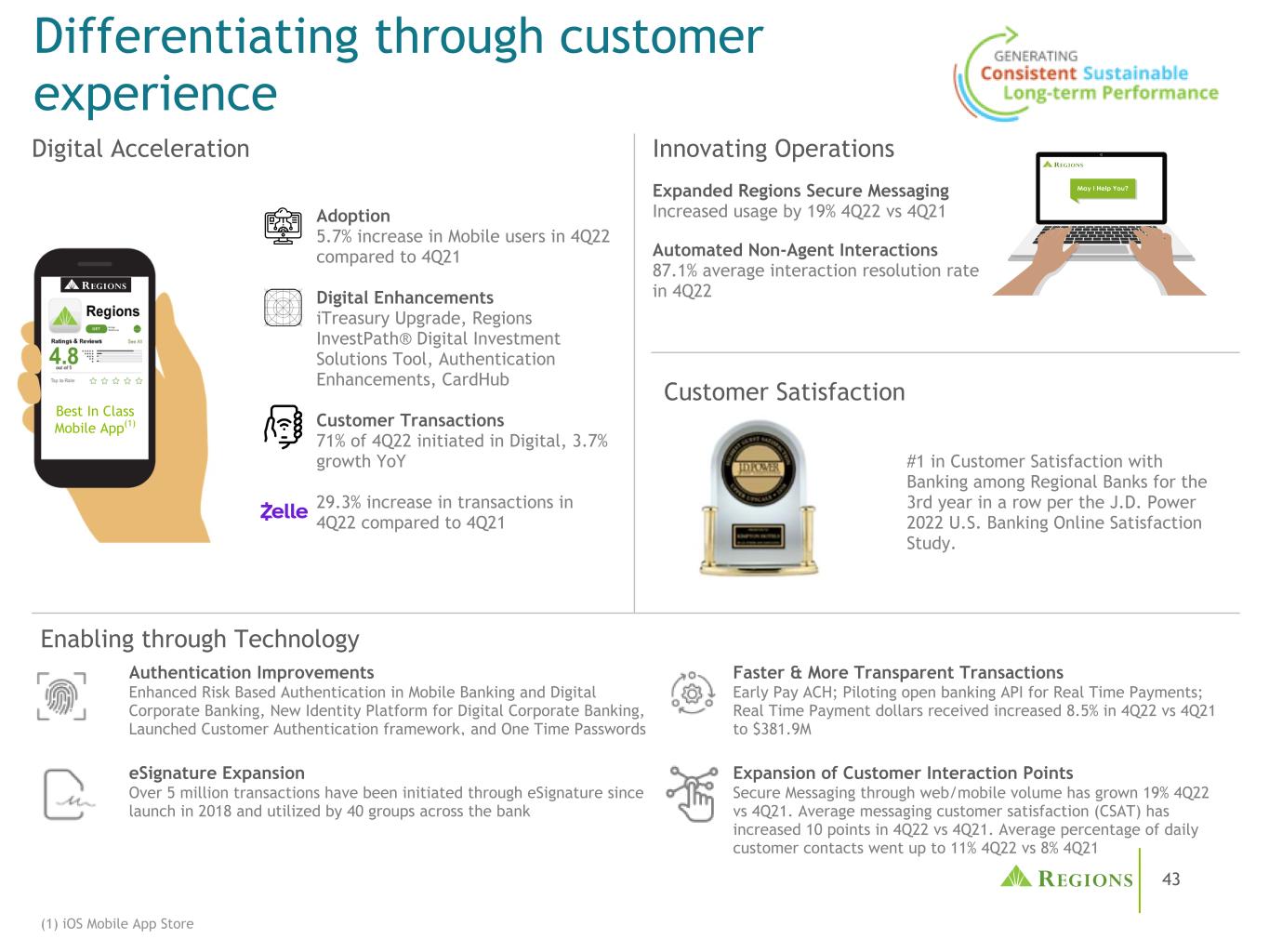
43 Differentiating through customer experience Best In Class Mobile App(1) Authentication Improvements Enhanced Risk Based Authentication in Mobile Banking and Digital Corporate Banking, New Identity Platform for Digital Corporate Banking, Launched Customer Authentication framework, and One Time Passwords Faster & More Transparent Transactions Early Pay ACH; Piloting open banking API for Real Time Payments; Real Time Payment dollars received increased 8.5% in 4Q22 vs 4Q21 to $381.9M eSignature Expansion Over 5 million transactions have been initiated through eSignature since launch in 2018 and utilized by 40 groups across the bank Expansion of Customer Interaction Points Secure Messaging through web/mobile volume has grown 19% 4Q22 vs 4Q21. Average messaging customer satisfaction (CSAT) has increased 10 points in 4Q22 vs 4Q21. Average percentage of daily customer contacts went up to 11% 4Q22 vs 8% 4Q21 Adoption 5.7% increase in Mobile users in 4Q22 compared to 4Q21 Digital Enhancements iTreasury Upgrade, Regions InvestPath® Digital Investment Solutions Tool, Authentication Enhancements, CardHub Customer Transactions 71% of 4Q22 initiated in Digital, 3.7% growth YoY 29.3% increase in transactions in 4Q22 compared to 4Q21 Digital Acceleration Innovating Operations Expanded Regions Secure Messaging Increased usage by 19% 4Q22 vs 4Q21 Automated Non-Agent Interactions 87.1% average interaction resolution rate in 4Q22 #1 in Customer Satisfaction with Banking among Regional Banks for the 3rd year in a row per the J.D. Power 2022 U.S. Banking Online Satisfaction Study. Customer Satisfaction (1) iOS Mobile App Store Enabling through Technology

44 System Maintenance New Technology Cybersecurity / Risk Management Continue to invest for the future Regions remains competitive by reserving ~9–11% of revenue for technology spend Innovation and Strategy Customer Experience & Technology Past investment on innovation and strategy provided a firm, resilient foundation for addressing changes in customer needs Investments over the last 4 years to modernize the customer experience and transform the technology operating model allow system modernization to be prioritized for new technology spend Continuous Innovation Platform Modernization Along with continuous innovation, we are making investments into modernizing our infrastructure and data. As we start taking advantage of AI and the scale modern technologies have to offer, our technology spend will increase to support revenue growth Regions will take a staggered approach to platform modernization. Modernization efforts began in 2021 with runway through 2027 to complete the overall program Spend Allocation
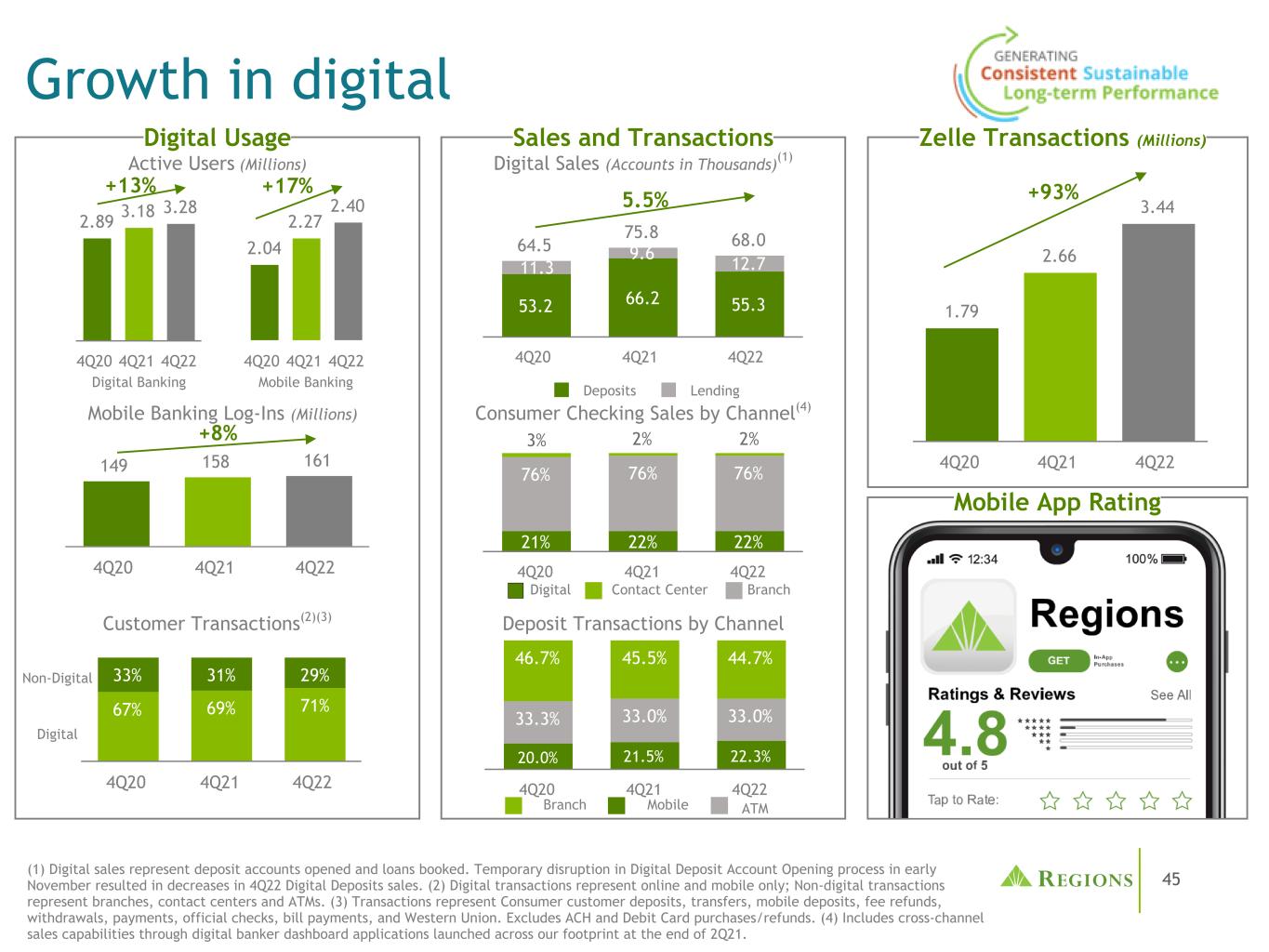
45 2.04 2.27 2.40 4Q20 4Q21 4Q22 1.79 2.66 3.44 4Q20 4Q21 4Q22149 158 161 4Q20 4Q21 4Q22 2.89 3.18 3.28 4Q20 4Q21 4Q22 20.0% 21.5% 22.3% 33.3% 33.0% 33.0% 46.7% 45.5% 44.7% 4Q20 4Q21 4Q22 64.5 75.8 68.0 53.2 66.2 55.3 11.3 9.6 12.7 Deposits Lending 4Q20 4Q21 4Q22 67% 69% 71% 33% 31% 29% 4Q20 4Q21 4Q22 Growth in digital Mobile Banking Log-Ins (Millions) Customer Transactions(2)(3) Deposit Transactions by Channel +13% Active Users (Millions) Digital Sales (Accounts in Thousands)(1) Digital Banking Digital Non-Digital Mobile ATMBranch (1) Digital sales represent deposit accounts opened and loans booked. Temporary disruption in Digital Deposit Account Opening process in early November resulted in decreases in 4Q22 Digital Deposits sales. (2) Digital transactions represent online and mobile only; Non-digital transactions represent branches, contact centers and ATMs. (3) Transactions represent Consumer customer deposits, transfers, mobile deposits, fee refunds, withdrawals, payments, official checks, bill payments, and Western Union. Excludes ACH and Debit Card purchases/refunds. (4) Includes cross-channel sales capabilities through digital banker dashboard applications launched across our footprint at the end of 2Q21. +93% +8% 21% 22% 22% 76% 76% 76% 3% 2% 2% 4Q20 4Q21 4Q22 Digital BranchContact Center Consumer Checking Sales by Channel(4) Mobile Banking Mobile App Rating Zelle Transactions (Millions)Sales and TransactionsDigital Usage 5.5% +17%
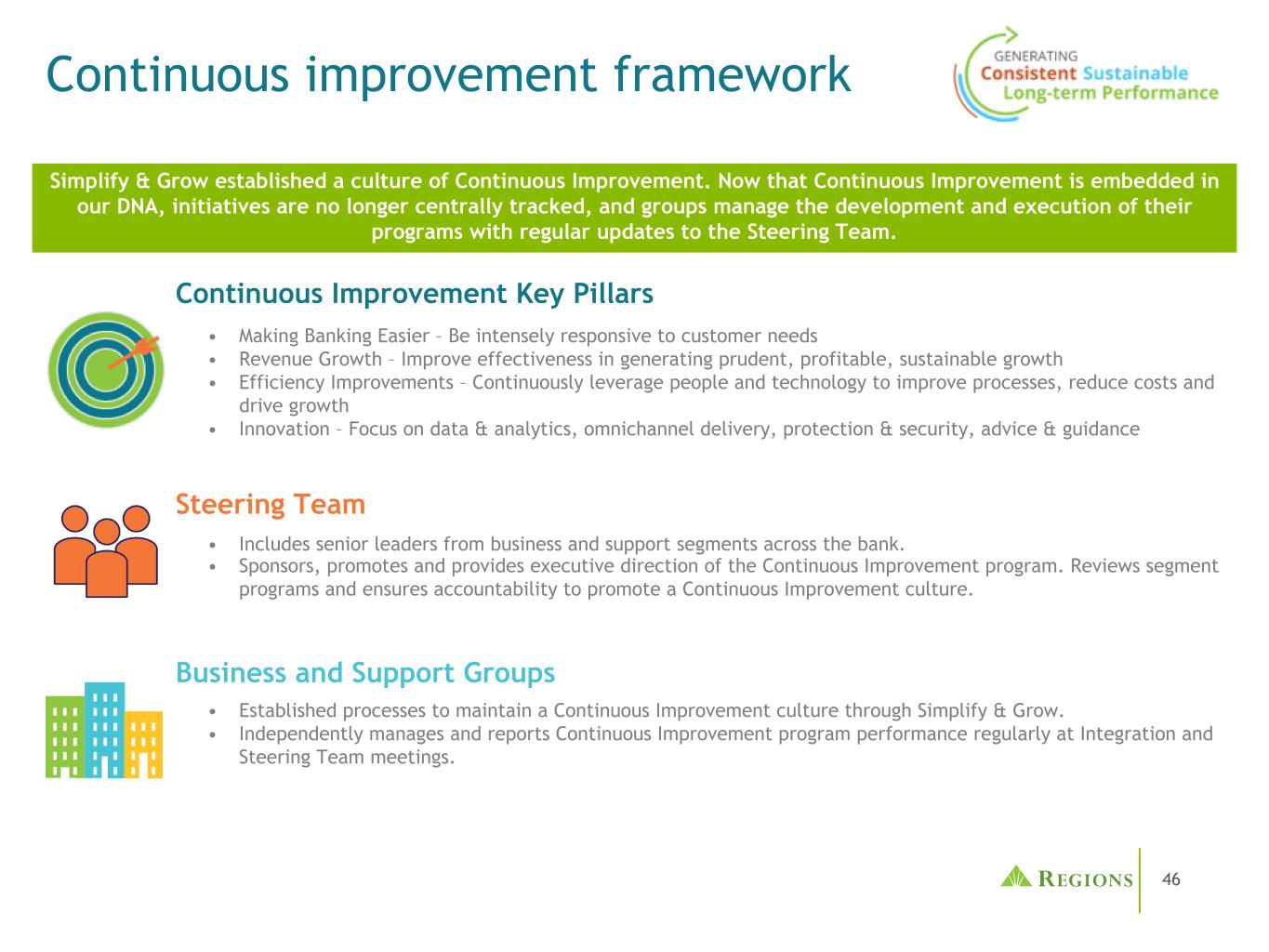
46 Continuous improvement framework • Making Banking Easier – Be intensely responsive to customer needs • Revenue Growth – Improve effectiveness in generating prudent, profitable, sustainable growth • Efficiency Improvements – Continuously leverage people and technology to improve processes, reduce costs and drive growth • Innovation – Focus on data & analytics, omnichannel delivery, protection & security, advice & guidance Simplify & Grow established a culture of Continuous Improvement. Now that Continuous Improvement is embedded in our DNA, initiatives are no longer centrally tracked, and groups manage the development and execution of their programs with regular updates to the Steering Team. • Established processes to maintain a Continuous Improvement culture through Simplify & Grow. • Independently manages and reports Continuous Improvement program performance regularly at Integration and Steering Team meetings. • Includes senior leaders from business and support segments across the bank. • Sponsors, promotes and provides executive direction of the Continuous Improvement program. Reviews segment programs and ensures accountability to promote a Continuous Improvement culture. Continuous Improvement Key Pillars Steering Team Business and Support Groups

47 • Experienced some expected normalization in credit metrics, underlying credit performance remains broadly stable • 4Q annualized NCOs were 29 bps; excluding 3Q consumer loan sale, adjusted FY22 NCOs(1) at 22 bps • 4Q NPLs flat QoQ, but remain below pre-pandemic levels • 4Q ACL increased, resulting in a stable ACL/Loans ratio; increase attributable to economic conditions, normalizing credit from historically low levels, and loan growth, partially offset by elimination of $20M hurricane-related reserve established in 3Q • Expect full-year 2023 NCOs to be ~25-35 bps Non-Performing Loans (NPLs) Asset quality Underlying credit performance remains broadly stable ($ in millions) ($ in millions) Allowance for Credit Losses (ACL) $1,574 $1,539 $1,582 1.79% 1.63% 1.63% 349% 311% 317% ACL ACL/Loans ACL/NPLs 4Q21 3Q22 4Q22 $44 $110 $69 $47 $63 4Q21 3Q22 4Q22 0.20% 0.19% 0.29% 0.46% (1) Non-GAAP; see appendix for reconciliation. (2) 3Q22 $94M reserve release less $63M fair value mark through charge-offs = $31M net provision benefit. $451 $495 $500 0.51% 0.52% 0.52% NPLs - excluding LHFS NPL/Loans 4Q21 3Q22 4Q22 Net charge-offs ($ in millions) Adjusted Net Charge-Offs(1) 9/30 Consumer Loan Sale(2) Net Charge-Offs Ratio Adjusted Net Charge-Offs Ratio(1)
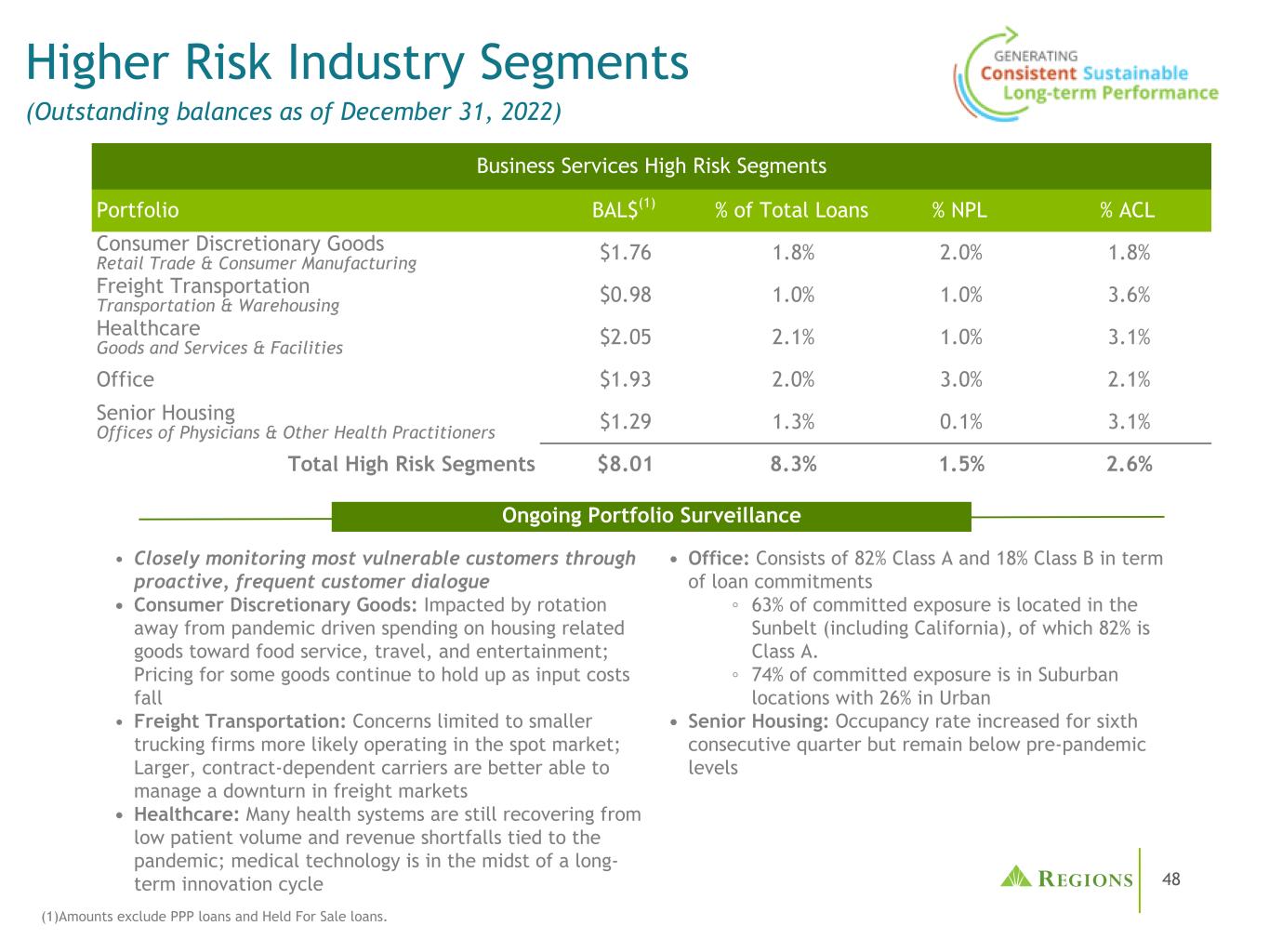
48 Higher Risk Industry Segments (Outstanding balances as of December 31, 2022) (1)Amounts exclude PPP loans and Held For Sale loans. Business Services High Risk Segments Portfolio BAL$(1) % of Total Loans % NPL % ACL Consumer Discretionary Goods Retail Trade & Consumer Manufacturing $1.76 1.8% 2.0% 1.8% Freight Transportation Transportation & Warehousing $0.98 1.0% 1.0% 3.6% Healthcare Goods and Services & Facilities $2.05 2.1% 1.0% 3.1% Office $1.93 2.0% 3.0% 2.1% Senior Housing Offices of Physicians & Other Health Practitioners $1.29 1.3% 0.1% 3.1% Total High Risk Segments $8.01 8.3% 1.5% 2.6% • Closely monitoring most vulnerable customers through proactive, frequent customer dialogue • Consumer Discretionary Goods: Impacted by rotation away from pandemic driven spending on housing related goods toward food service, travel, and entertainment; Pricing for some goods continue to hold up as input costs fall • Freight Transportation: Concerns limited to smaller trucking firms more likely operating in the spot market; Larger, contract-dependent carriers are better able to manage a downturn in freight markets • Healthcare: Many health systems are still recovering from low patient volume and revenue shortfalls tied to the pandemic; medical technology is in the midst of a long- term innovation cycle Ongoing Portfolio Surveillance • Office: Consists of 82% Class A and 18% Class B in term of loan commitments ◦ 63% of committed exposure is located in the Sunbelt (including California), of which 82% is Class A. ◦ 74% of committed exposure is in Suburban locations with 26% in Urban • Senior Housing: Occupancy rate increased for sixth consecutive quarter but remain below pre-pandemic levels
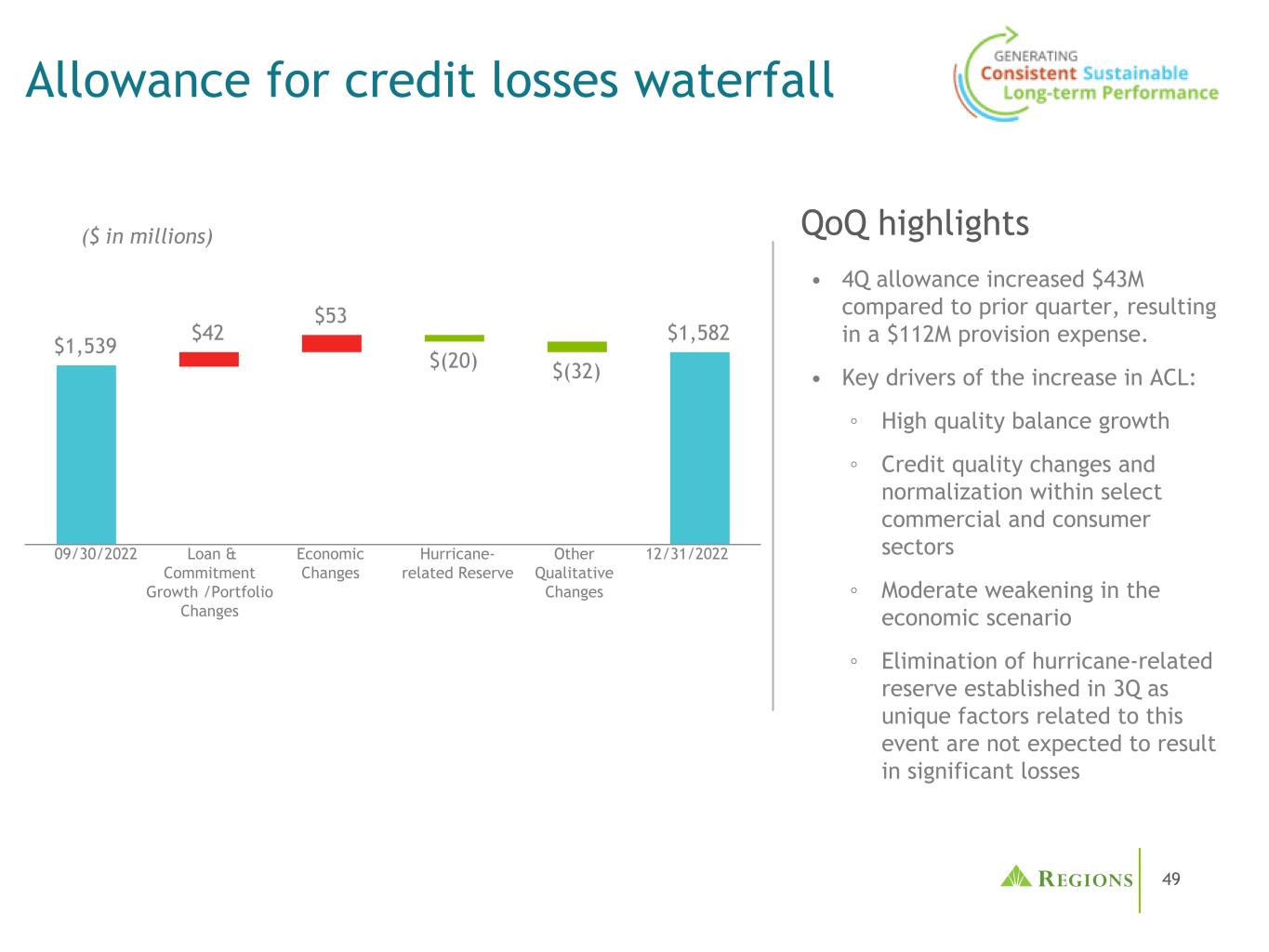
49 Economic Changes $1,539 $42 $53 $(20) $(32) $1,582 Allowance for credit losses waterfall 12/31/2022 • 4Q allowance increased $43M compared to prior quarter, resulting in a $112M provision expense. • Key drivers of the increase in ACL: ◦ High quality balance growth ◦ Credit quality changes and normalization within select commercial and consumer sectors ◦ Moderate weakening in the economic scenario ◦ Elimination of hurricane-related reserve established in 3Q as unique factors related to this event are not expected to result in significant losses QoQ highlights($ in millions) 09/30/2022 Loan & Commitment Growth /Portfolio Changes Other Qualitative Changes Hurricane- related Reserve
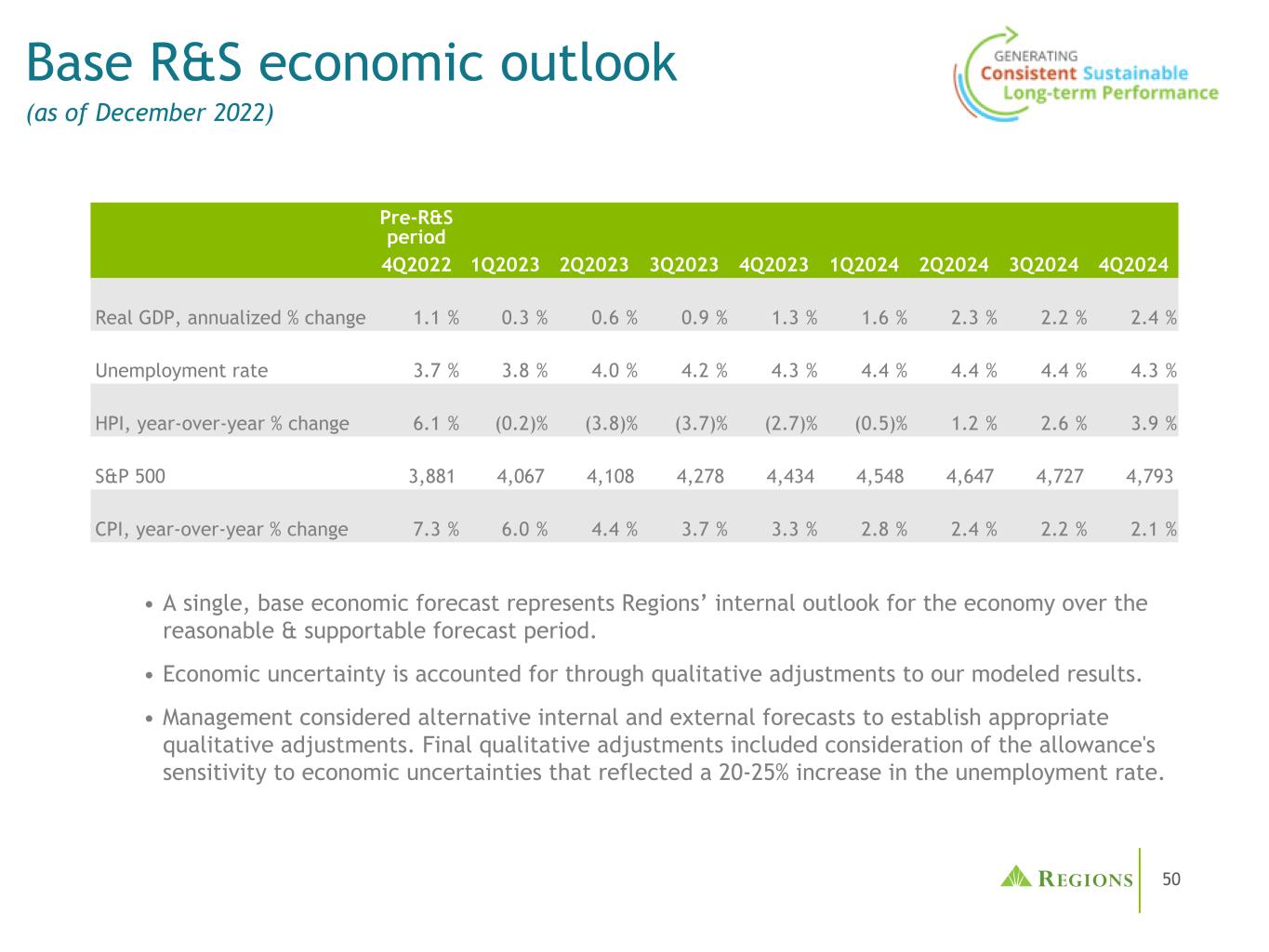
50 Pre-R&S period 4Q2022 1Q2023 2Q2023 3Q2023 4Q2023 1Q2024 2Q2024 3Q2024 4Q2024 Real GDP, annualized % change 1.1 % 0.3 % 0.6 % 0.9 % 1.3 % 1.6 % 2.3 % 2.2 % 2.4 % Unemployment rate 3.7 % 3.8 % 4.0 % 4.2 % 4.3 % 4.4 % 4.4 % 4.4 % 4.3 % HPI, year-over-year % change 6.1 % (0.2) % (3.8) % (3.7) % (2.7) % (0.5) % 1.2 % 2.6 % 3.9 % S&P 500 3,881 4,067 4,108 4,278 4,434 4,548 4,647 4,727 4,793 CPI, year-over-year % change 7.3 % 6.0 % 4.4 % 3.7 % 3.3 % 2.8 % 2.4 % 2.2 % 2.1 % Base R&S economic outlook (as of December 2022) • A single, base economic forecast represents Regions’ internal outlook for the economy over the reasonable & supportable forecast period. • Economic uncertainty is accounted for through qualitative adjustments to our modeled results. • Management considered alternative internal and external forecasts to establish appropriate qualitative adjustments. Final qualitative adjustments included consideration of the allowance's sensitivity to economic uncertainties that reflected a 20-25% increase in the unemployment rate.
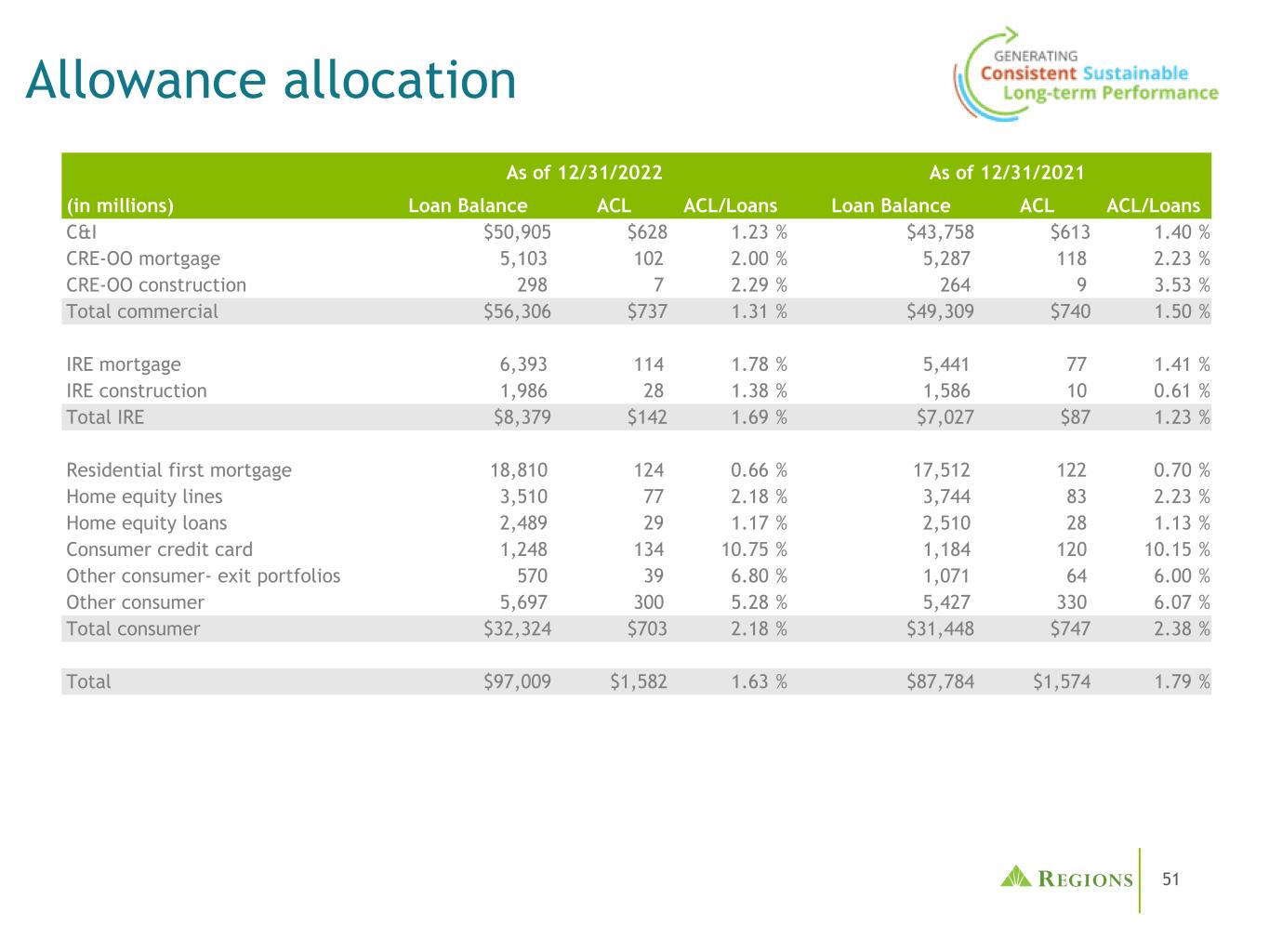
51 As of 12/31/2022 As of 12/31/2021 (in millions) Loan Balance ACL ACL/Loans Loan Balance ACL ACL/Loans C&I $50,905 $628 1.23 % $43,758 $613 1.40 % CRE-OO mortgage 5,103 102 2.00 % 5,287 118 2.23 % CRE-OO construction 298 7 2.29 % 264 9 3.53 % Total commercial $56,306 $737 1.31 % $49,309 $740 1.50 % IRE mortgage 6,393 114 1.78 % 5,441 77 1.41 % IRE construction 1,986 28 1.38 % 1,586 10 0.61 % Total IRE $8,379 $142 1.69 % $7,027 $87 1.23 % Residential first mortgage 18,810 124 0.66 % 17,512 122 0.70 % Home equity lines 3,510 77 2.18 % 3,744 83 2.23 % Home equity loans 2,489 29 1.17 % 2,510 28 1.13 % Consumer credit card 1,248 134 10.75 % 1,184 120 10.15 % Other consumer- exit portfolios 570 39 6.80 % 1,071 64 6.00 % Other consumer 5,697 300 5.28 % 5,427 330 6.07 % Total consumer $32,324 $703 2.18 % $31,448 $747 2.38 % Total $97,009 $1,582 1.63 % $87,784 $1,574 1.79 % Allowance allocation

52 All Other Commercial 3.8% Investor Real Estate 13.0% Financial Services 10.8% CRE Unsecured, including REITs 10.4% Govt. Education 10.1% Consumer Services 8.5% Technology Services 8.3% Manufacturing 8.3% Business Services 7.5% Distribution 6.8% Commodities 6.8% Healthcare 5.7% Well positioned for next downturn $64.7B Highly Diversified Business Portfolio(1) (1) Balances as of 12/31/22. (2) All other commercial categories consist of sub-components less than 5%. (3) CRE Unsecured consists 74% of REITs. (2) (3)

53 Consumer lending portfolio statistics • Avg. origination FICO 759 • Current LTV 52% • 98% owner occupied • Avg. origination FICO 758 • Current LTV 35% • 68% of portfolio is 1st lien • Avg. loan size $35,733 • $125M to convert to amortizing or balloon during 2023 • Avg. origination FICO 760 • Avg. new loan $18,622 • 4Q22 Yield 7.77% • Avg. origination FICO 753 • 4Q22 Yield 6.07% • 4Q22 QTD NCO 2.46% • Avg. origination FICO 769 • Avg. new line $6,394 • 4Q22 Yield 14.34% • 4Q22 QTD NCO 2.94% 3% 5% 4%5% 13% 7% 9% 17% 11% 81% 63% 76% 2% 2% 2% Cons R/E secured Cons non-R/E secured Total consumer Not Available Above 720 620-680 Below 620 681-720 Consumer FICO Scores(1) (1) Refreshed FICO scores as of 12/31/2022. (2) Other Consumer consists primarily of EnerBank and Direct portfolios Residential Mortgage Consumer - Exit Portfolios Consumer Credit Card Home Equity Other Consumer(2)

54 $3.3B Leveraged portfolio (outstanding balances as of December 31, 2022) • RF defines Leverage consistent with Moody's historical Regional Bank Survey definition; Commitments >$5M with funded debt to EBITDA>4.0x ◦ Commitments are $4.4B • Not a strategic growth objective; used to support client relationships • Sponsor-owned clients as a percentage of total portfolio continue to decline • Enhanced centralized underwriting, servicing, and credit adjudication • Limited participation in the highest risk segments of leveraged loans - Covenant Lite & Term Loan B • Approximately 93% of leveraged loans outstanding are also SNCs • RF has no "hung deals" in the syndicated loan market as of 12/31/2022(1) Important FactorsDiversified Portfolio 24.9% 17.5% 10.6%6.8% 6.8% 6.7% 5.1% 5.1% 4.2% 12.3% Information Professional, Scientific & Technical Services Administrative, Support, Waste & Repair Utilities Manufacturing Wholesale Religious, Leisure, Personal & Non-Profit Services Real Estate Healthcare Other (Portfolios <4% of total) (1) Unable to move risk off balance sheet due to market dislocation.
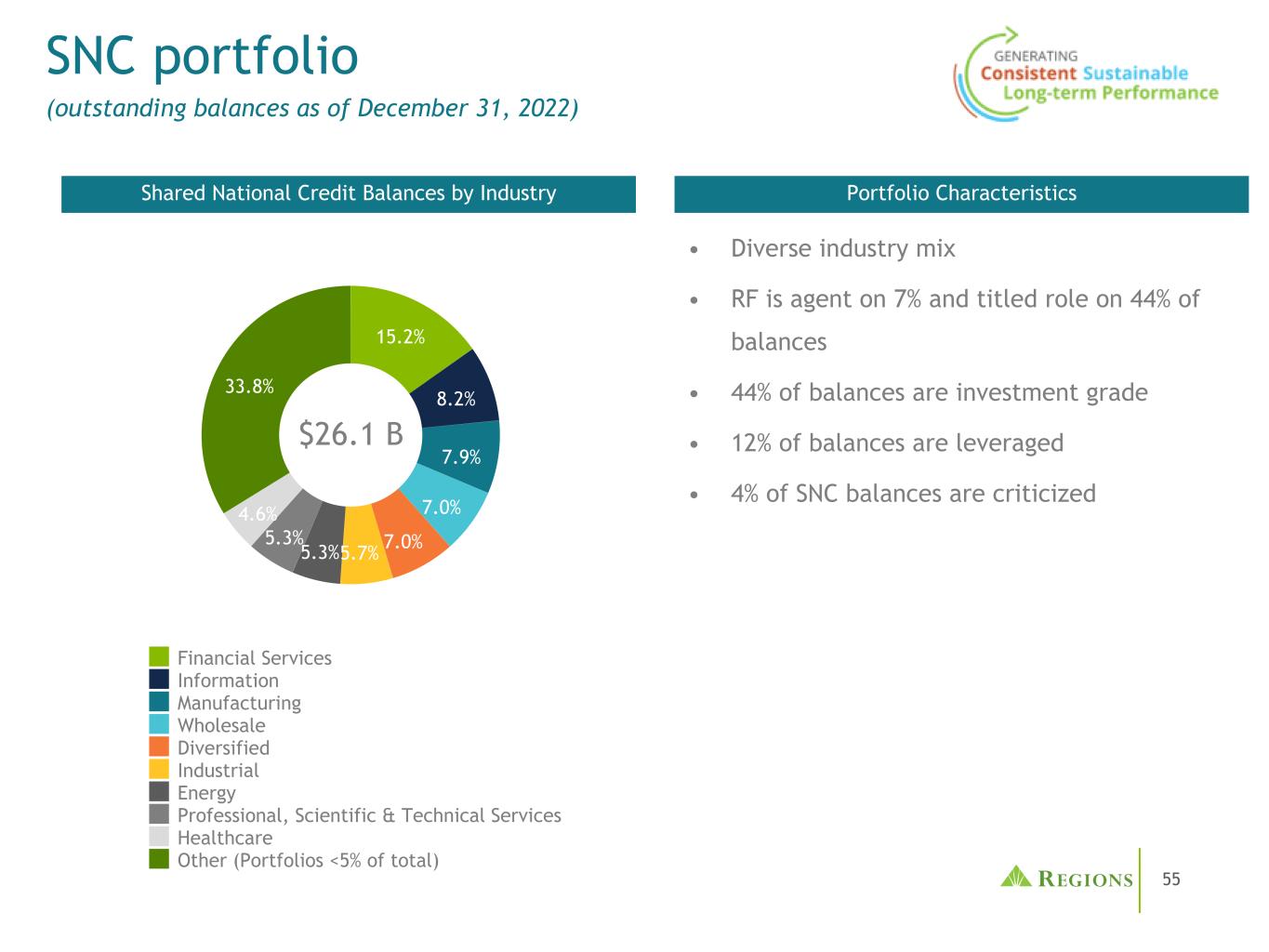
55 15.2% 8.2% 7.9% 7.0% 7.0%5.7%5.3% 5.3% 4.6% 33.8% Financial Services Information Manufacturing Wholesale Diversified Industrial Energy Professional, Scientific & Technical Services Healthcare Other (Portfolios <5% of total) $26.1 B SNC portfolio (outstanding balances as of December 31, 2022) • Diverse industry mix • RF is agent on 7% and titled role on 44% of balances • 44% of balances are investment grade • 12% of balances are leveraged • 4% of SNC balances are criticized Portfolio CharacteristicsShared National Credit Balances by Industry
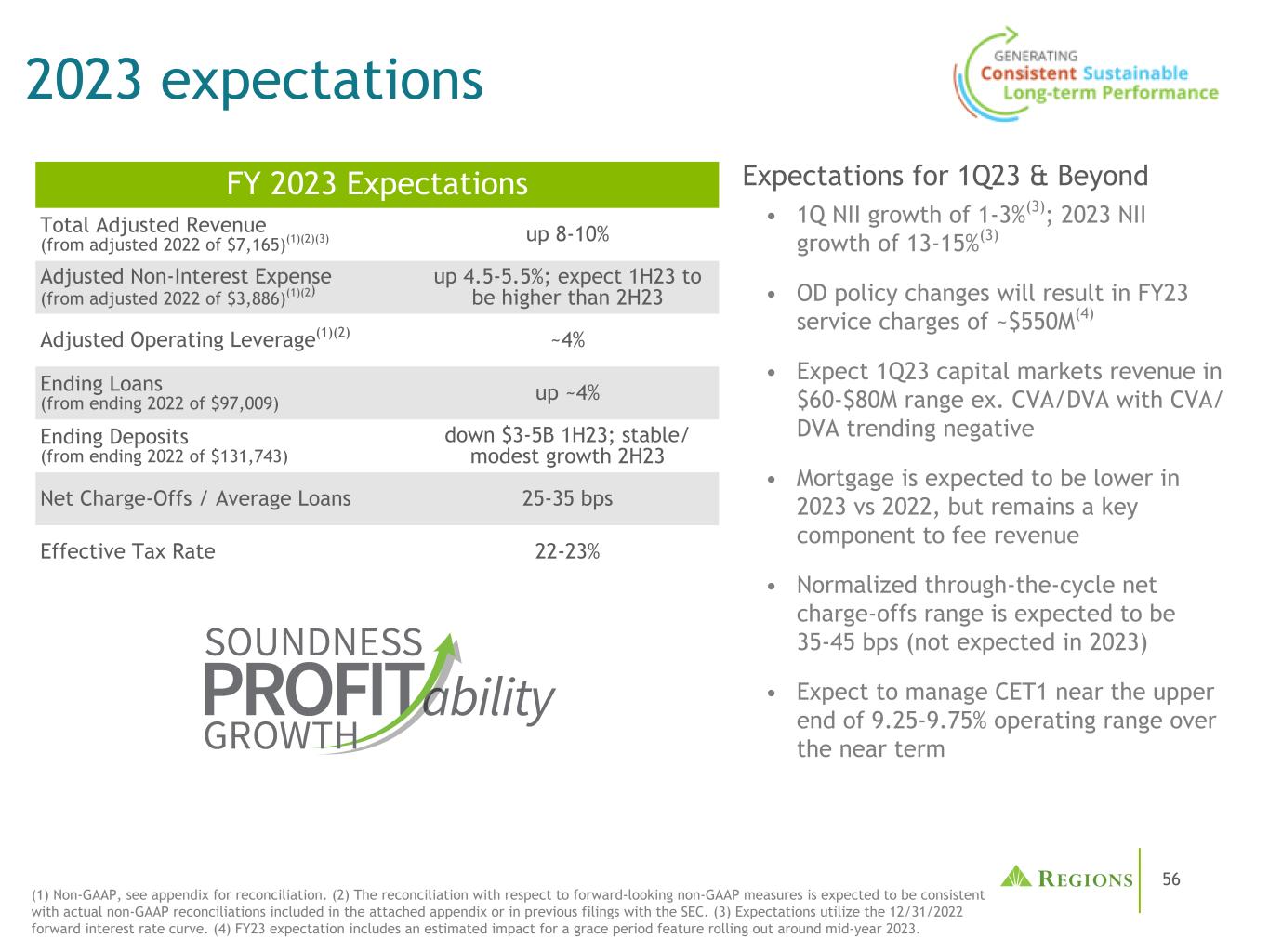
56 2023 expectations (1) Non-GAAP, see appendix for reconciliation. (2) The reconciliation with respect to forward-looking non-GAAP measures is expected to be consistent with actual non-GAAP reconciliations included in the attached appendix or in previous filings with the SEC. (3) Expectations utilize the 12/31/2022 forward interest rate curve. (4) FY23 expectation includes an estimated impact for a grace period feature rolling out around mid-year 2023. FY 2023 Expectations Total Adjusted Revenue (from adjusted 2022 of $7,165)(1)(2)(3) up 8-10% Adjusted Non-Interest Expense (from adjusted 2022 of $3,886)(1)(2) up 4.5-5.5%; expect 1H23 to be higher than 2H23 Adjusted Operating Leverage(1)(2) ~4% Ending Loans (from ending 2022 of $97,009) up ~4% Ending Deposits (from ending 2022 of $131,743) down $3-5B 1H23; stable/ modest growth 2H23 Net Charge-Offs / Average Loans 25-35 bps Effective Tax Rate 22-23% Expectations for 1Q23 & Beyond • 1Q NII growth of 1-3%(3); 2023 NII growth of 13-15%(3) • OD policy changes will result in FY23 service charges of ~$550M(4) • Expect 1Q23 capital markets revenue in $60-$80M range ex. CVA/DVA with CVA/ DVA trending negative • Mortgage is expected to be lower in 2023 vs 2022, but remains a key component to fee revenue • Normalized through-the-cycle net charge-offs range is expected to be 35-45 bps (not expected in 2023) • Expect to manage CET1 near the upper end of 9.25-9.75% operating range over the near term
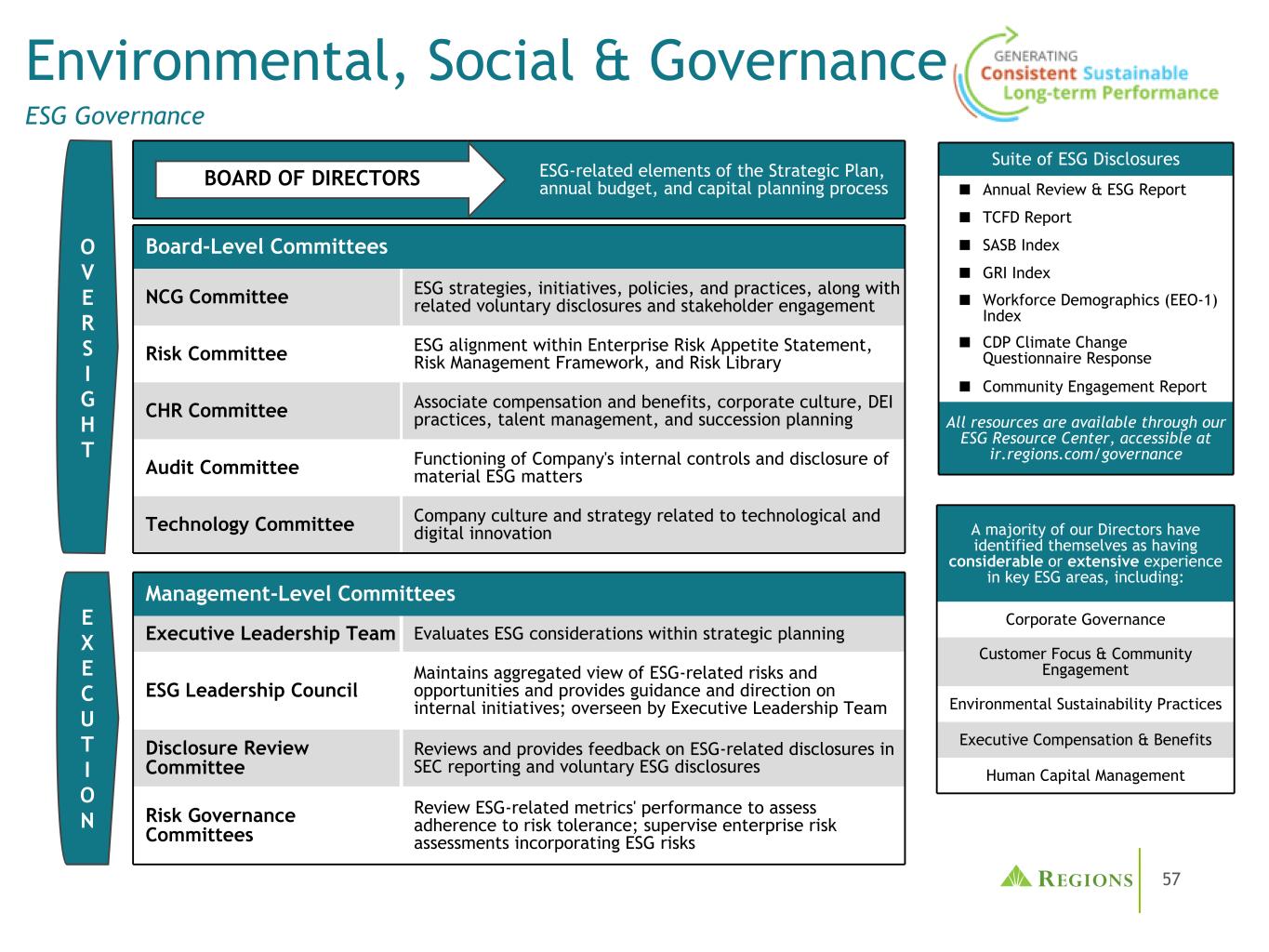
57 Environmental, Social & Governance ESG Governance ESG-related elements of the Strategic Plan, annual budget, and capital planning processBOARD OF DIRECTORS Board-Level Committees NCG Committee ESG strategies, initiatives, policies, and practices, along with related voluntary disclosures and stakeholder engagement Risk Committee ESG alignment within Enterprise Risk Appetite Statement, Risk Management Framework, and Risk Library CHR Committee Associate compensation and benefits, corporate culture, DEI practices, talent management, and succession planning Audit Committee Functioning of Company's internal controls and disclosure of material ESG matters Technology Committee Company culture and strategy related to technological and digital innovation Management-Level Committees Executive Leadership Team Evaluates ESG considerations within strategic planning ESG Leadership Council Maintains aggregated view of ESG-related risks and opportunities and provides guidance and direction on internal initiatives; overseen by Executive Leadership Team Disclosure Review Committee Reviews and provides feedback on ESG-related disclosures in SEC reporting and voluntary ESG disclosures Risk Governance Committees Review ESG-related metrics' performance to assess adherence to risk tolerance; supervise enterprise risk assessments incorporating ESG risks O V E R S I G H T E X E C U T I O N A majority of our Directors have identified themselves as having considerable or extensive experience in key ESG areas, including: Corporate Governance Customer Focus & Community Engagement Environmental Sustainability Practices Executive Compensation & Benefits Human Capital Management Suite of ESG Disclosures ■ Annual Review & ESG Report ■ TCFD Report ■ SASB Index ■ GRI Index ■ Workforce Demographics (EEO-1) Index ■ CDP Climate Change Questionnaire Response ■ Community Engagement Report All resources are available through our ESG Resource Center, accessible at ir.regions.com/governance
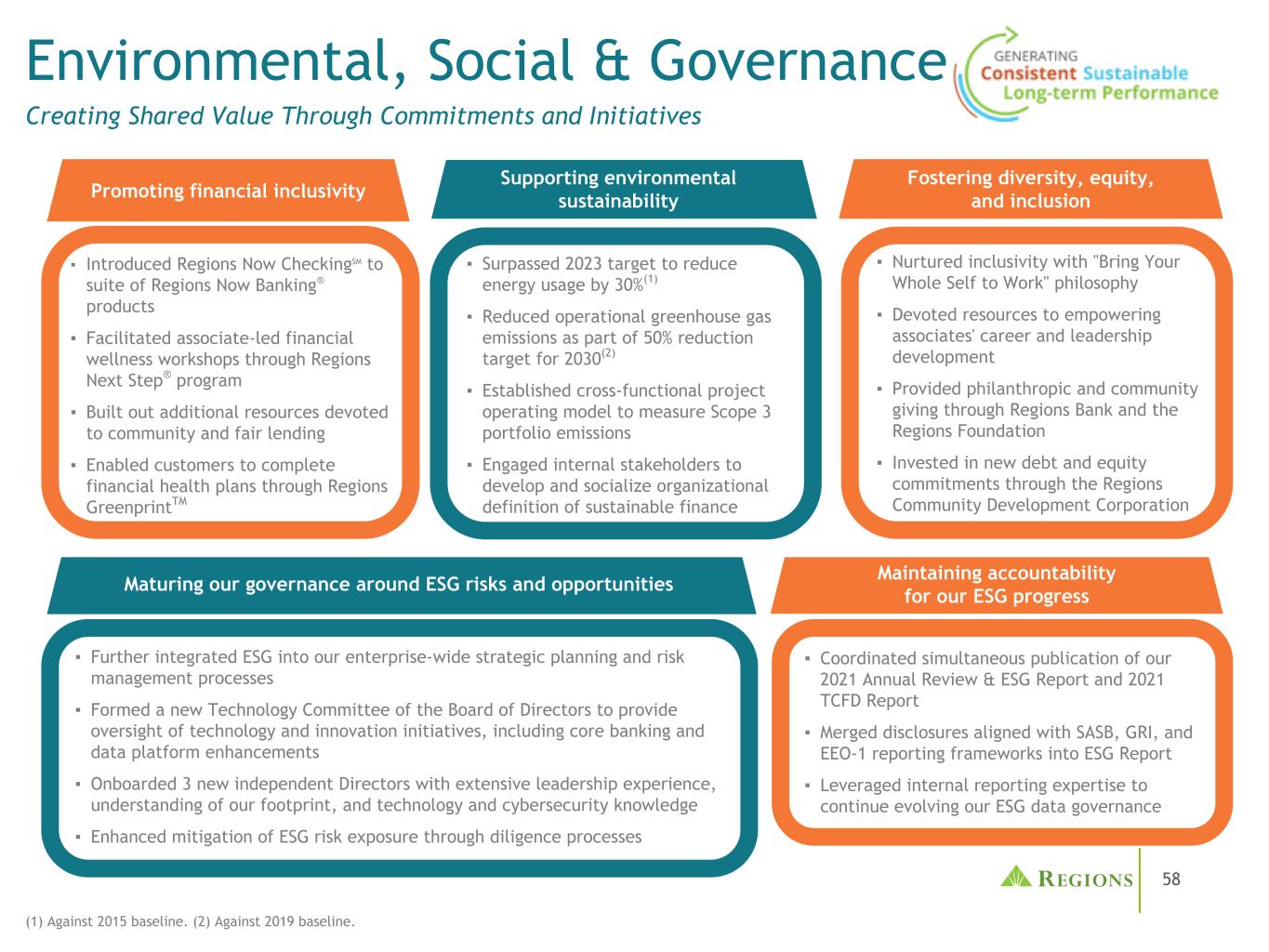
58 Promoting financial inclusivity Supporting environmental sustainability Maintaining accountability for our ESG progress ▪ Further integrated ESG into our enterprise-wide strategic planning and risk management processes ▪ Formed a new Technology Committee of the Board of Directors to provide oversight of technology and innovation initiatives, including core banking and data platform enhancements ▪ Onboarded 3 new independent Directors with extensive leadership experience, understanding of our footprint, and technology and cybersecurity knowledge ▪ Enhanced mitigation of ESG risk exposure through diligence processes ▪ Introduced Regions Now CheckingSM to suite of Regions Now Banking® products ▪ Facilitated associate-led financial wellness workshops through Regions Next Step® program ▪ Built out additional resources devoted to community and fair lending ▪ Enabled customers to complete financial health plans through Regions GreenprintTM ▪ Surpassed 2023 target to reduce energy usage by 30%(1) ▪ Reduced operational greenhouse gas emissions as part of 50% reduction target for 2030(2) ▪ Established cross-functional project operating model to measure Scope 3 portfolio emissions ▪ Engaged internal stakeholders to develop and socialize organizational definition of sustainable finance ▪ Nurtured inclusivity with "Bring Your Whole Self to Work" philosophy ▪ Devoted resources to empowering associates' career and leadership development ▪ Provided philanthropic and community giving through Regions Bank and the Regions Foundation ▪ Invested in new debt and equity commitments through the Regions Community Development Corporation Fostering diversity, equity, and inclusion Maturing our governance around ESG risks and opportunities ▪ Coordinated simultaneous publication of our 2021 Annual Review & ESG Report and 2021 TCFD Report ▪ Merged disclosures aligned with SASB, GRI, and EEO-1 reporting frameworks into ESG Report ▪ Leveraged internal reporting expertise to continue evolving our ESG data governance Environmental, Social & Governance Creating Shared Value Through Commitments and Initiatives (1) Against 2015 baseline. (2) Against 2019 baseline.

59 LIBOR Transition The Last Act Moving to Final Phase of Transition Path to Completing the Transition From LIBOR For almost two years Regions has been originating loans and derivatives using alternative indexes. Over the past three quarters focus has been on proactive remediation of specific legacy LIBOR contracts. Amendment activity will continue through Q1 with very few amendments planned for Q2. Focus now shifts to fallbacks where Regions will be notifying customers and testing systems to ensure a smooth transition after cessation. Highlights Jun 30, 2023 Last Day USD LIBOR will be published Term SOFR + CSA Fallback rate for Commercial LIBOR loans when Regions has the discretion to choose Fallback Amendment • After June 30, 2023 Regions will implement the fallback language in existing LIBOR contracts • Regions has reviewed all LIBOR contracts and categorized fallback • Regions will follow guidance of the LIBOR Act for selecting a rate for falling back • Notifications will be distributed to impacted customers in 1Q23 • Many contracts have already been amended to move away from LIBOR and more are planned • Contracts might be amended based on fallback language or because of LIBOR derivatives which will be amended in parallel • Regions is ensuring that amended contracts that fall within guidance are identified for tax/ accounting relief for LIBOR transition ◦ Discontinue LIBOR lending ◦ Introduce alternative indexes ◦ Launch LIBOR Remediation Tracker tool ◦ Train associates on proactive remediation ◦ Choose fallback index for "Bank's Sole Discretion" fallback loans ◦ Complete most of proactive remediation ◦ Complete all proactive remediation ◦ Preload fallbacks as necessary ◦ Establish LIBOR Remediation Strategy ◦ Build LIBOR Remediation Tracker tool ◦ Finalize monthly remediation execution plan ◦ Begin proactive remediation (amendments) ◦ Communicate fallbacks to impacted customers ◦ Conduct systems testing for fallback ◦ Implement fallbacks 2019-2021 Q2 2022 Q1 2022 Q3 2022 Q4 2022 Q1 2023 Q2 2023 June 30, 2023 Refinitiv USD IBOR Cash Fallbacks Fallback rate for Consumer LIBOR ARMs
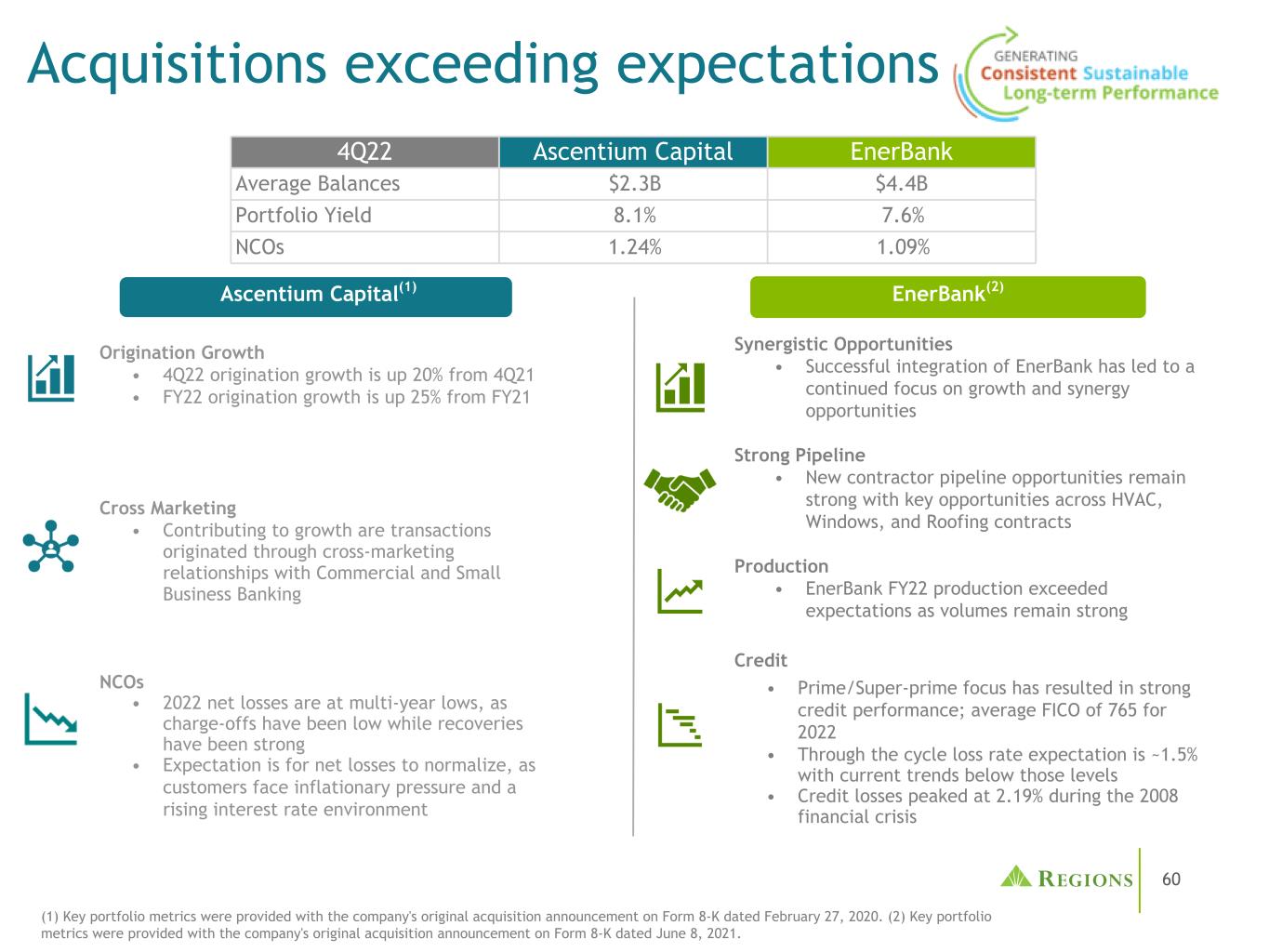
60 Acquisitions exceeding expectations Ascentium Capital(1) EnerBank(2) Origination Growth • 4Q22 origination growth is up 20% from 4Q21 • FY22 origination growth is up 25% from FY21 Cross Marketing • Contributing to growth are transactions originated through cross-marketing relationships with Commercial and Small Business Banking NCOs • 2022 net losses are at multi-year lows, as charge-offs have been low while recoveries have been strong • Expectation is for net losses to normalize, as customers face inflationary pressure and a rising interest rate environment Synergistic Opportunities • Successful integration of EnerBank has led to a continued focus on growth and synergy opportunities Strong Pipeline • New contractor pipeline opportunities remain strong with key opportunities across HVAC, Windows, and Roofing contracts Production • EnerBank FY22 production exceeded expectations as volumes remain strong Credit • Prime/Super-prime focus has resulted in strong credit performance; average FICO of 765 for 2022 • Through the cycle loss rate expectation is ~1.5% with current trends below those levels • Credit losses peaked at 2.19% during the 2008 financial crisis (1) Key portfolio metrics were provided with the company's original acquisition announcement on Form 8-K dated February 27, 2020. (2) Key portfolio metrics were provided with the company's original acquisition announcement on Form 8-K dated June 8, 2021. 4Q22 Ascentium Capital EnerBank Average Balances $2.3B $4.4B Portfolio Yield 8.1% 7.6% NCOs 1.24% 1.09%

61 APPENDIX
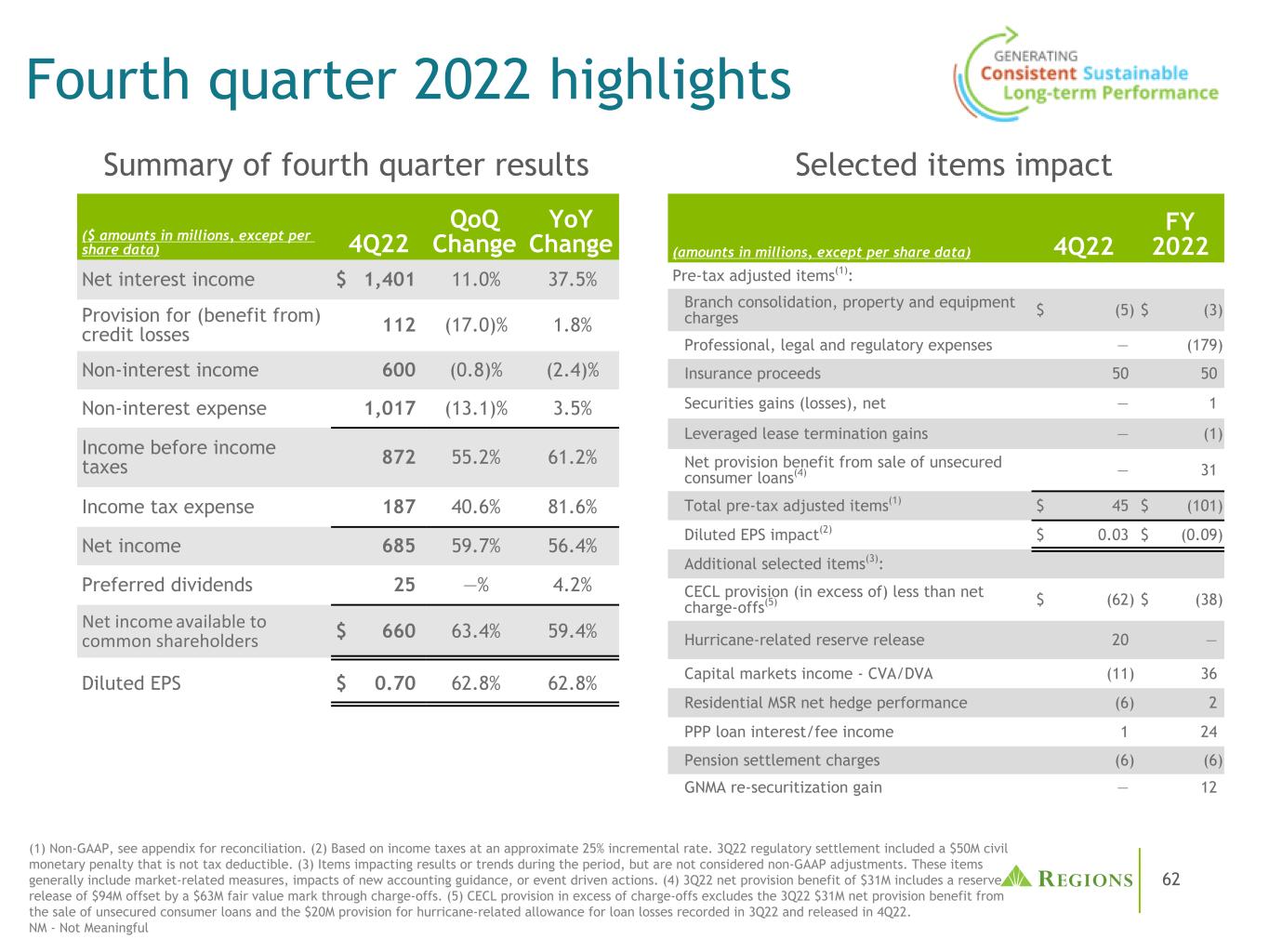
62 Selected items impact Fourth quarter 2022 highlights (1) Non-GAAP, see appendix for reconciliation. (2) Based on income taxes at an approximate 25% incremental rate. 3Q22 regulatory settlement included a $50M civil monetary penalty that is not tax deductible. (3) Items impacting results or trends during the period, but are not considered non-GAAP adjustments. These items generally include market-related measures, impacts of new accounting guidance, or event driven actions. (4) 3Q22 net provision benefit of $31M includes a reserve release of $94M offset by a $63M fair value mark through charge-offs. (5) CECL provision in excess of charge-offs excludes the 3Q22 $31M net provision benefit from the sale of unsecured consumer loans and the $20M provision for hurricane-related allowance for loan losses recorded in 3Q22 and released in 4Q22. NM - Not Meaningful ($ amounts in millions, except per share data) 4Q22 QoQ Change YoY Change Net interest income $ 1,401 11.0% 37.5% Provision for (benefit from) credit losses 112 (17.0)% 1.8% Non-interest income 600 (0.8)% (2.4)% Non-interest expense 1,017 (13.1)% 3.5% Income before income taxes 872 55.2% 61.2% Income tax expense 187 40.6% 81.6% Net income 685 59.7% 56.4% Preferred dividends 25 —% 4.2% Net income available to common shareholders $ 660 63.4% 59.4% Diluted EPS $ 0.70 62.8% 62.8% Summary of fourth quarter results (amounts in millions, except per share data) 4Q22 FY 2022 Pre-tax adjusted items(1): Branch consolidation, property and equipment charges $ (5) $ (3) Professional, legal and regulatory expenses — (179) Insurance proceeds 50 50 Securities gains (losses), net — 1 Leveraged lease termination gains — (1) Net provision benefit from sale of unsecured consumer loans(4) — 31 Total pre-tax adjusted items(1) $ 45 $ (101) Diluted EPS impact(2) $ 0.03 $ (0.09) Additional selected items(3): CECL provision (in excess of) less than net charge-offs(5) $ (62) $ (38) Hurricane-related reserve release 20 — Capital markets income - CVA/DVA (11) 36 Residential MSR net hedge performance (6) 2 PPP loan interest/fee income 1 24 Pension settlement charges (6) (6) GNMA re-securitization gain — 12
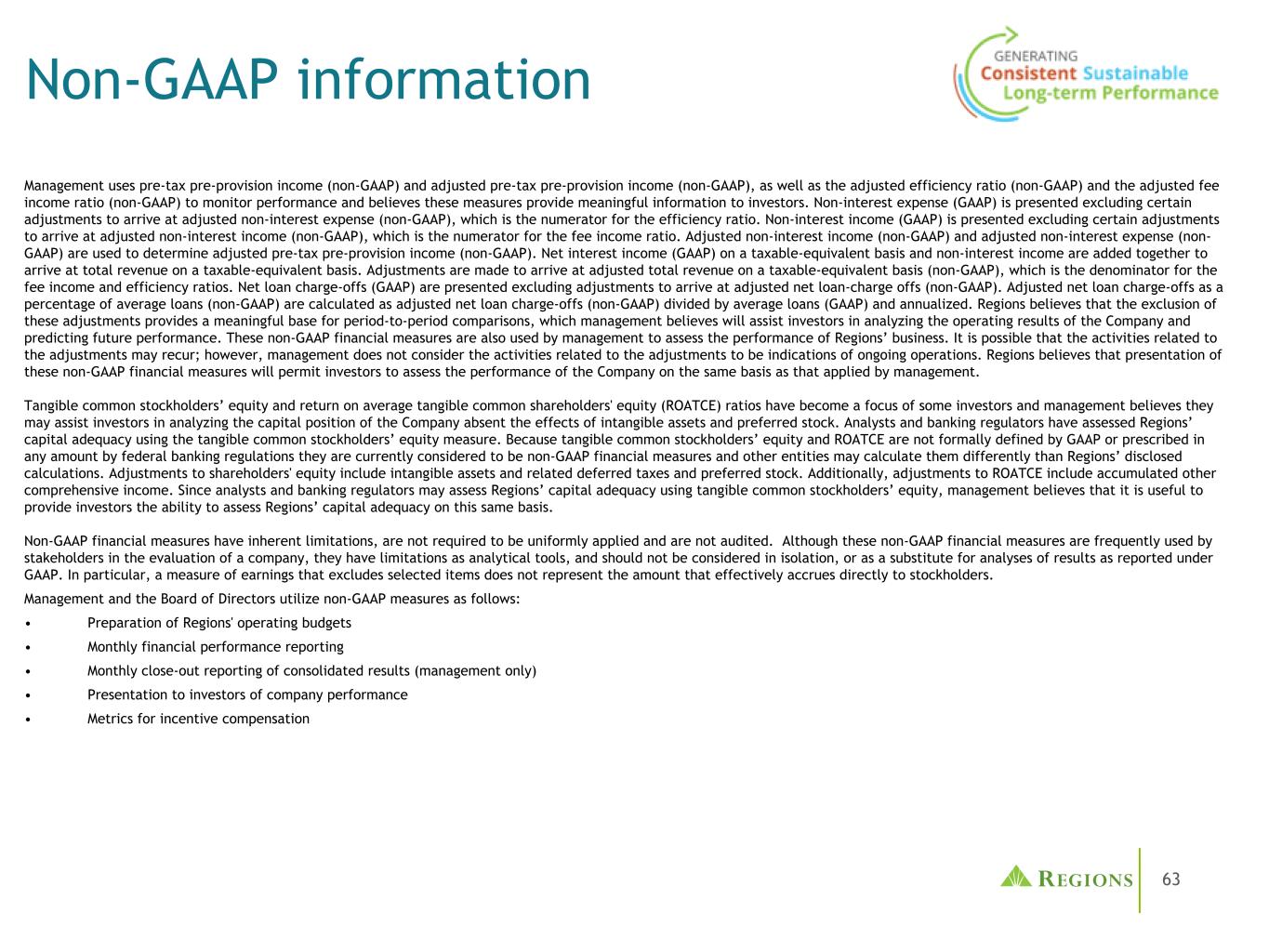
63 Management uses pre-tax pre-provision income (non-GAAP) and adjusted pre-tax pre-provision income (non-GAAP), as well as the adjusted efficiency ratio (non-GAAP) and the adjusted fee income ratio (non-GAAP) to monitor performance and believes these measures provide meaningful information to investors. Non-interest expense (GAAP) is presented excluding certain adjustments to arrive at adjusted non-interest expense (non-GAAP), which is the numerator for the efficiency ratio. Non-interest income (GAAP) is presented excluding certain adjustments to arrive at adjusted non-interest income (non-GAAP), which is the numerator for the fee income ratio. Adjusted non-interest income (non-GAAP) and adjusted non-interest expense (non- GAAP) are used to determine adjusted pre-tax pre-provision income (non-GAAP). Net interest income (GAAP) on a taxable-equivalent basis and non-interest income are added together to arrive at total revenue on a taxable-equivalent basis. Adjustments are made to arrive at adjusted total revenue on a taxable-equivalent basis (non-GAAP), which is the denominator for the fee income and efficiency ratios. Net loan charge-offs (GAAP) are presented excluding adjustments to arrive at adjusted net loan-charge offs (non-GAAP). Adjusted net loan charge-offs as a percentage of average loans (non-GAAP) are calculated as adjusted net loan charge-offs (non-GAAP) divided by average loans (GAAP) and annualized. Regions believes that the exclusion of these adjustments provides a meaningful base for period-to-period comparisons, which management believes will assist investors in analyzing the operating results of the Company and predicting future performance. These non-GAAP financial measures are also used by management to assess the performance of Regions’ business. It is possible that the activities related to the adjustments may recur; however, management does not consider the activities related to the adjustments to be indications of ongoing operations. Regions believes that presentation of these non-GAAP financial measures will permit investors to assess the performance of the Company on the same basis as that applied by management. Tangible common stockholders’ equity and return on average tangible common shareholders' equity (ROATCE) ratios have become a focus of some investors and management believes they may assist investors in analyzing the capital position of the Company absent the effects of intangible assets and preferred stock. Analysts and banking regulators have assessed Regions’ capital adequacy using the tangible common stockholders’ equity measure. Because tangible common stockholders’ equity and ROATCE are not formally defined by GAAP or prescribed in any amount by federal banking regulations they are currently considered to be non-GAAP financial measures and other entities may calculate them differently than Regions’ disclosed calculations. Adjustments to shareholders' equity include intangible assets and related deferred taxes and preferred stock. Additionally, adjustments to ROATCE include accumulated other comprehensive income. Since analysts and banking regulators may assess Regions’ capital adequacy using tangible common stockholders’ equity, management believes that it is useful to provide investors the ability to assess Regions’ capital adequacy on this same basis. Non-GAAP financial measures have inherent limitations, are not required to be uniformly applied and are not audited. Although these non-GAAP financial measures are frequently used by stakeholders in the evaluation of a company, they have limitations as analytical tools, and should not be considered in isolation, or as a substitute for analyses of results as reported under GAAP. In particular, a measure of earnings that excludes selected items does not represent the amount that effectively accrues directly to stockholders. Management and the Board of Directors utilize non-GAAP measures as follows: • Preparation of Regions' operating budgets • Monthly financial performance reporting • Monthly close-out reporting of consolidated results (management only) • Presentation to investors of company performance • Metrics for incentive compensation Non-GAAP information

64 Non-GAAP reconciliation Adjusted Net Charge-Offs and Ratio Year-Ended For the Quarter Ended ($ amounts in millions) 2022 2021 12/31/2022 9/30/2022 6/30/2022 3/31/2022 12/31/2021 Net loan charge-offs (GAAP) $ 263 $ 204 $ 69 $ 110 $ 38 $ 46 $ 44 Less: charge-offs associated with the sale of unsecured consumer loans 63 — — 63 — — — Adjusted net loan charge-offs (non-GAAP) $ 200 $ 204 $ 69 $ 47 $ 38 $ 46 $ 44 Net loan charge-offs as a % of average loans, annualized (GAAP) 0.29% 0.24% 0.29 % 0.46 % 0.17 % 0.21 % 0.20 % Adjusted net loan charge-offs as a % of average loans, annualized (non-GAAP) 0.22% 0.24% 0.29 % 0.19 % 0.17 % 0.21 % 0.20 %

65 Non-GAAP reconciliation Pre-tax pre-provision income (PPI) Year Ended Quarter Ended ($ amounts in millions) 2022 12/31/2022 9/30/2022 6/30/2022 3/31/2022 12/31/2021 4Q22 vs. 3Q22 4Q22 vs. 4Q21 Net income available to common shareholders (GAAP) $ 2,146 $ 660 $ 404 $ 558 $ 524 $ 414 $ 256 63.4 % $ 246 59.4 % Preferred dividends (GAAP) 99 25 25 25 24 24 — — % 1 4.2 % Income tax expense (GAAP) 631 187 133 157 154 103 54 40.6 % 84 81.6 % Income before income taxes (GAAP) 2,876 872 562 740 702 541 310 55.2 % 331 61.2 % Provision for (benefit from) credit losses (GAAP) 271 112 135 60 (36) 110 (23) (17.0) % 2 1.8 % Pre-tax pre-provision income (non-GAAP) 3,147 984 697 800 666 651 287 41.2 % 333 51.2 % Other adjustments: Securities (gains) losses, net 1 — 1 — — — (1) (100.0) % — NM Leveraged lease termination gains, net (1) — — — (1) — — NM — NM Insurance proceeds (50) (50) — — — — (50) NM (50) NM Salaries and employee benefits—severance charges — — — — — 1 — NM (1) (100.0) % Branch consolidation, property and equipment charges 3 5 3 (6) 1 — 2 66.7 % 5 NM Professional, legal and regulatory expenses 179 — 179 — — 15 (179) (100.0) % (15) (100.0) % Total other adjustments 132 (45) 183 (6) — 16 (228) (124.6) % (61) (381.3) % Adjusted pre-tax pre-provision income (non-GAAP) $ 3,279 $ 939 $ 880 $ 794 $ 666 $ 667 $ 59 6.7 % $ 272 40.8 % NM - Not Meaningful

66 Non-GAAP reconciliation NII, non-interest income/expense, and efficiency ratio NM - Not Meaningful Quarter Ended ($ amounts in millions) 12/31/2022 9/30/2022 6/30/2022 3/31/2022 12/31/2021 4Q22 vs. 3Q22 4Q22 vs. 4Q21 Non-interest expense (GAAP) A $ 1,017 $ 1,170 $ 948 $ 933 $ 983 $ (153) (13.1) % $ 34 3.5 % Adjustments: Branch consolidation, property and equipment charges (5) (3) 6 (1) — (2) (66.7) % (5) NM Salary and employee benefits—severance charges — — — — (1) — NM 1 100.0 % Professional, legal and regulatory expenses — (179) — — (15) 179 100.0 % 15 100.0 % Adjusted non-interest expense (non-GAAP) B $ 1,012 $ 988 $ 954 $ 932 $ 967 $ 24 2.4 % $ 45 4.7 % Net interest income (GAAP) C $ 1,401 $ 1,262 $ 1,108 $ 1,015 $ 1,019 $ 139 11.0 % $ 382 37.5 % Taxable-equivalent adjustment 13 12 11 11 10 1 8.3 % 3 30.0 % Net interest income, taxable-equivalent basis D $ 1,414 $ 1,274 $ 1,119 $ 1,026 $ 1,029 $ 140 11.0 % $ 385 37.4 % Non-interest income (GAAP) E 600 605 640 584 615 (5) (0.8) % (15) (2.4) % Adjustments: Securities (gains) losses, net — 1 — — — (1) (100.0) % — NM Leveraged lease termination gains — — — (1) — — NM — NM Insurance Proceeds (50) — — — — (50) NM (50) NM Adjusted non-interest income (non-GAAP) F $ 550 $ 606 $ 640 $ 583 $ 615 (56) (9.2) % $ (65) (10.6) % Total revenue C+E=G $ 2,001 $ 1,867 $ 1,748 $ 1,599 $ 1,634 $ 134 7.2 % $ 367 22.5 % Adjusted total revenue (non-GAAP) C+F=H $ 1,951 $ 1,868 $ 1,748 $ 1,598 $ 1,634 $ 83 4.4 % $ 317 19.4 % Total revenue, taxable-equivalent basis D+E=I $ 2,014 $ 1,879 $ 1,759 $ 1,610 $ 1,644 $ 135 7.2 % $ 370 22.5 % Adjusted total revenue, taxable-equivalent basis (non-GAAP) D+F=J $ 1,964 $ 1,880 $ 1,759 $ 1,609 $ 1,644 $ 84 4.5 % $ 320 19.5 % Efficiency ratio (GAAP) A/I 50.5 % 62.3 % 53.9 % 57.9 % 59.8 % Adjusted efficiency ratio (non-GAAP) B/J 51.6 % 52.6 % 54.2 % 57.9 % 58.8 % Fee income ratio (GAAP) E/I 29.8 % 32.2 % 36.4 % 36.3 % 37.4 % Adjusted fee income ratio (non-GAAP) F/J 28.0 % 32.2 % 36.4 % 36.2 % 37.4 %
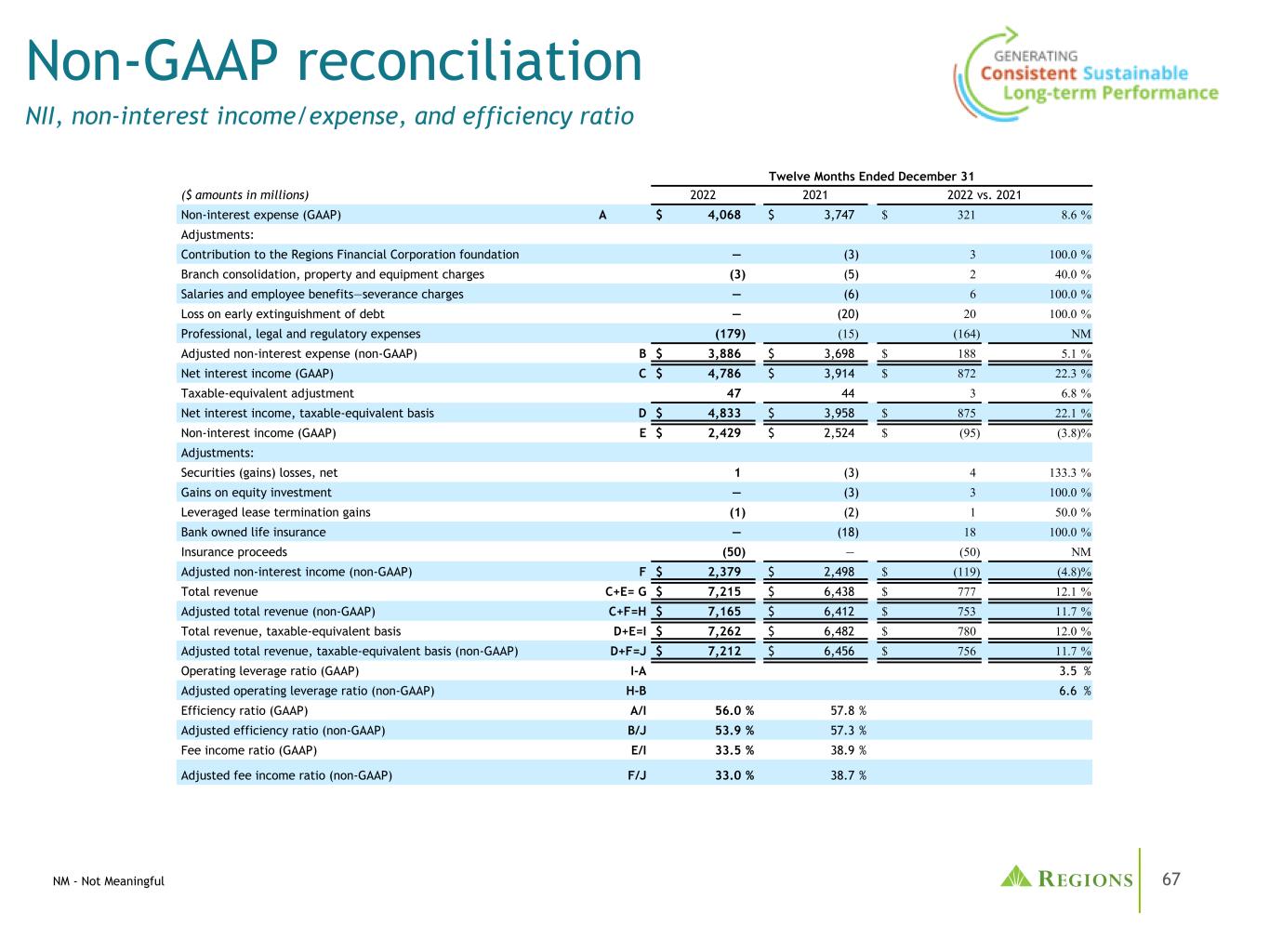
67 Non-GAAP reconciliation NII, non-interest income/expense, and efficiency ratio NM - Not Meaningful Twelve Months Ended December 31 ($ amounts in millions) 2022 2021 2022 vs. 2021 Non-interest expense (GAAP) A $ 4,068 $ 3,747 $ 321 8.6 % Adjustments: Contribution to the Regions Financial Corporation foundation — (3) 3 100.0 % Branch consolidation, property and equipment charges (3) (5) 2 40.0 % Salaries and employee benefits—severance charges — (6) 6 100.0 % Loss on early extinguishment of debt — (20) 20 100.0 % Professional, legal and regulatory expenses (179) (15) (164) NM Adjusted non-interest expense (non-GAAP) B $ 3,886 $ 3,698 $ 188 5.1 % Net interest income (GAAP) C $ 4,786 $ 3,914 $ 872 22.3 % Taxable-equivalent adjustment 47 44 3 6.8 % Net interest income, taxable-equivalent basis D $ 4,833 $ 3,958 $ 875 22.1 % Non-interest income (GAAP) E $ 2,429 $ 2,524 $ (95) (3.8) % Adjustments: Securities (gains) losses, net 1 (3) 4 133.3 % Gains on equity investment — (3) 3 100.0 % Leveraged lease termination gains (1) (2) 1 50.0 % Bank owned life insurance — (18) 18 100.0 % Insurance proceeds (50) — (50) NM Adjusted non-interest income (non-GAAP) F $ 2,379 $ 2,498 $ (119) (4.8) % Total revenue C+E= G $ 7,215 $ 6,438 $ 777 12.1 % Adjusted total revenue (non-GAAP) C+F=H $ 7,165 $ 6,412 $ 753 11.7 % Total revenue, taxable-equivalent basis D+E=I $ 7,262 $ 6,482 $ 780 12.0 % Adjusted total revenue, taxable-equivalent basis (non-GAAP) D+F=J $ 7,212 $ 6,456 $ 756 11.7 % Operating leverage ratio (GAAP) I-A 3.5 % Adjusted operating leverage ratio (non-GAAP) H-B 6.6 % Efficiency ratio (GAAP) A/I 56.0 % 57.8 % Adjusted efficiency ratio (non-GAAP) B/J 53.9 % 57.3 % Fee income ratio (GAAP) E/I 33.5 % 38.9 % Adjusted fee income ratio (non-GAAP) F/J 33.0 % 38.7 %

68 Non-GAAP reconciliation Non-interest income Year Ended ($ amounts in millions) 2022 2021 2020 2019 2018 2017 2016 2015 2014 2013 2012 2011 Non-interest income (GAAP) $ 2,429 $ 2,524 $ 2,393 $ 2,116 $ 2,019 $ 1,962 $ 2,011 $ 1,937 $ 1,785 $ 2,096 $ 2,201 $ 2,226 Security (gains) losses, net 1 (3) (4) 28 (1) (19) (6) (29) (27) (26) (48) (112) Bank Owned Life Insurance - Adusted Items — (18) (25) — — — — — — — — — Leverage Lease Terminations Inc (1) (2) (2) (1) (8) (1) (8) (8) (10) (39) (14) (8) Loss on sale of mortgage loans — — — — — — — — — — — 3 Gain on sale of other assets — — — — — — — — — (24) — — Gain on sale of affordable housing residential mortgage loans — — — (8) — (5) (5) — — — — — Gains on equity investment — (3) (50) — — — — — — — — — Insurance proceeds (50) — — — — — (50) (91) — — — — Adjusted non-interest income (non- GAAP) $ 2,379 $ 2,498 $ 2,312 $ 2,135 $ 2,010 $ 1,937 $ 1,942 $ 1,809 $ 1,748 $ 2,007 $ 2,139 $ 2,109
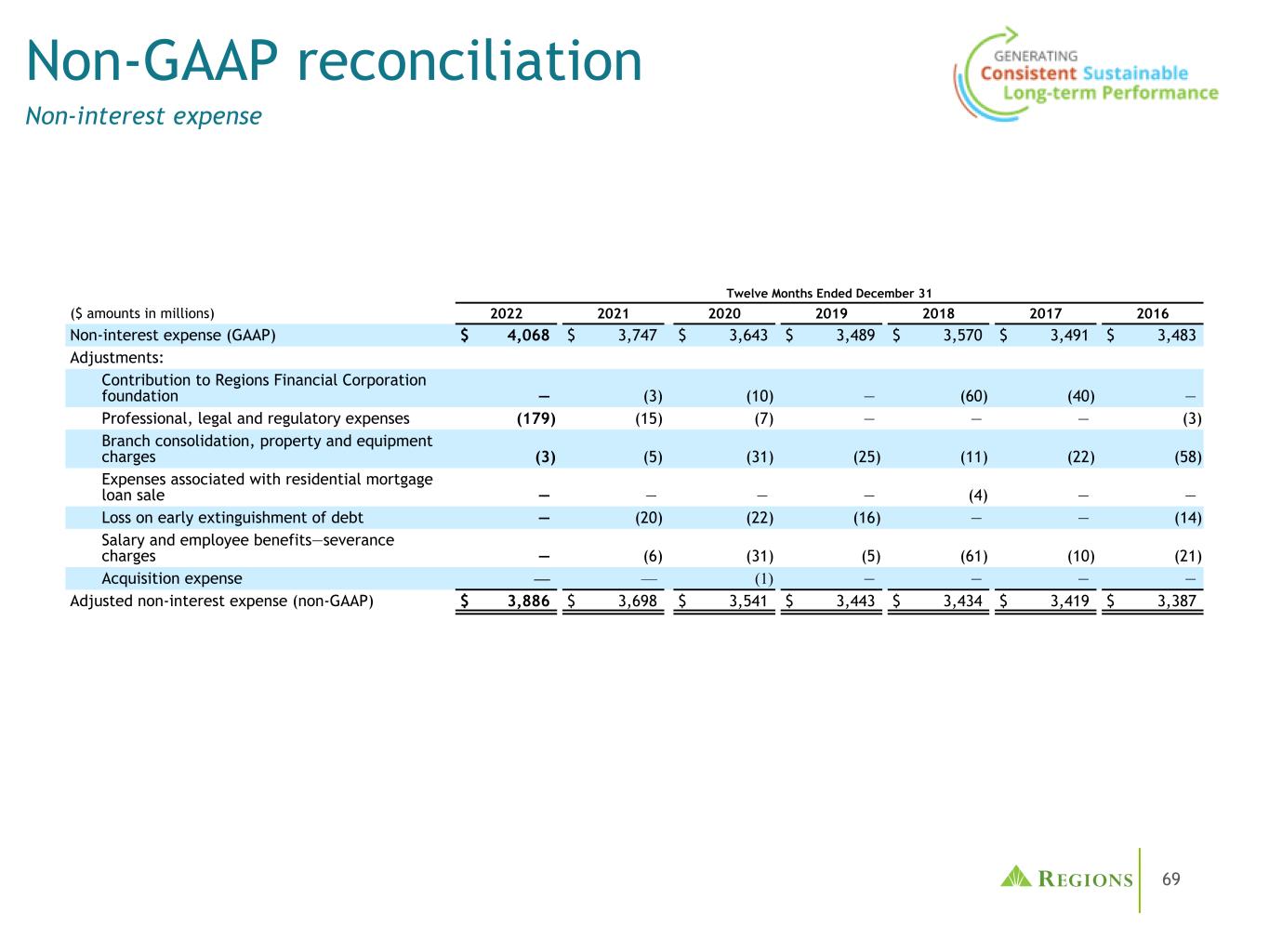
69 Non-GAAP reconciliation Non-interest expense Twelve Months Ended December 31 ($ amounts in millions) 2022 2021 2020 2019 2018 2017 2016 Non-interest expense (GAAP) $ 4,068 $ 3,747 $ 3,643 $ 3,489 $ 3,570 $ 3,491 $ 3,483 Adjustments: Contribution to Regions Financial Corporation foundation — (3) (10) — (60) (40) — Professional, legal and regulatory expenses (179) (15) (7) — — — (3) Branch consolidation, property and equipment charges (3) (5) (31) (25) (11) (22) (58) Expenses associated with residential mortgage loan sale — — — — (4) — — Loss on early extinguishment of debt — (20) (22) (16) — — (14) Salary and employee benefits—severance charges — (6) (31) (5) (61) (10) (21) Acquisition expense — — (1) — — — — Adjusted non-interest expense (non-GAAP) $ 3,886 $ 3,698 $ 3,541 $ 3,443 $ 3,434 $ 3,419 $ 3,387
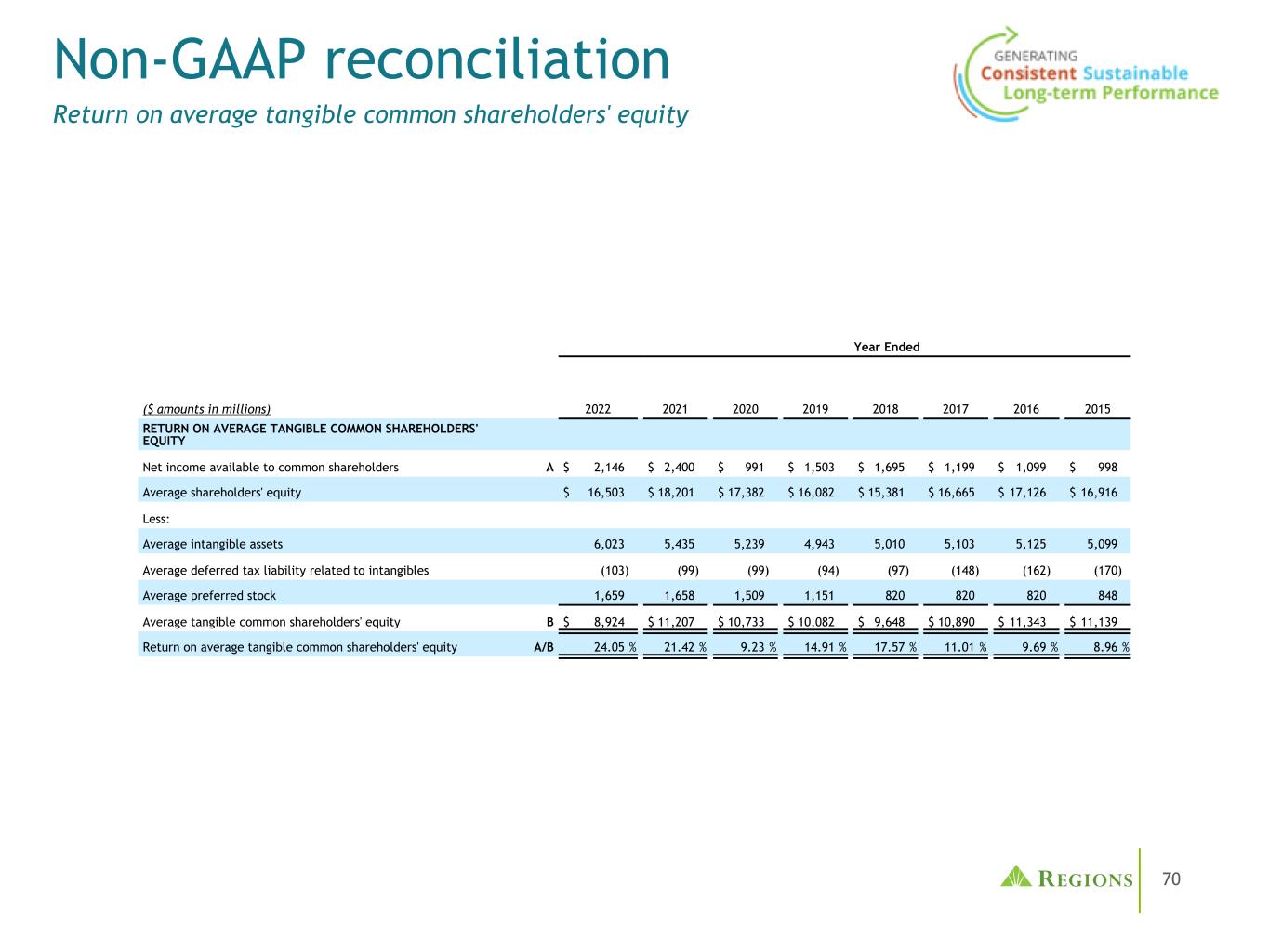
70 Non-GAAP reconciliation Return on average tangible common shareholders' equity Year Ended ($ amounts in millions) 2022 2021 2020 2019 2018 2017 2016 2015 RETURN ON AVERAGE TANGIBLE COMMON SHAREHOLDERS' EQUITY Net income available to common shareholders A $ 2,146 $ 2,400 $ 991 $ 1,503 $ 1,695 $ 1,199 $ 1,099 $ 998 Average shareholders' equity $ 16,503 $ 18,201 $ 17,382 $ 16,082 $ 15,381 $ 16,665 $ 17,126 $ 16,916 Less: Average intangible assets 6,023 5,435 5,239 4,943 5,010 5,103 5,125 5,099 Average deferred tax liability related to intangibles (103) (99) (99) (94) (97) (148) (162) (170) Average preferred stock 1,659 1,658 1,509 1,151 820 820 820 848 Average tangible common shareholders' equity B $ 8,924 $ 11,207 $ 10,733 $ 10,082 $ 9,648 $ 10,890 $ 11,343 $ 11,139 Return on average tangible common shareholders' equity A/B 24.05 % 21.42 % 9.23 % 14.91 % 17.57 % 11.01 % 9.69 % 8.96 %

71 Year-Ended ($ amounts in millions) 2022 2021 RETURN ON AVERAGE TANGIBLE COMMON SHAREHOLDERS' EQUITY Net income available to common shareholders (GAAP) A $ 2,146 $ 2,400 Average shareholders' equity (GAAP) $ 16,503 $ 18,201 Less: Average intangible assets (GAAP) 6,023 5,435 Average deferred tax liability related to intangibles (GAAP) (103) (99) Average preferred stock (GAAP) 1,659 1,658 Average tangible common shareholders' equity (non-GAAP) B $ 8,924 $ 11,207 Less: Average AOCI, after-tax (2,021) 705 Average tangible common shareholders' equity excluding AOCI (non- GAAP) C $ 10,945 $ 10,502 Return on average tangible common shareholders' equity, annualized (non-GAAP) A/B 24.05 % 21.42 % Return on average tangible common shareholders' equity excluding AOCI, annualized (non-GAAP) A/C 19.61 % 22.85 % Non-GAAP reconciliation Return on average tangible common shareholders' equity

72 Non-GAAP reconciliation Tangible Common Ratios As of and for Quarter Ended ($ amounts in millions, except per share data) 12/31/2022 9/30/2022 6/30/2022 3/31/2022 12/31/2021 TANGIBLE COMMON RATIOS Shareholders’ equity (GAAP) A $ 15,947 $ 15,173 $ 16,507 $ 16,982 $ 18,326 Less: Preferred stock (GAAP) 1,659 1,659 1,659 1,659 1,659 Intangible assets (GAAP) 5,982 6,005 6,028 6,040 6,049 Deferred tax liability related to intangibles (GAAP) (103) (105) (104) (101) (100) Tangible common shareholders’ equity (non-GAAP) B $ 8,409 $ 7,614 $ 8,924 $ 9,384 $ 10,718 Less: AOCI, after-tax (3,343) (3,632) (2,067) (1,214) 289 Tangible common shareholders’ equity excluding AOCI (non-GAAP) C $ 11,752 $ 11,246 $ 10,991 $ 10,598 $ 10,429 Total assets (GAAP) D $ 155,220 $ 157,798 $ 160,908 $ 164,082 $ 162,938 Less: Intangible assets (GAAP) 5,982 6,005 6,028 6,040 6,049 Deferred tax liability related to intangibles (GAAP) (103) (105) (104) (101) (100) Tangible assets (non-GAAP) E $ 149,341 $ 151,898 $ 154,984 $ 158,143 $ 156,989 Less: AOCI, pre-tax $ (4,481) $ (4,871) $ (2,772) $ (1,629) $ 387 Tangible assets excluding AOCI (non-GAAP) F $ 153,822 $ 156,769 $ 157,756 $ 159,772 $ 156,602 Shares outstanding—end of quarter G 934 934 934 933 942 Total equity to total assets (GAAP) A/D 10.27 % 9.62 % 10.26 % 10.35 % 11.25 % Tangible common shareholders’ equity to tangible assets (non-GAAP) B/E 5.63 % 5.01 % 5.76 % 5.93 % 6.83 % Tangible common book value per share (non-GAAP) B/G $ 9.00 $ 8.15 $ 9.55 $ 10.06 $ 11.38 Tangible common shareholders’ equity to tangible Assests (non- GAAP), ex. AOCI C/F 7.64 % 7.17 % 6.97 % 6.63 % 6.66 %
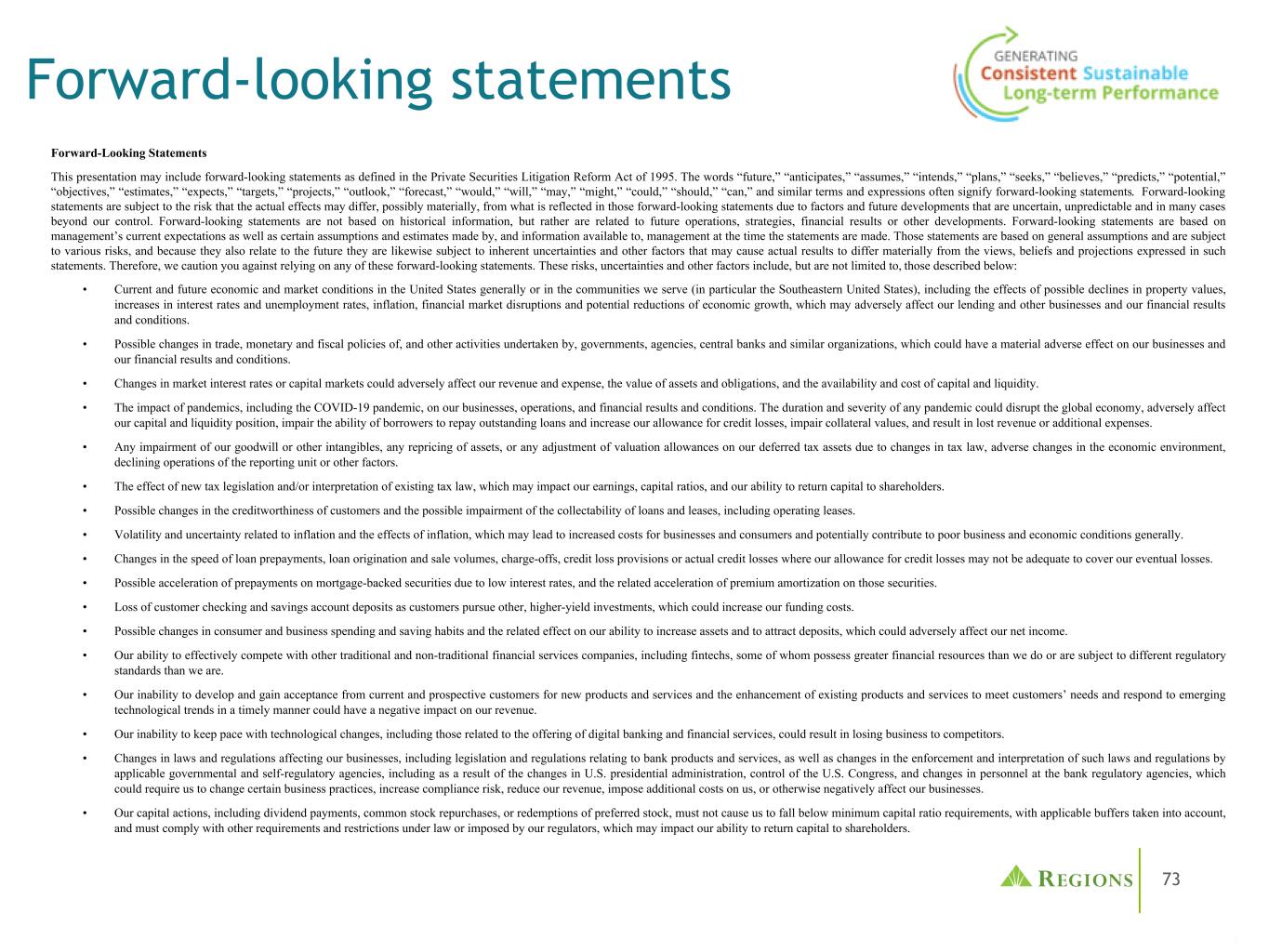
73 Forward-Looking Statements This presentation may include forward-looking statements as defined in the Private Securities Litigation Reform Act of 1995. The words “future,” “anticipates,” “assumes,” “intends,” “plans,” “seeks,” “believes,” “predicts,” “potential,” “objectives,” “estimates,” “expects,” “targets,” “projects,” “outlook,” “forecast,” “would,” “will,” “may,” “might,” “could,” “should,” “can,” and similar terms and expressions often signify forward-looking statements. Forward-looking statements are subject to the risk that the actual effects may differ, possibly materially, from what is reflected in those forward-looking statements due to factors and future developments that are uncertain, unpredictable and in many cases beyond our control. Forward-looking statements are not based on historical information, but rather are related to future operations, strategies, financial results or other developments. Forward-looking statements are based on management’s current expectations as well as certain assumptions and estimates made by, and information available to, management at the time the statements are made. Those statements are based on general assumptions and are subject to various risks, and because they also relate to the future they are likewise subject to inherent uncertainties and other factors that may cause actual results to differ materially from the views, beliefs and projections expressed in such statements. Therefore, we caution you against relying on any of these forward-looking statements. These risks, uncertainties and other factors include, but are not limited to, those described below: • Current and future economic and market conditions in the United States generally or in the communities we serve (in particular the Southeastern United States), including the effects of possible declines in property values, increases in interest rates and unemployment rates, inflation, financial market disruptions and potential reductions of economic growth, which may adversely affect our lending and other businesses and our financial results and conditions. • Possible changes in trade, monetary and fiscal policies of, and other activities undertaken by, governments, agencies, central banks and similar organizations, which could have a material adverse effect on our businesses and our financial results and conditions. • Changes in market interest rates or capital markets could adversely affect our revenue and expense, the value of assets and obligations, and the availability and cost of capital and liquidity. • The impact of pandemics, including the COVID-19 pandemic, on our businesses, operations, and financial results and conditions. The duration and severity of any pandemic could disrupt the global economy, adversely affect our capital and liquidity position, impair the ability of borrowers to repay outstanding loans and increase our allowance for credit losses, impair collateral values, and result in lost revenue or additional expenses. • Any impairment of our goodwill or other intangibles, any repricing of assets, or any adjustment of valuation allowances on our deferred tax assets due to changes in tax law, adverse changes in the economic environment, declining operations of the reporting unit or other factors. • The effect of new tax legislation and/or interpretation of existing tax law, which may impact our earnings, capital ratios, and our ability to return capital to shareholders. • Possible changes in the creditworthiness of customers and the possible impairment of the collectability of loans and leases, including operating leases. • Volatility and uncertainty related to inflation and the effects of inflation, which may lead to increased costs for businesses and consumers and potentially contribute to poor business and economic conditions generally. • Changes in the speed of loan prepayments, loan origination and sale volumes, charge-offs, credit loss provisions or actual credit losses where our allowance for credit losses may not be adequate to cover our eventual losses. • Possible acceleration of prepayments on mortgage-backed securities due to low interest rates, and the related acceleration of premium amortization on those securities. • Loss of customer checking and savings account deposits as customers pursue other, higher-yield investments, which could increase our funding costs. • Possible changes in consumer and business spending and saving habits and the related effect on our ability to increase assets and to attract deposits, which could adversely affect our net income. • Our ability to effectively compete with other traditional and non-traditional financial services companies, including fintechs, some of whom possess greater financial resources than we do or are subject to different regulatory standards than we are. • Our inability to develop and gain acceptance from current and prospective customers for new products and services and the enhancement of existing products and services to meet customers’ needs and respond to emerging technological trends in a timely manner could have a negative impact on our revenue. • Our inability to keep pace with technological changes, including those related to the offering of digital banking and financial services, could result in losing business to competitors. • Changes in laws and regulations affecting our businesses, including legislation and regulations relating to bank products and services, as well as changes in the enforcement and interpretation of such laws and regulations by applicable governmental and self-regulatory agencies, including as a result of the changes in U.S. presidential administration, control of the U.S. Congress, and changes in personnel at the bank regulatory agencies, which could require us to change certain business practices, increase compliance risk, reduce our revenue, impose additional costs on us, or otherwise negatively affect our businesses. • Our capital actions, including dividend payments, common stock repurchases, or redemptions of preferred stock, must not cause us to fall below minimum capital ratio requirements, with applicable buffers taken into account, and must comply with other requirements and restrictions under law or imposed by our regulators, which may impact our ability to return capital to shareholders. Forward-looking statements
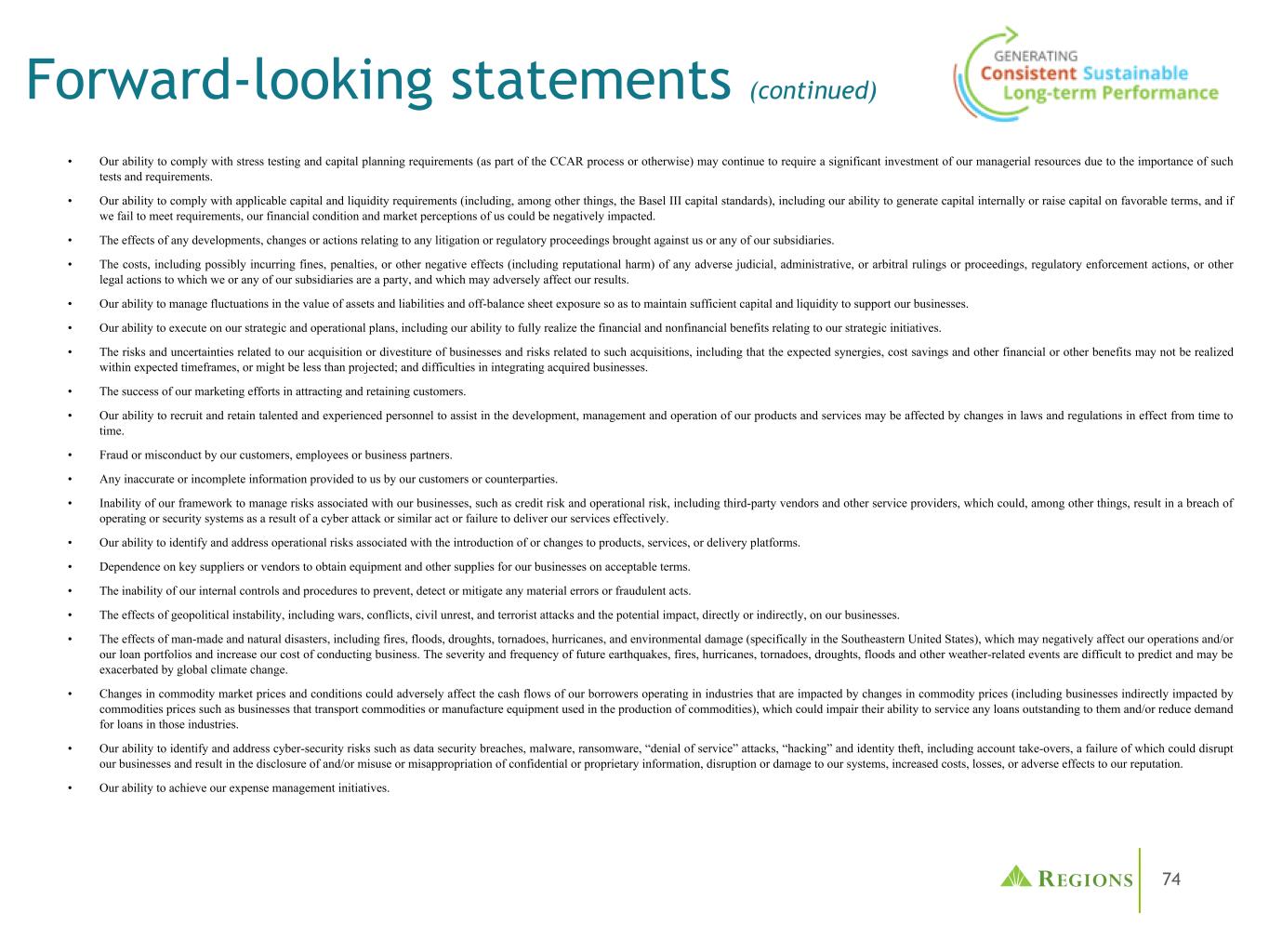
74 • Our ability to comply with stress testing and capital planning requirements (as part of the CCAR process or otherwise) may continue to require a significant investment of our managerial resources due to the importance of such tests and requirements. • Our ability to comply with applicable capital and liquidity requirements (including, among other things, the Basel III capital standards), including our ability to generate capital internally or raise capital on favorable terms, and if we fail to meet requirements, our financial condition and market perceptions of us could be negatively impacted. • The effects of any developments, changes or actions relating to any litigation or regulatory proceedings brought against us or any of our subsidiaries. • The costs, including possibly incurring fines, penalties, or other negative effects (including reputational harm) of any adverse judicial, administrative, or arbitral rulings or proceedings, regulatory enforcement actions, or other legal actions to which we or any of our subsidiaries are a party, and which may adversely affect our results. • Our ability to manage fluctuations in the value of assets and liabilities and off-balance sheet exposure so as to maintain sufficient capital and liquidity to support our businesses. • Our ability to execute on our strategic and operational plans, including our ability to fully realize the financial and nonfinancial benefits relating to our strategic initiatives. • The risks and uncertainties related to our acquisition or divestiture of businesses and risks related to such acquisitions, including that the expected synergies, cost savings and other financial or other benefits may not be realized within expected timeframes, or might be less than projected; and difficulties in integrating acquired businesses. • The success of our marketing efforts in attracting and retaining customers. • Our ability to recruit and retain talented and experienced personnel to assist in the development, management and operation of our products and services may be affected by changes in laws and regulations in effect from time to time. • Fraud or misconduct by our customers, employees or business partners. • Any inaccurate or incomplete information provided to us by our customers or counterparties. • Inability of our framework to manage risks associated with our businesses, such as credit risk and operational risk, including third-party vendors and other service providers, which could, among other things, result in a breach of operating or security systems as a result of a cyber attack or similar act or failure to deliver our services effectively. • Our ability to identify and address operational risks associated with the introduction of or changes to products, services, or delivery platforms. • Dependence on key suppliers or vendors to obtain equipment and other supplies for our businesses on acceptable terms. • The inability of our internal controls and procedures to prevent, detect or mitigate any material errors or fraudulent acts. • The effects of geopolitical instability, including wars, conflicts, civil unrest, and terrorist attacks and the potential impact, directly or indirectly, on our businesses. • The effects of man-made and natural disasters, including fires, floods, droughts, tornadoes, hurricanes, and environmental damage (specifically in the Southeastern United States), which may negatively affect our operations and/or our loan portfolios and increase our cost of conducting business. The severity and frequency of future earthquakes, fires, hurricanes, tornadoes, droughts, floods and other weather-related events are difficult to predict and may be exacerbated by global climate change. • Changes in commodity market prices and conditions could adversely affect the cash flows of our borrowers operating in industries that are impacted by changes in commodity prices (including businesses indirectly impacted by commodities prices such as businesses that transport commodities or manufacture equipment used in the production of commodities), which could impair their ability to service any loans outstanding to them and/or reduce demand for loans in those industries. • Our ability to identify and address cyber-security risks such as data security breaches, malware, ransomware, “denial of service” attacks, “hacking” and identity theft, including account take-overs, a failure of which could disrupt our businesses and result in the disclosure of and/or misuse or misappropriation of confidential or proprietary information, disruption or damage to our systems, increased costs, losses, or adverse effects to our reputation. • Our ability to achieve our expense management initiatives. Forward-looking statements (continued)
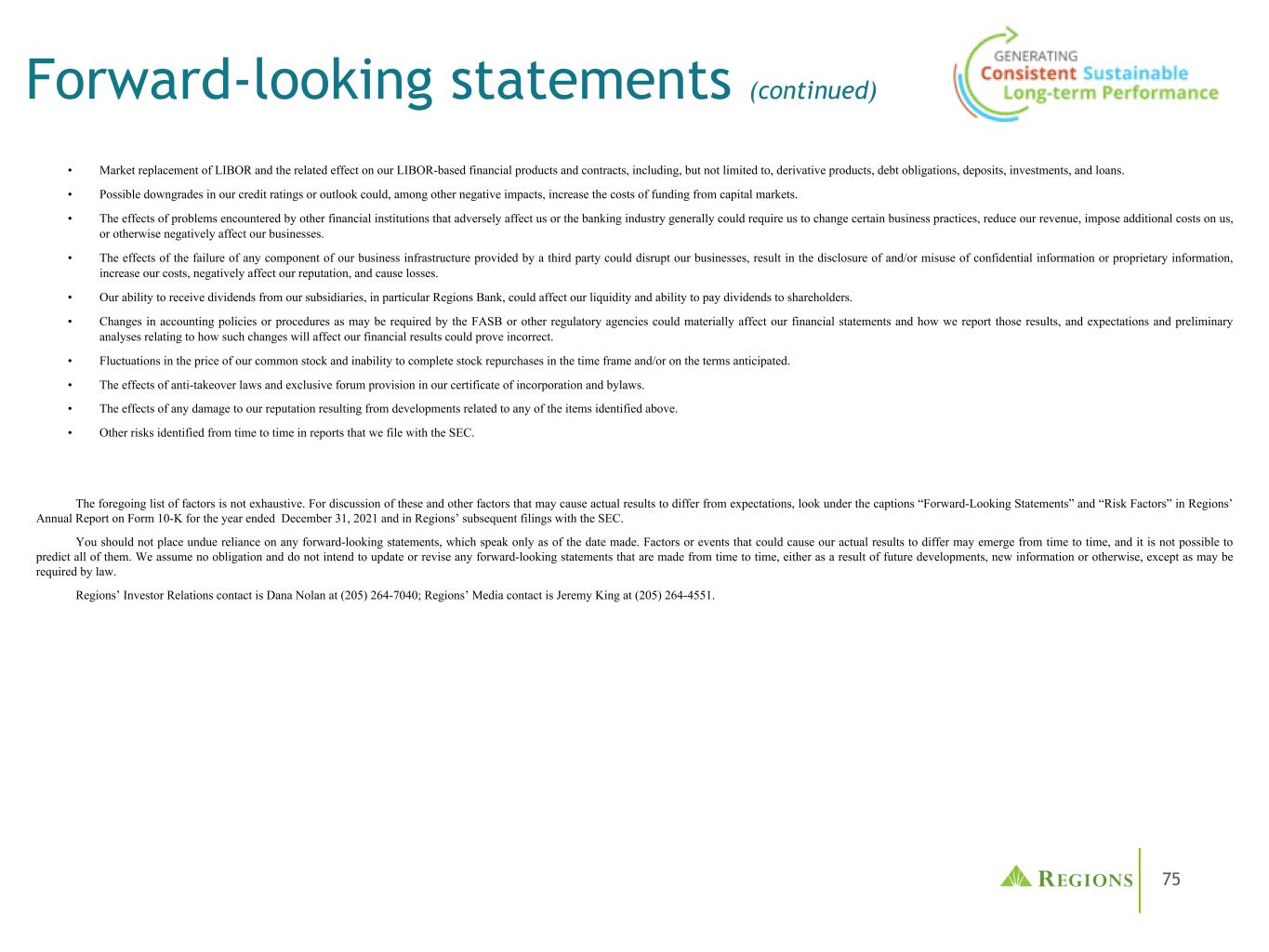
75 • Market replacement of LIBOR and the related effect on our LIBOR-based financial products and contracts, including, but not limited to, derivative products, debt obligations, deposits, investments, and loans. • Possible downgrades in our credit ratings or outlook could, among other negative impacts, increase the costs of funding from capital markets. • The effects of problems encountered by other financial institutions that adversely affect us or the banking industry generally could require us to change certain business practices, reduce our revenue, impose additional costs on us, or otherwise negatively affect our businesses. • The effects of the failure of any component of our business infrastructure provided by a third party could disrupt our businesses, result in the disclosure of and/or misuse of confidential information or proprietary information, increase our costs, negatively affect our reputation, and cause losses. • Our ability to receive dividends from our subsidiaries, in particular Regions Bank, could affect our liquidity and ability to pay dividends to shareholders. • Changes in accounting policies or procedures as may be required by the FASB or other regulatory agencies could materially affect our financial statements and how we report those results, and expectations and preliminary analyses relating to how such changes will affect our financial results could prove incorrect. • Fluctuations in the price of our common stock and inability to complete stock repurchases in the time frame and/or on the terms anticipated. • The effects of anti-takeover laws and exclusive forum provision in our certificate of incorporation and bylaws. • The effects of any damage to our reputation resulting from developments related to any of the items identified above. • Other risks identified from time to time in reports that we file with the SEC. The foregoing list of factors is not exhaustive. For discussion of these and other factors that may cause actual results to differ from expectations, look under the captions “Forward-Looking Statements” and “Risk Factors” in Regions’ Annual Report on Form 10-K for the year ended December 31, 2021 and in Regions’ subsequent filings with the SEC. You should not place undue reliance on any forward-looking statements, which speak only as of the date made. Factors or events that could cause our actual results to differ may emerge from time to time, and it is not possible to predict all of them. We assume no obligation and do not intend to update or revise any forward-looking statements that are made from time to time, either as a result of future developments, new information or otherwise, except as may be required by law. Regions’ Investor Relations contact is Dana Nolan at (205) 264-7040; Regions’ Media contact is Jeremy King at (205) 264-4551. Forward-looking statements (continued)
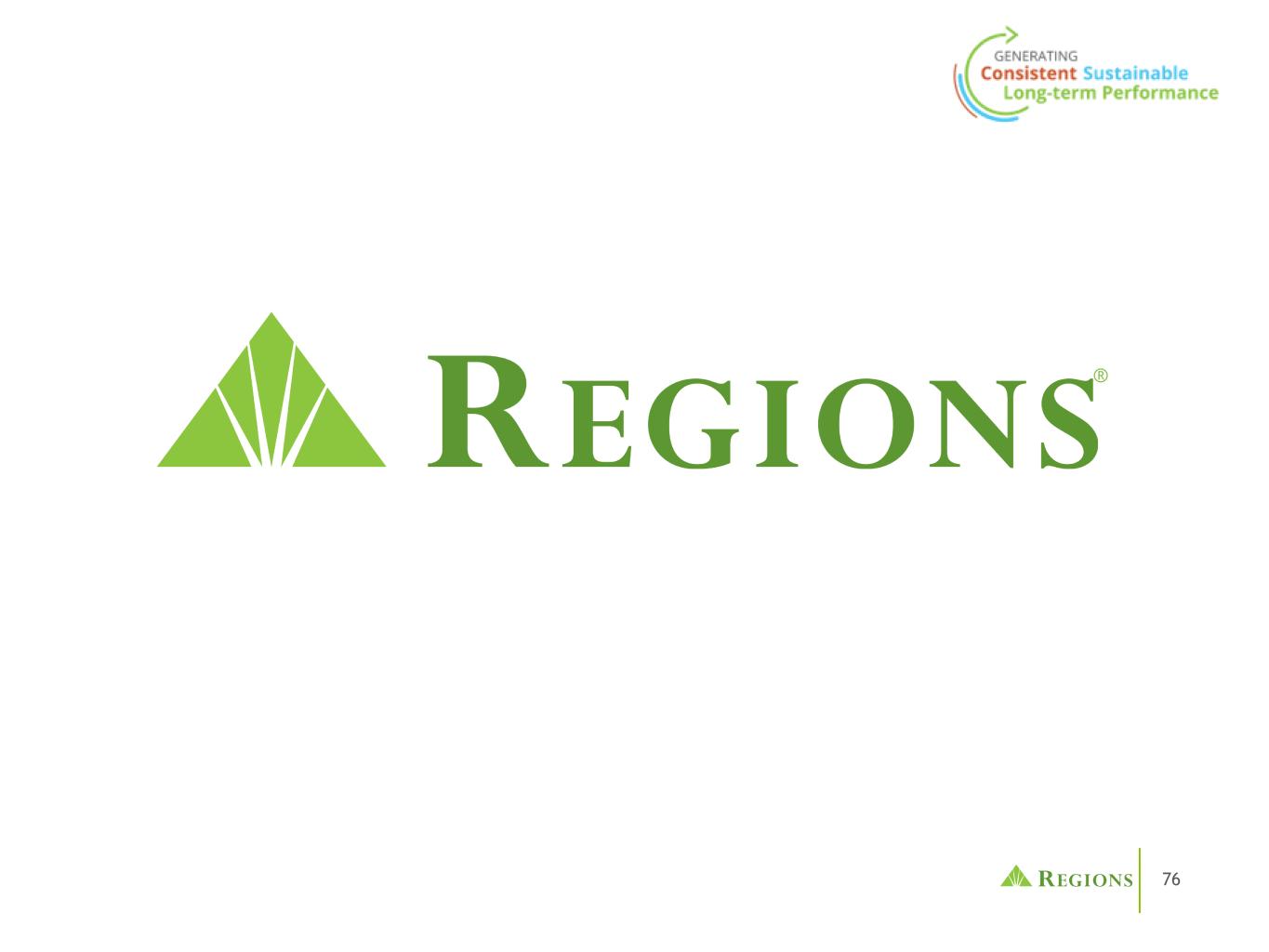
76 ®











































































